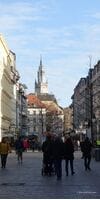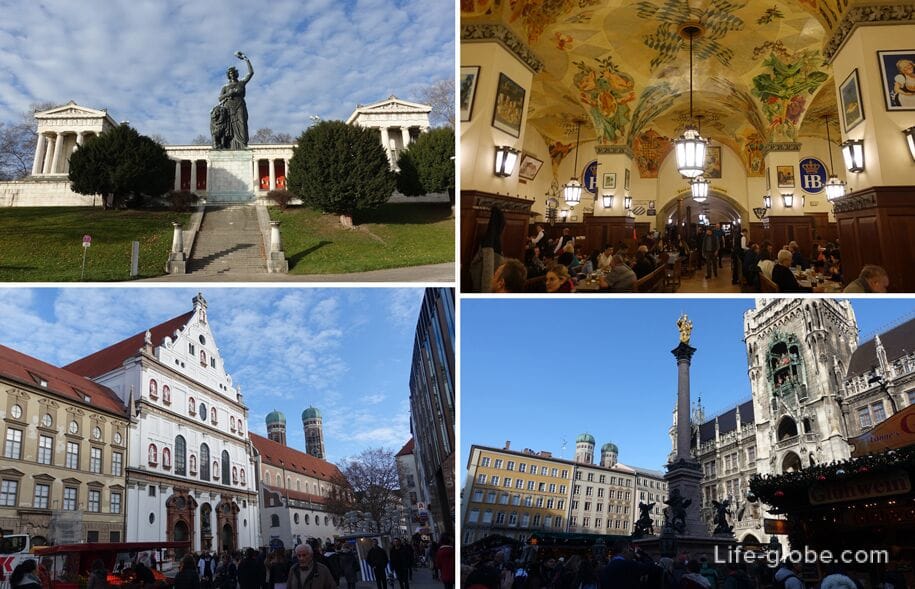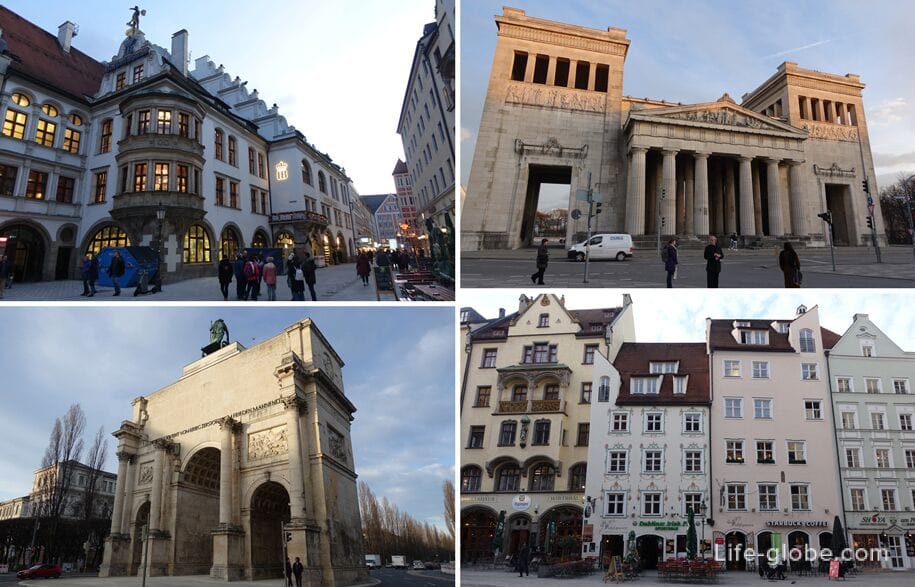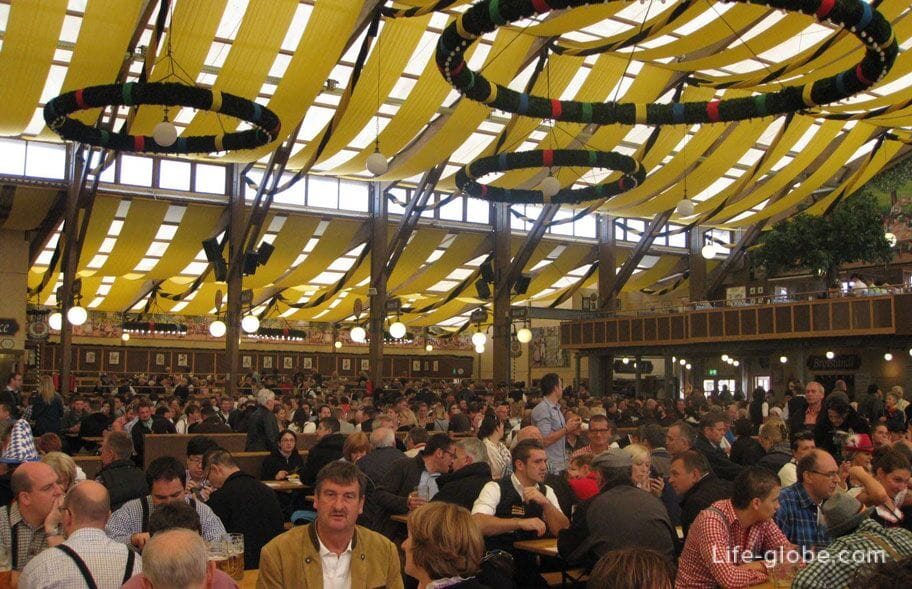Munich (German: München) is a city in Germany on the Isar River, which is the capital and most populous city of Bavaria.
The town was first mentioned in 1158. The city was surrounded by fortifications from the Middle Ages until the end of the 18th century. Today, the historic part of Munich is its heart and was once the historical starting point for the growth of the city.
Much of the city was destroyed during the Second World War. The reconstruction was carried out with the preservation of the monumental buildings that define the city and, in accordance with the historical structure of the city.
Modern Munich is a major industrial, research and financial center of Germany, as well as one of the world's centers of art and culture with a high level and quality of life.
The city has an eclectic mix of historical and modern architecture. In Munich there are places for walking and recreation (coast of the ISAR river, parks and lakes), the historical old town, religious buildings and institutions, the abundance of museums and places of culture, Olympic Park and the home ground of the football team FC Bayern Munich - Allianz arena, as well as various accommodation facilities, shops, boutiques and shopping centers, plenty of pubs, cafes and restaurants.
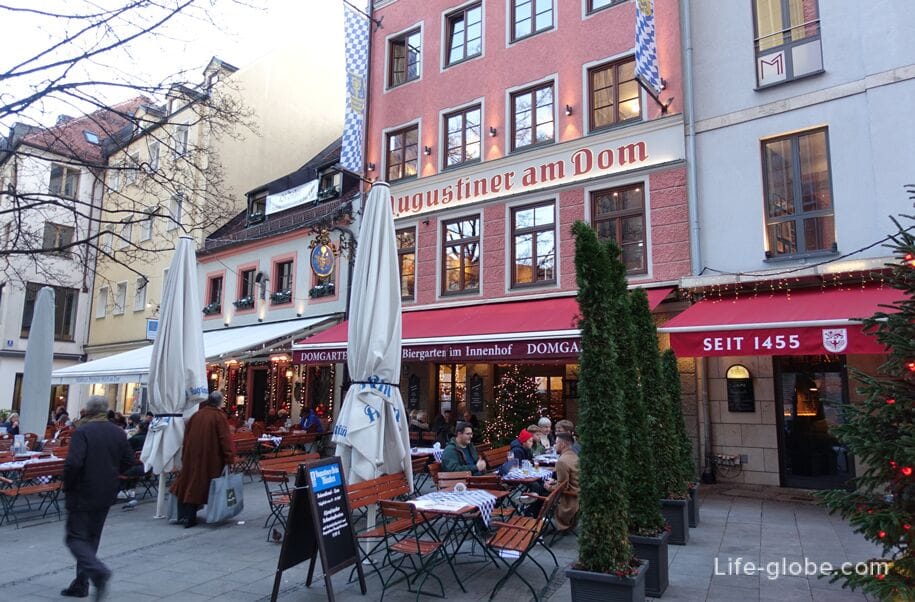
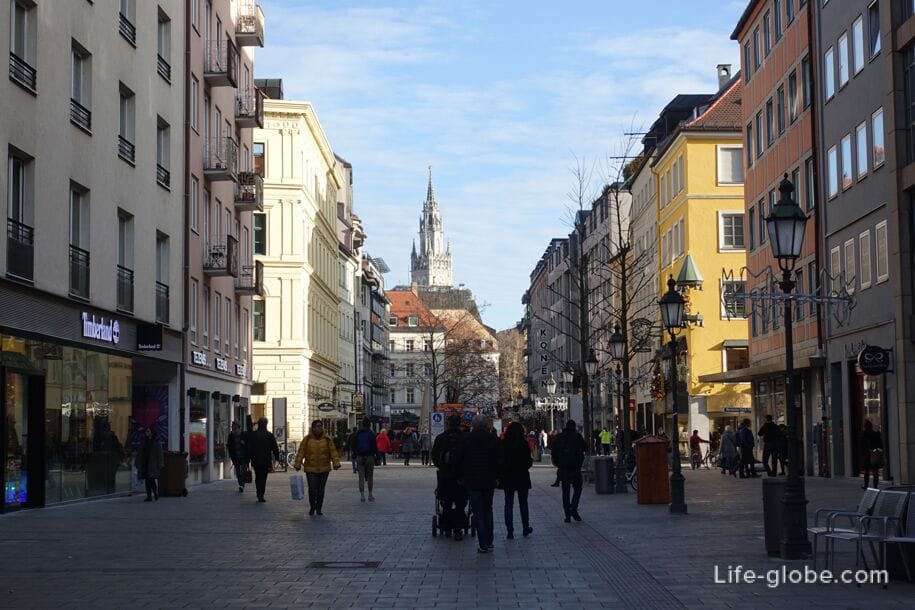
Munich City Center (Old Town)
The center of Munich is its historical center-the Old City (Old city, German name: Altstadt München / Altstadt Munich), which is included in the list of Bavarian historical monuments, is the heart of Munich and a popular place for meetings, walks and recreation, both among local residents and numerous tourists from all over the world.
The central core of the Old City, and of Munich as a whole, is the Marienplatz, which today is a completely pedestrian zone.
The center of Marienplatz is decorated with a high column of Mary (Mariensäule), dedicated to St. Mary as the "patroness of Bavaria". More about Marienplatz…
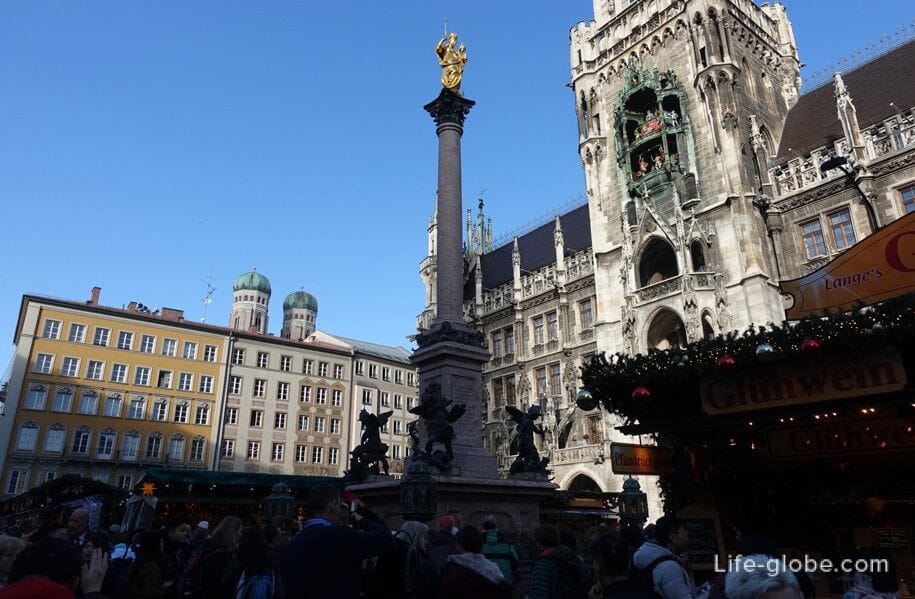
Also on Marienplatz there are two dominant buildings: the Old and the New Town Hall, representing a diverse and unique architectural ensemble.
The New Town Hall (Neues Rathaus) is a neo - Gothic brick and stone building that dominates the square and was built from 1867 to 1909.
Currently, the town hall is a complex of buildings with courtyards and is the residence of the mayor and the headquarters of the Munich City Council. At the top of the Town Hall tower is an observation deck, giving a 360-degree view of Munich. Learn more about the New Town Hall…
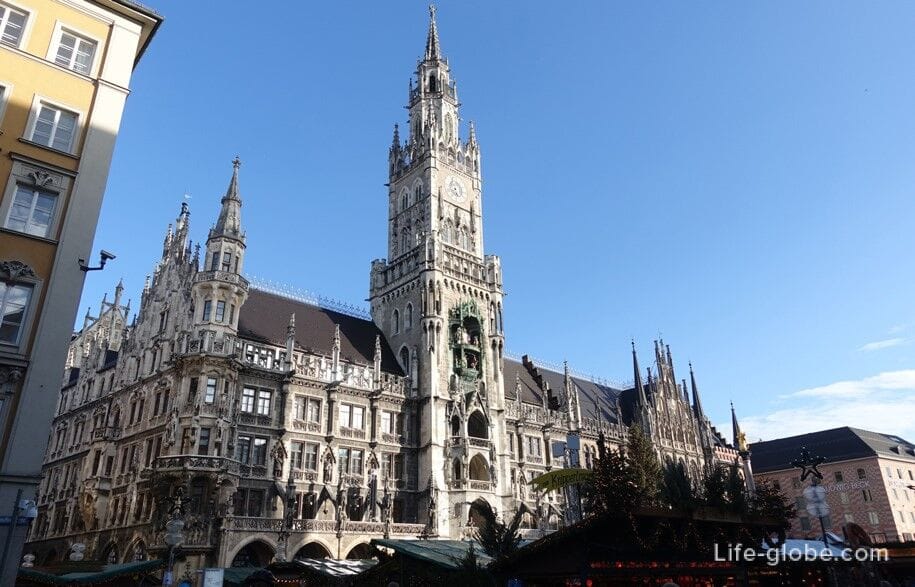
The Old Town Hall (Altes Rathaus) dates back to the 14th century and is the predecessor of the New Town Hall.
The Old Town Hall originated in part from the old Munich city fortifications, which were converted into a 56-meter-high town hall tower.
On the four floors of the Town Hall tower is the Toy Museum (Spielzeugmuseum), whose private collection demonstrates the development of toys over four centuries. Learn more about the Old Town Hall…
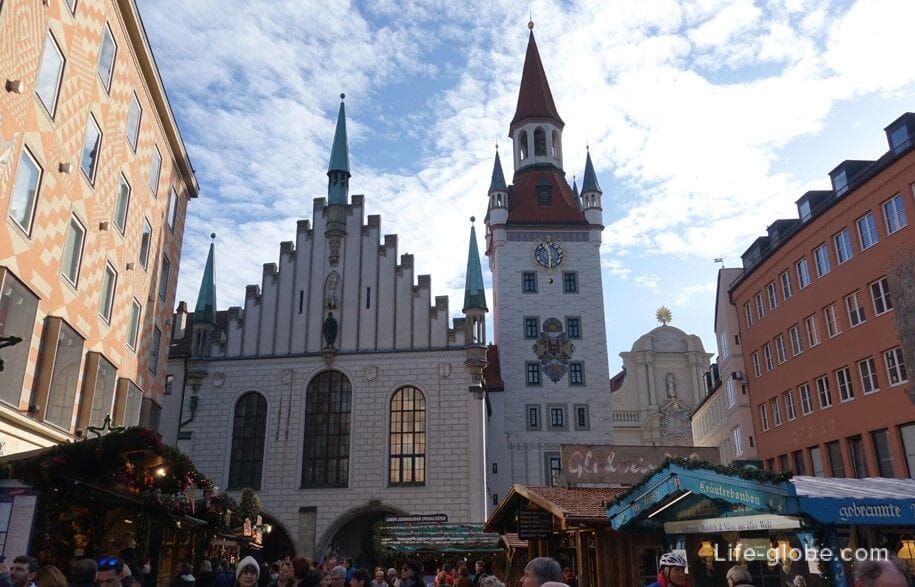
In addition to Marienplatz, there are many attractions and places of interest within the old town, including former royal residences, churches, historical buildings, theaters, museums, observation decks, small squares and pedestrian streets.
The main attractions of Munich's old town include:
- The Old Court (Alter Hof ) is a former ducal castle and the first imperial residence of the rulers of Bavaria, dating back to the 12th century.
Today, the Old Courtyard is publicly accessible and is a complex of buildings with a courtyard;

- The Munich Residenz, which was a luxurious palace and a full-fledged residence of the rulers, and today is one of the most important art museums in Europe.
The residence includes: 10 courtyards, the residence museum, the treasury, the Munich State Coin collection, the Cuvillier Theater, the library, the court Church of All Saints, and the Bavarian Academy of Sciences.
Address: Residence street, 1 (Residenzstraße). Website: residenz-muenchen;
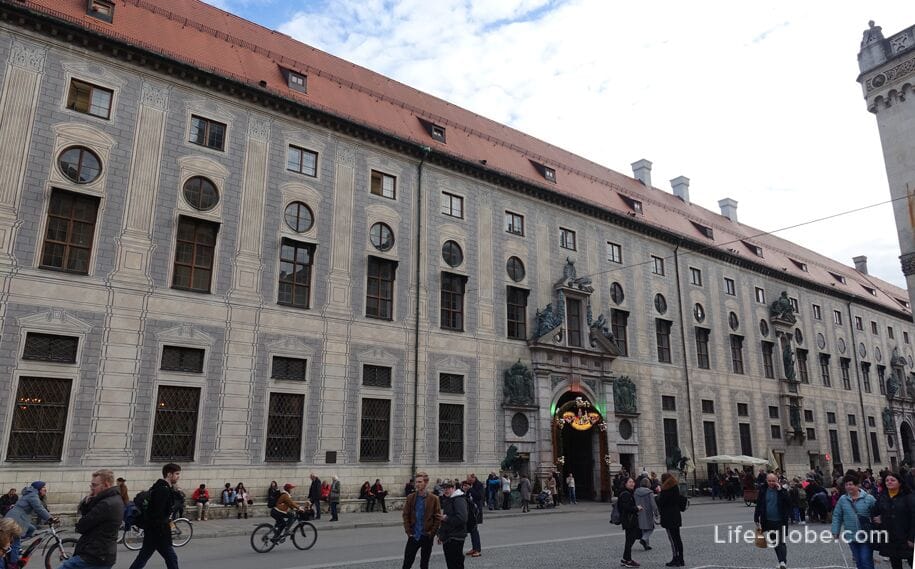
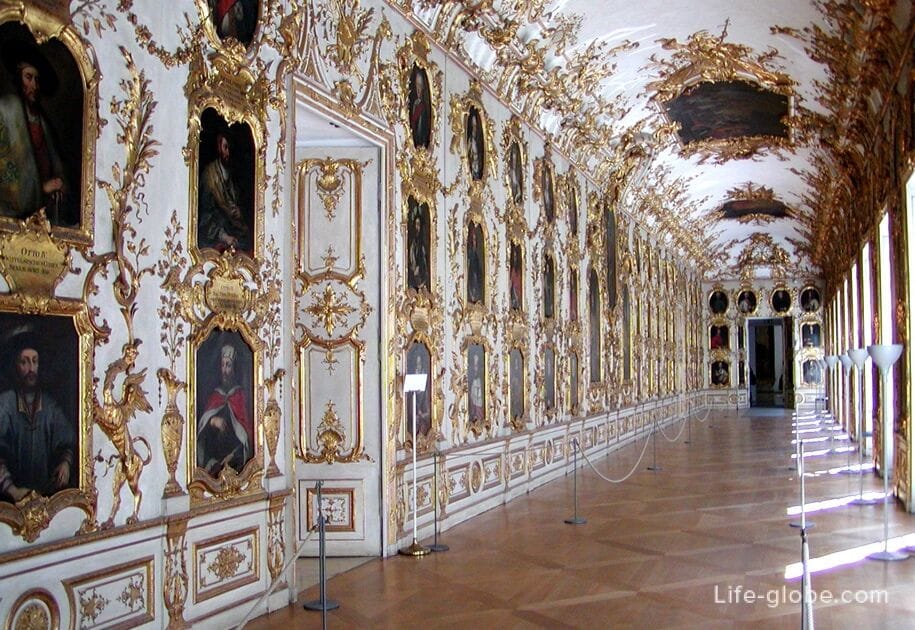
- Hofgarten park, adjacent to the north wing of the Munich residence and which was originally erected as a court garden.
The park is bordered on both sides by arcades. On the eastern side of the park is the Bavarian State Chancellery. The center of the park is decorated with a pavilion (the temple of Diana), created by Heinrich Schon the Elder in 1615.
The main entrance to the park is from Odeonsplatz;
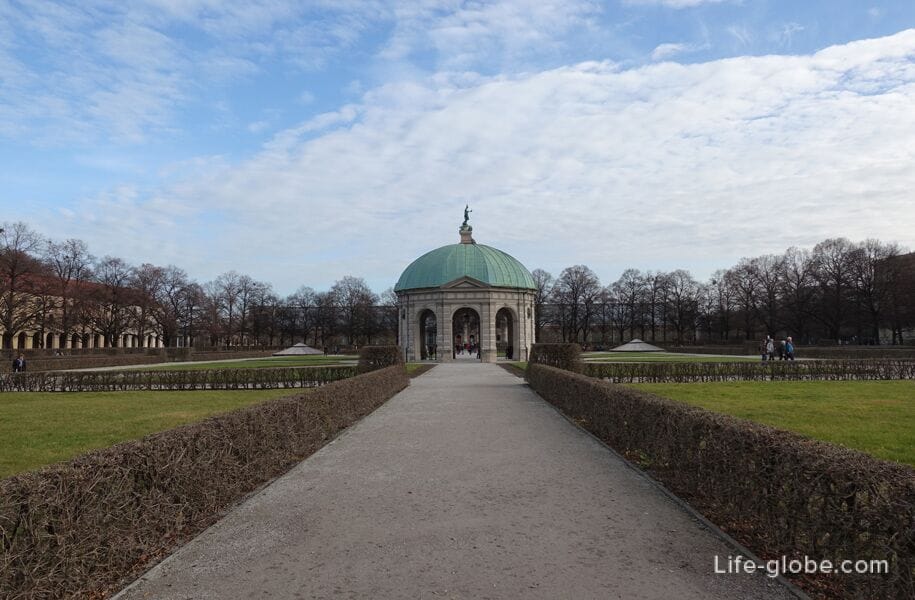
- Frauenkirche - the current cathedral of the Catholic Archdiocese of Munich and Freising, whose history dates back to 1468.
The church building is distinguished by two high towers-bell towers. At the top of the south tower is an observation deck, giving panoramic views of the city and the surrounding area.
In the church there is a sarcophagus made of black marble by Emperor Ludwig IV of Bavaria. There is a legend that the footprint at the entrance to the temple was left by the devil.
Address: Frauenplatz, 12 (Frauenplatz);
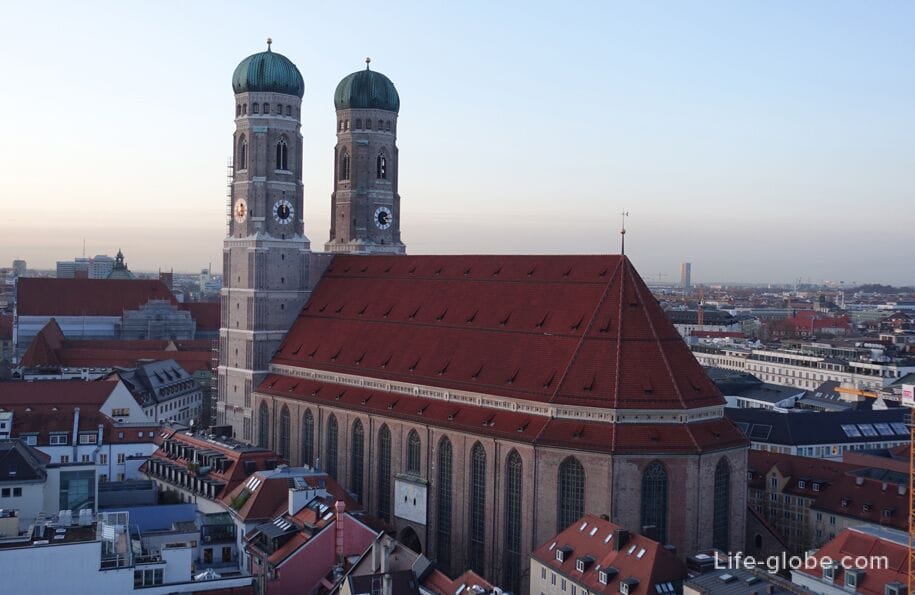
- St. Peter's Church (Peterskirche), also known as "Old Peter" (Peterskirche, Alter Peter) and dating back to the 11th century.
In the walls of the church in a glass sarcophagus are the relics of one of the first Christian martyrs - Saint Munditia of Rome (Saint Munditia), decorated with jewels.
The bell tower of the church has a circular viewing platform that offers panoramic views, including the Marienplatz square, the old town and the surrounding area.
Address: Rindermarkt, 1 (Rindermarkt);
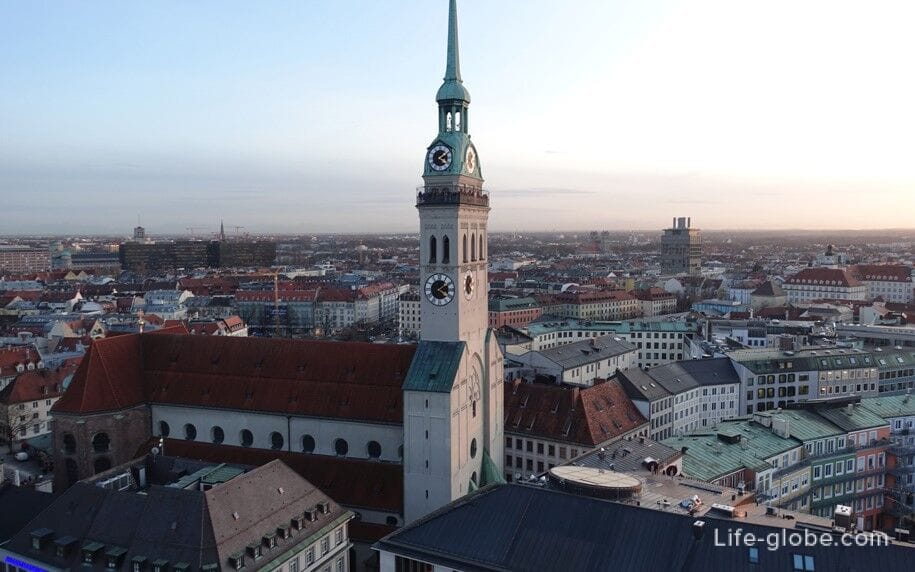
- Azamkirche and the Azam brothers' house (Asamhaus), together representing an architectural ensemble and a masterpiece of the late Baroque, built by the Azam brothers since 1733.
Address: Sendlinger Starsse, 32 and 34 (Sendlinger Str.);

- The Church of St. Michael (Jesuitenkirche St. Michael), considered the largest and first Renaissance church north of the Alps.
The church was built by Duke William V of Bavaria between 1583-1597.
The exterior of the church, due to the gable main facade and triangular front, looks more like an old medieval town hall than a shrine.
The interior of the church is decorated in light colors and impresses with golden altars and a pulpit. The main high altar is located in the apse and with the figure of the Savior. Deep choirs abut the mighty nave.
In the church crypt is the tomb of a relative of Napoleon I-Eugene de Beauharnais, and the tombs of members of the Wittelsbach dynasty, including Maximilian I, William V, King Ludwig II of Bavaria, etc.
Address: Neuhauser Strasse 6 (Neuhauser Straße);
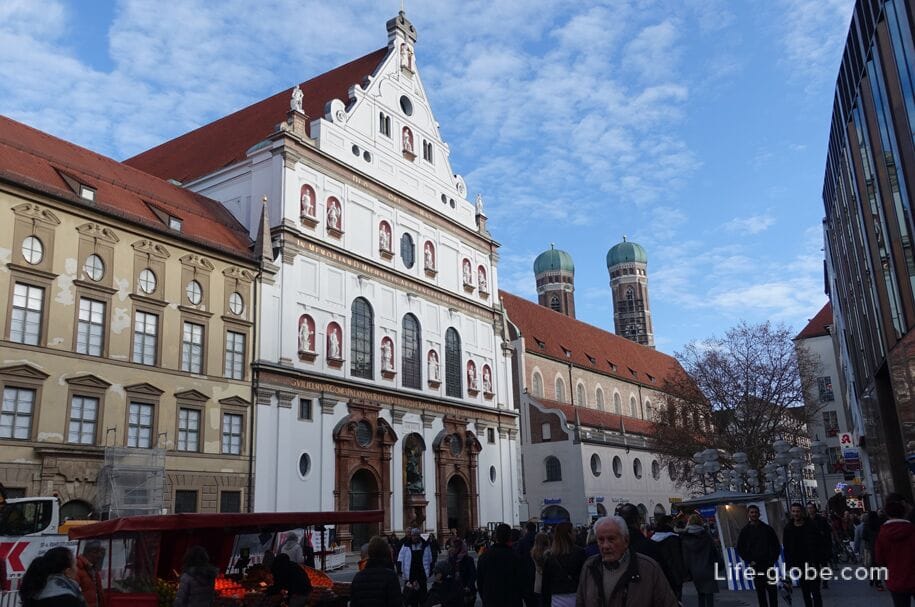
- The Hofbräuhaus is one of the oldest beer restaurants in Munich, which was founded as a court brewery in 1589.
At the beginning of the 20th century, the Hofbroyhaus became one of the most popular places for recreation and meetings of citizens.
Currently, the Hofbroyhaus functions as a beer restaurant with a beer garden and is known not only in Munich, but also outside the city.
Address: 9 Platzl Square (Platzl). Website: hofbraeuhaus;
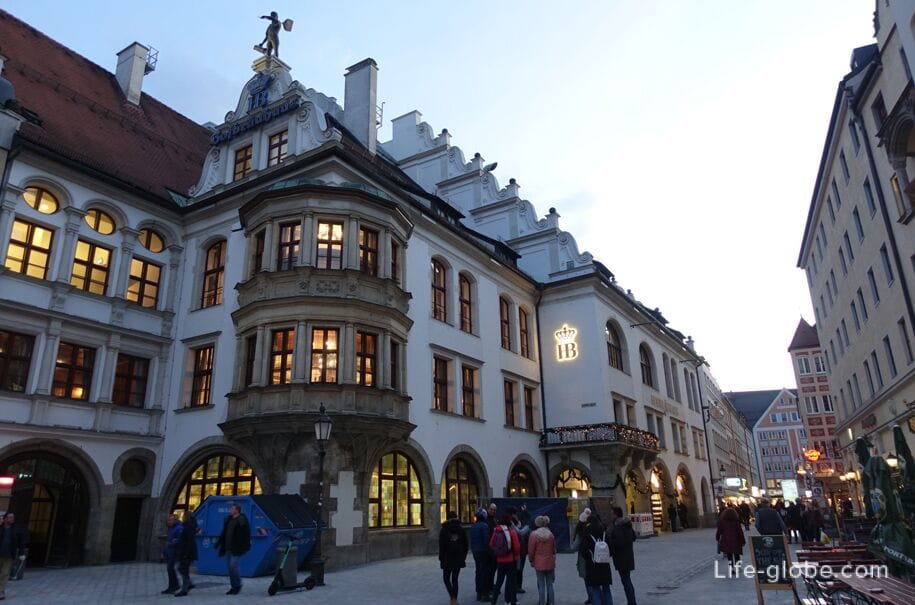
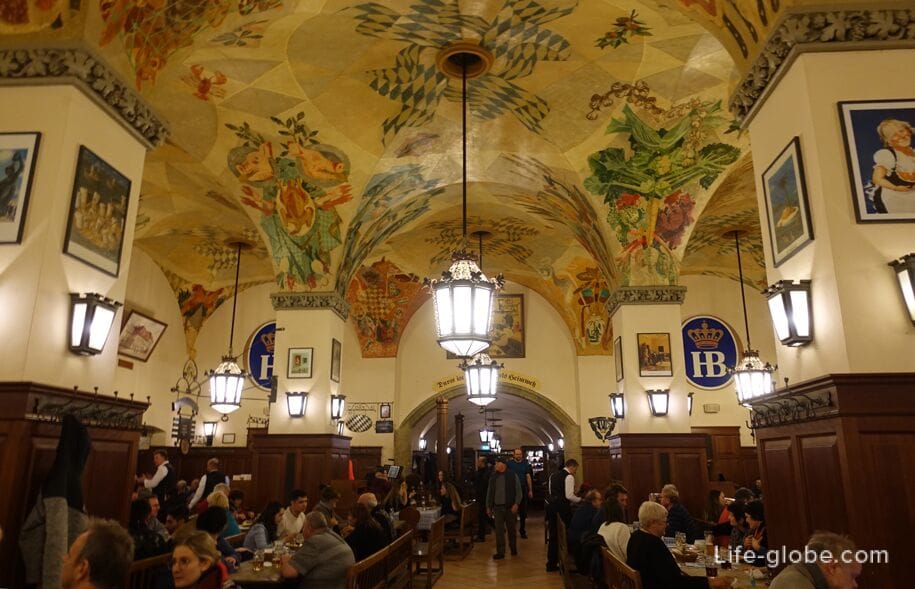
- the city gates and the remains of the fortifications that once surrounded Munich, the most interesting of which are:
- Sendlinger Tor (Sendlinger Tor), located on the square of the same name, in the southern part of the old town, and having a large central arch, two flanking towers with arched passages and part of the inner wall,
- The Karlstor, which marks the western border of the historic old town of Munich, consists of two small pseudo-Gothic towers connected by a bridge. Portals (passageways) in the gate are made in the form of three high pointed arches,
- Isar Gate (Isartor), located on the eastern edge of the old city of Munich, at: 50 Tal street and consisting of: a rectangular clock tower and a trapezoidal courtyard, which is accessed by arched passages. The courtyard itself is surrounded by walls, with two octagonal side towers with arched openings (passageways);
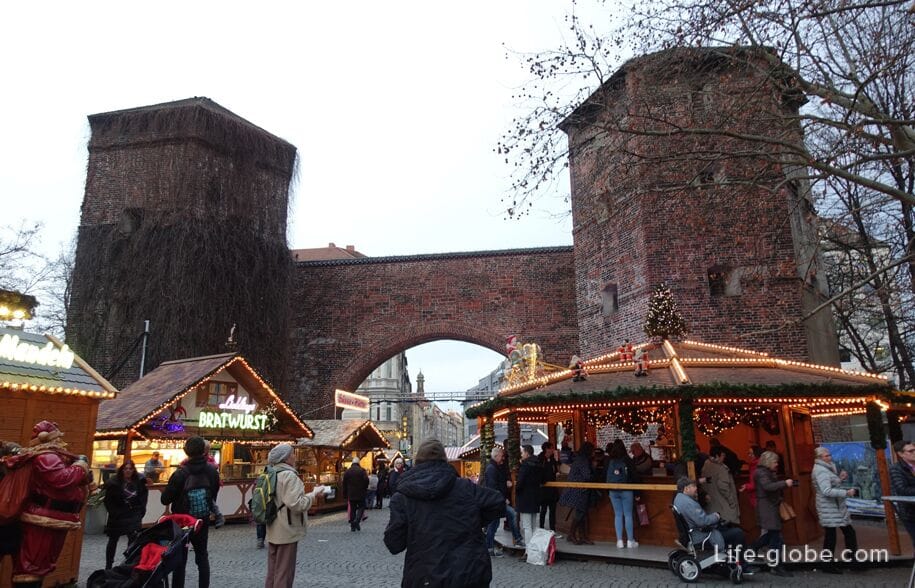
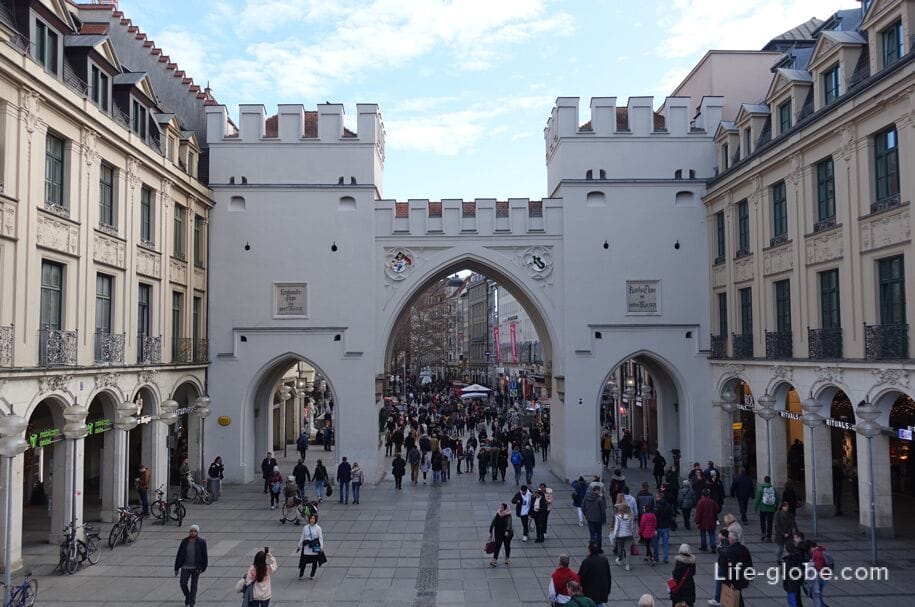

- Odeonsplatz square, built under King Maximilian I of Bavaria on the site of the city wall destroyed in 1791.
The Odeonsplatz is notable for:
- Feldhernhalle - the so-called "Hall of the Bavarian generals", made in the form of a loggia,
- St. Cajetan's Theatre Church (Theatinerkirche St. Kajetan), which was the court, cathedral, and order church of the Theatines,
- Moy Palace, Ludwig I Monument, commercial Bazaar building, former Odeon Concert Hall and Leuchtenberg Palace;
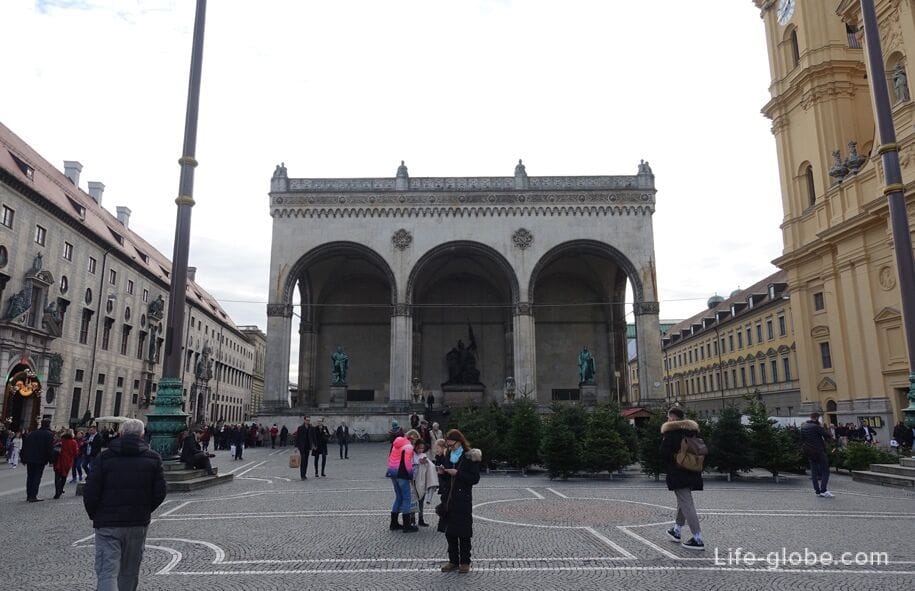
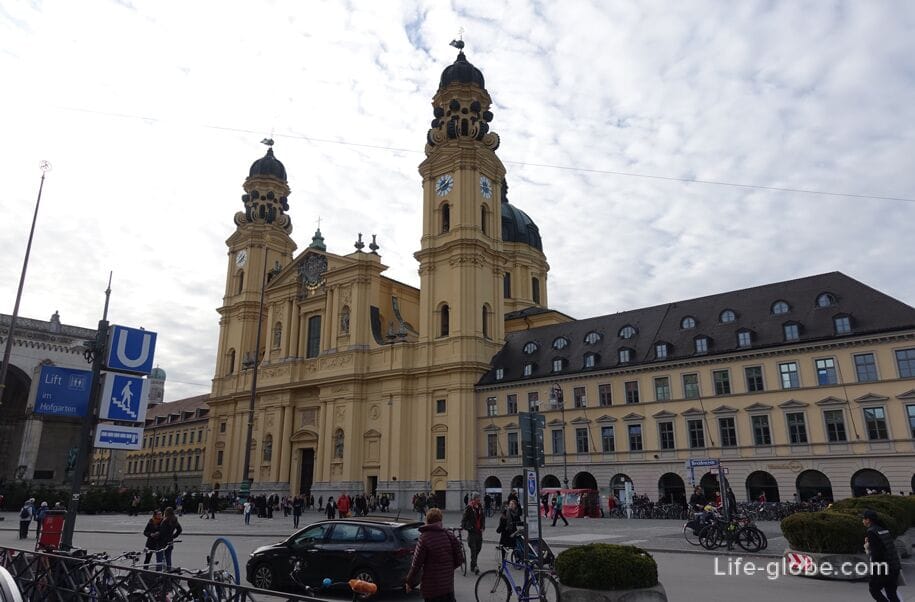
- Max Joseph Square (Max-Joseph-Platz), created in the early 19th century and named after the King of Bavaria - Maximilian I Joseph.
The center of the square is decorated with a monument to King Maximilian I, and around the square are concentrated such important objects of Munich as:
- The National Theater ( Nationaltheater) is an opera house whose history dates back to 1811 and whose main appearance is formed by a wide staircase, a portico with eight Corinthian columns and a triangular two-level pediment with statues and paintings,
- the Residenz Theatre is a historic court theatre that was known as the Cuvillies-Theatre and was built in the immediate vicinity of the Munich Residence in 1751-1753,
- Palais Toerring-Jettenbach, built in the 18th century in the Rococo style;
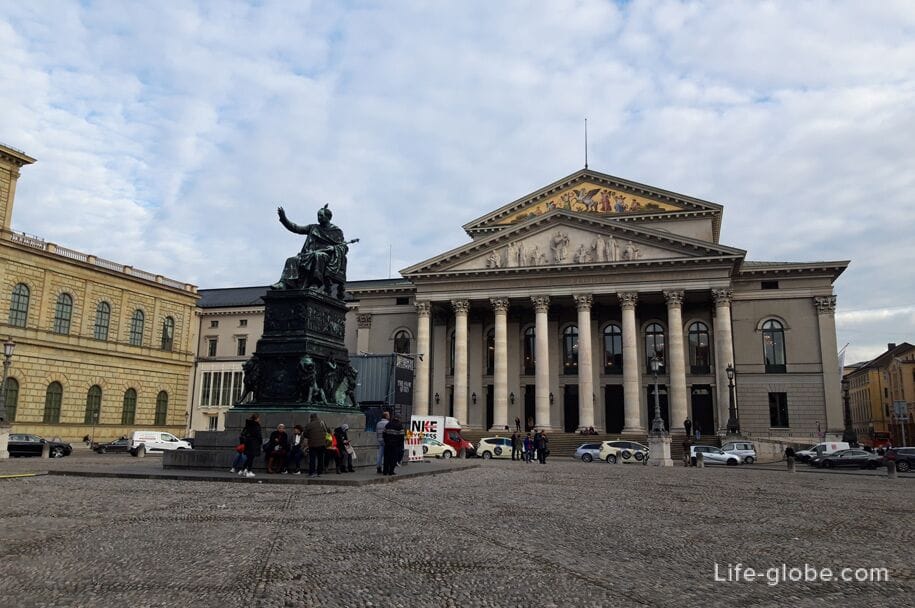
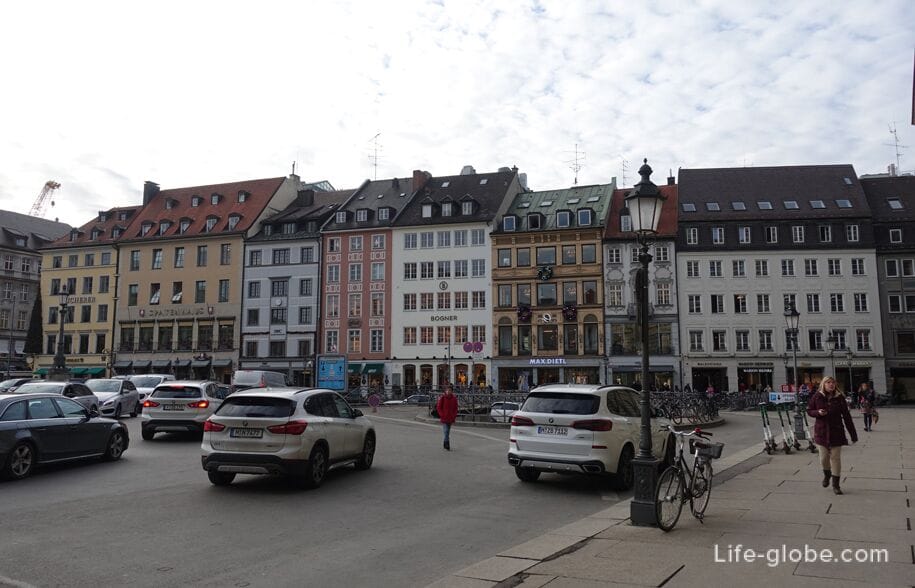
-St. James' Square (Sankt-Jakobs-Platz), which is restricted from vehicle traffic. On the square there are:
- recreation areas and a fountain;
- the Jewish Center complex is an architectural ensemble consisting of three independent buildings located close to each other: the new Ohel Jacob Synagogue, the Munich Jewish Museum, and the community center of the Jewish cultural community of Munich and Upper Bavaria;
- Munich City Museum (Münchner Stadtmuseum) with the Museum of the History of Cinema (Filmmuseum);
- historic houses and the Church of St. Jakob am Anger (Kath. Kirche St. Jakob am Anger), dating back to the 13th century;

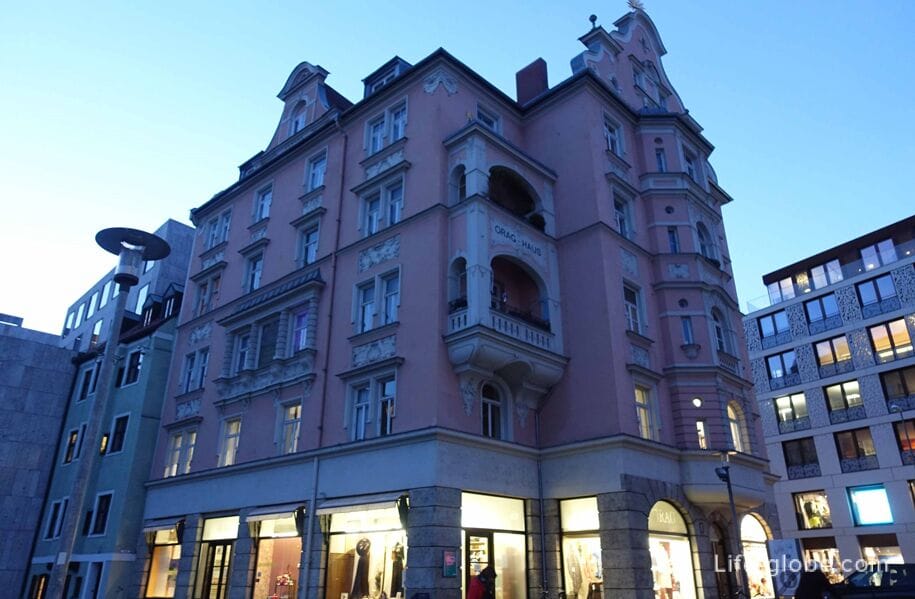
- Karlsplatz, marks the western border of Munich's historic old town.
The dominant feature of the square is the Charles Gate. Also on the square is: a fountain, a department store and a shopping center. In the winter season, from about mid-November to mid-January, the square has an open-air ice rink;
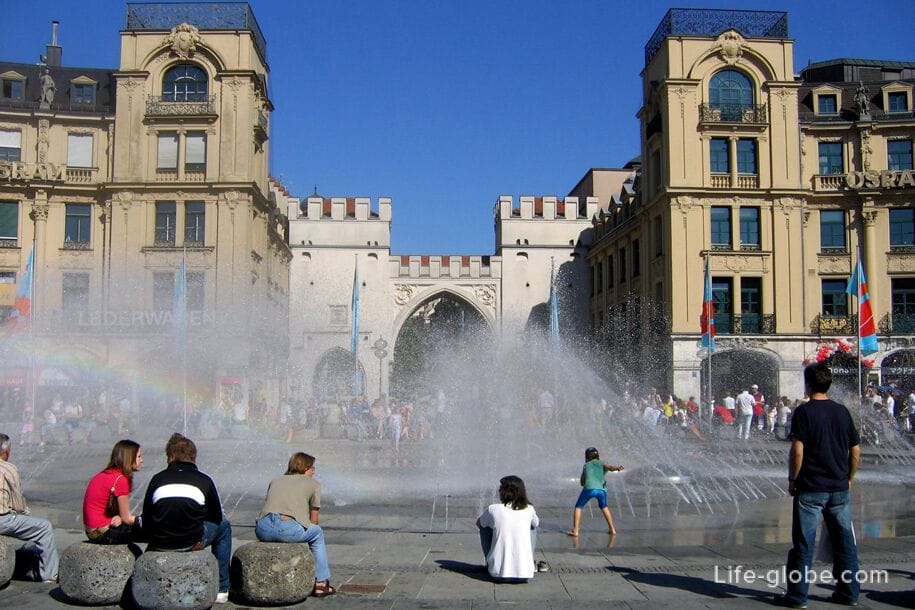
- Wittelsbach Fountain (Wittelsbacher Brunnen), built in 1893-1895 in the classical style and is considered the most beautiful fountain in Munich.
The motif of the fountain is an allegory of the natural forces of water. Thanks to its restrained, clear and at the same time refined design, as well as from the point of view of urban planning, the fountain is one of the most artistically perfect structures in Munich.
The fountain is located on the border of the squares Lenbach (Lenbachplatz) and Maximilians (Maximiliansplatz);
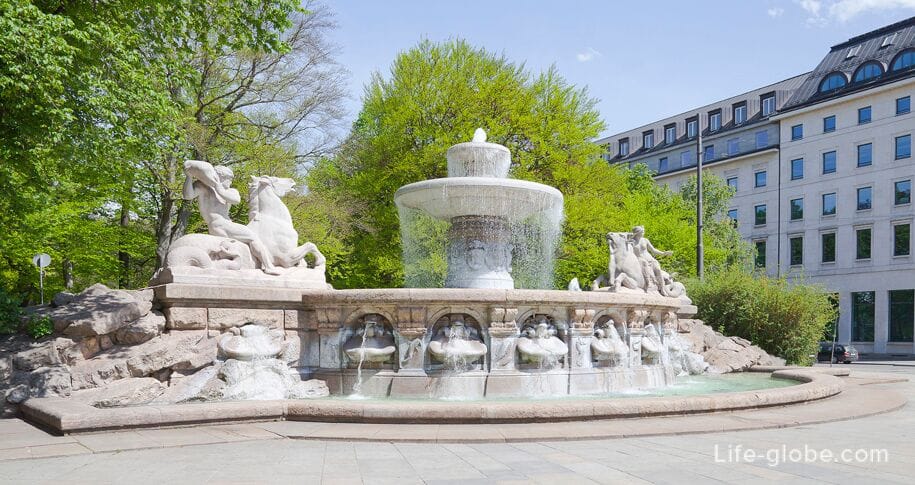
- Viktualienmarkt - an open-air market that operates all year round (from Monday to Saturday, except public holidays, from 8: 00 to 20: 00 hours).
On the market is the beer garden "Biergarten Am Viktualienmarkt", which, although not the largest in Munich, is certainly the most central.
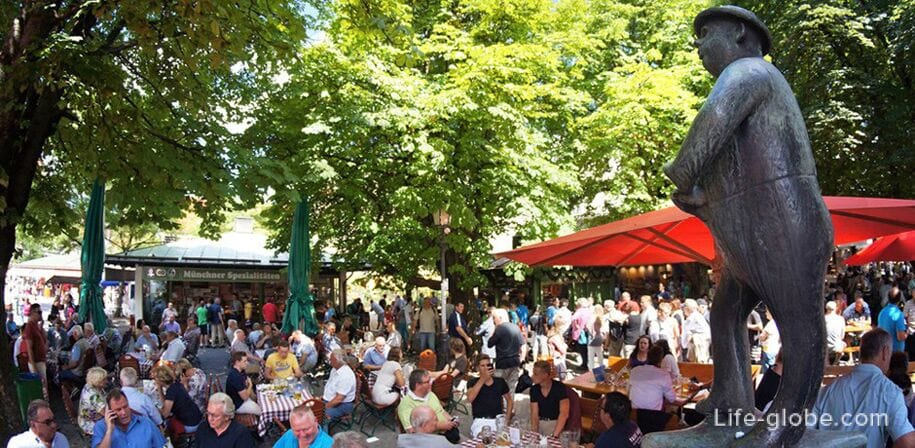
Within the old town there are streets, the most interesting and visited of which are: Rindermarkt; Sendlinger Strasse (Sendlinger Straße); Residenzstraße, Burgstrasse, Cardinal Faulhaber Street (Kardinal-Faulhaber-Straße); Kaufingerstrasse and Neuhauser Strasse (Kaufingerstraße, Neuhauser Straße). Learn more about Munich's old town…
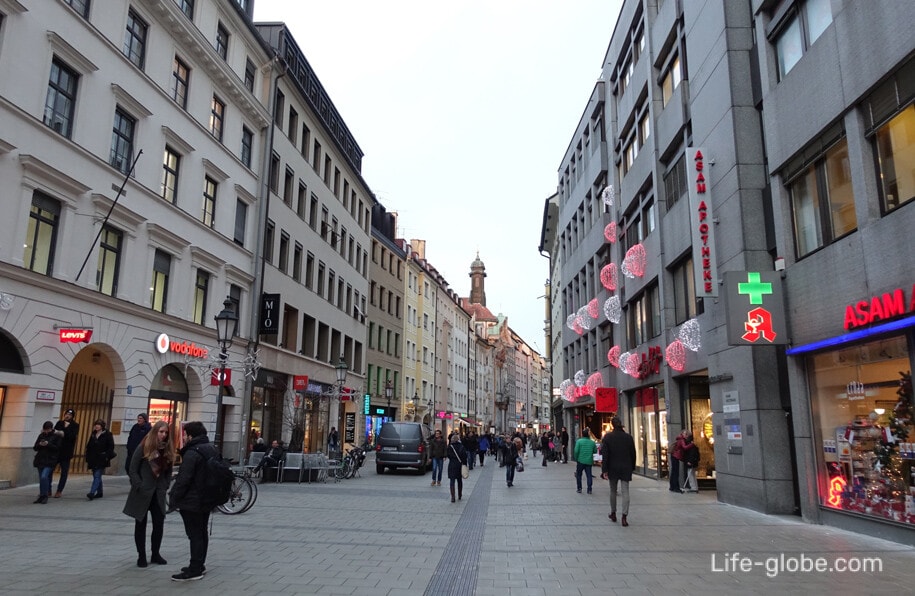
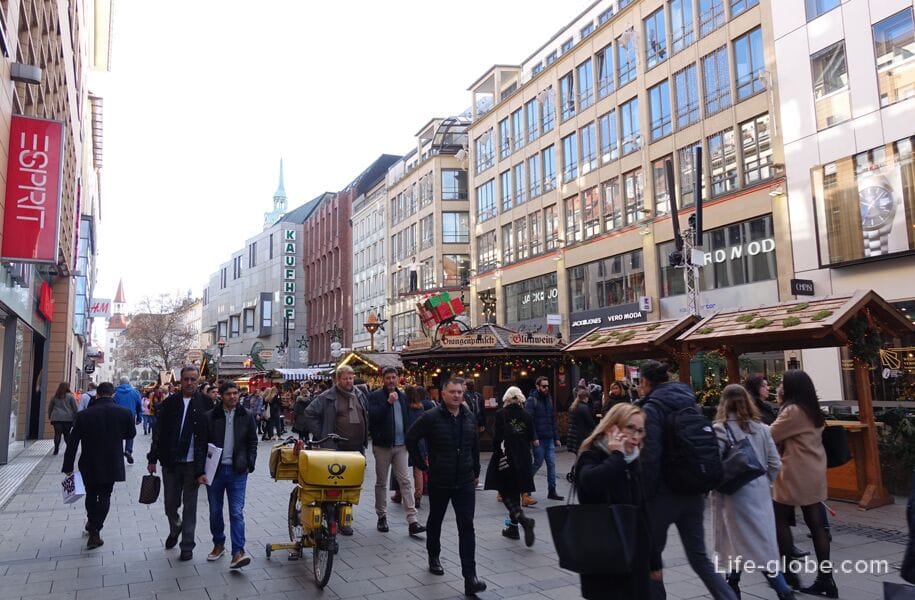
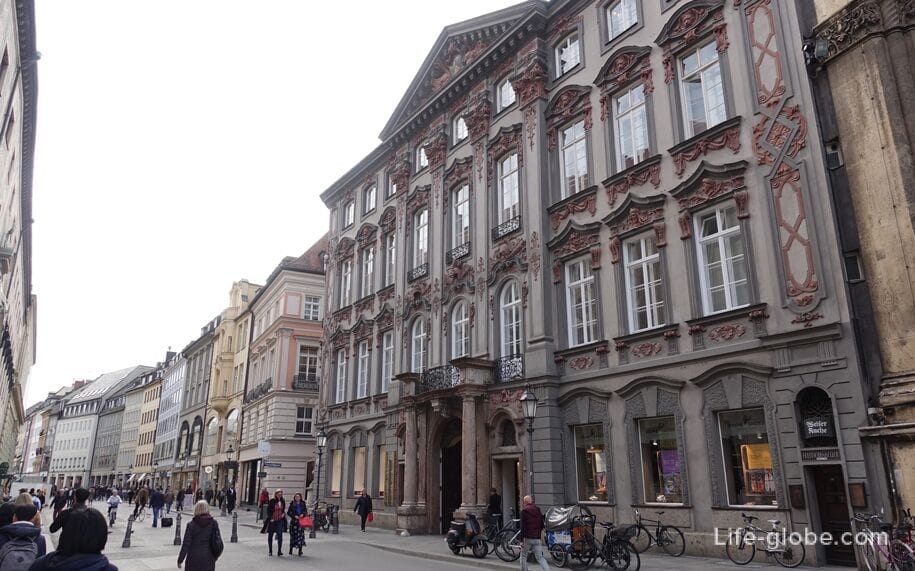
Top attractions outside of Munich's Old Town
Nymphenburg Palace
Schloss Nymphenburg (Schloss Nymphenburg) is a palace complex, which is one of the most majestic royal palaces in Europe.
The palace was built starting in 1664, and for many years served as the main summer residence of the rulers of Bavaria from the Wittelsbach dynasty.
Some of the halls and rooms of the palace still display their original Baroque decorations.
The palace complex also includes two museums: the Carriage Museum (Marstallmuseum) and the Porcelain Museum (Porzellanmuseum).
Adjacent to the palace is the Schlosspark Nymphenburg, which contains: a central canal with a" Grand Cascade " - a Baroque waterfall; fountains; alleys and walking paths; statues and sculptures; two lakes and the Apollo-Tempel monopter-a rotunda temple built in 1862-1865.
For a fee, you can visit several pavilions - palaces in miniature in the park.
Address: Schloß Nymphenburg, 1. Nymphenburg Palacewebsite : schloss-nymphenburg. More about the Nymphenburg Palace and the park…

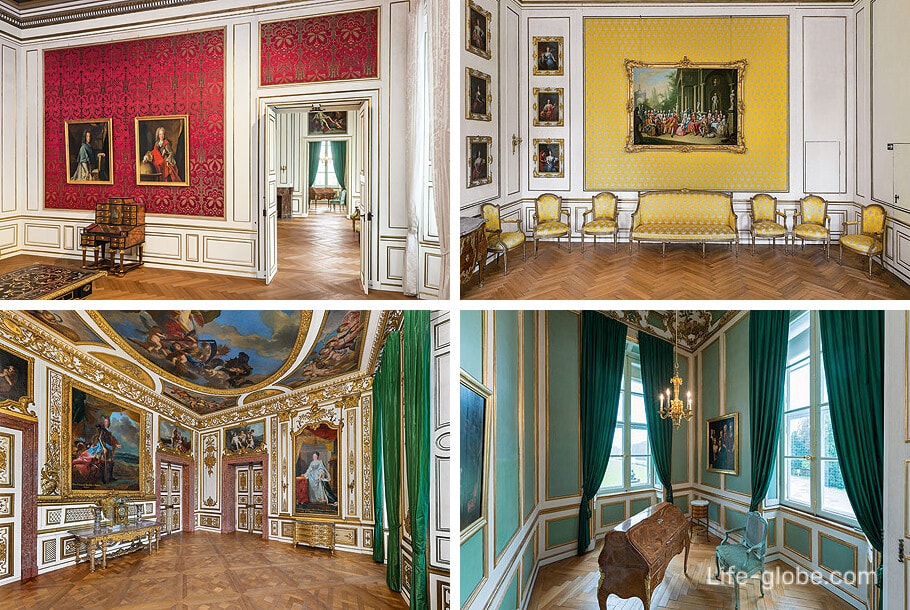
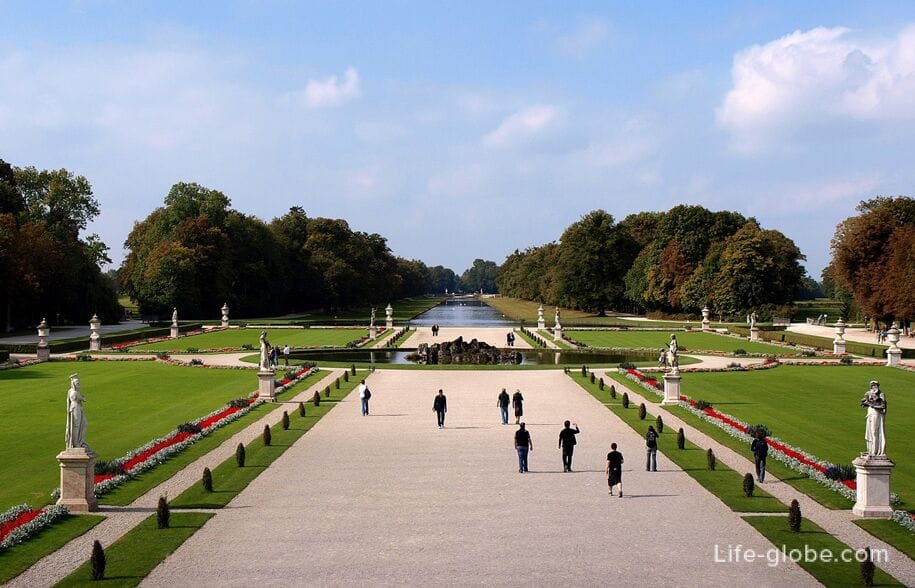
Blutenburg Castle
Schloss Blutenburg (Schloss Blutenburg) appeared on the site of fortifications that existed in the 13th century, as an old ducal house.
The castle was built for Duke Albrecht III of Bavaria in 1438-1439 as a hunting lodge, replacing the old castle that burned down during the war.
Today, the castle remains: a residential tower, part of the ring wall with towers, some rooms and the palace chapel-a late Gothic masterpiece, which preserves stained glass windows, a cycle of statues of the apostles from 1490-1495, and altars with three paintings created in 1491 by Jan Polak.
Throughout the year, the castle and the surrounding area host festivals, festivals and other events, including the Christmas market.
Address: Seldweg, 15 (Seldweg). Website: blutenburg.
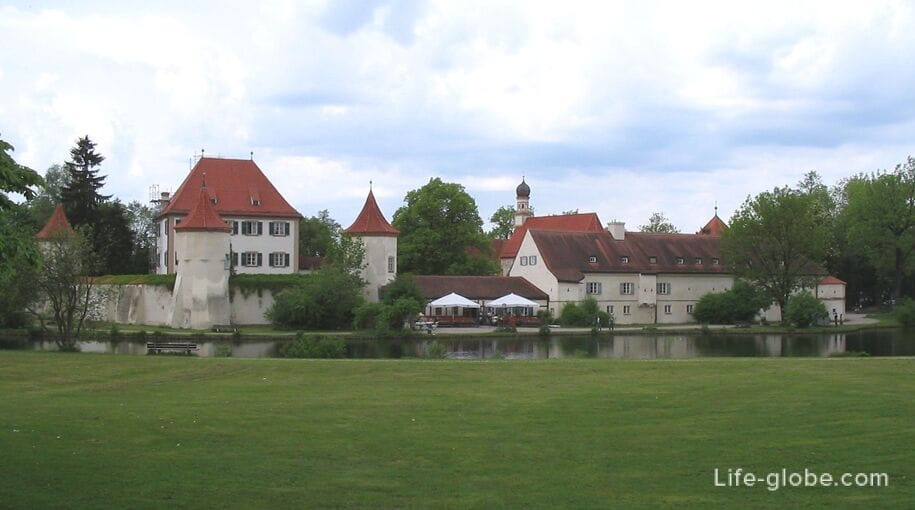
Royal Avenues
In the 19th century, Munich was built four royal avenues that led from the city center.
The Royal Avenues are now important city boulevards located in the center of Munich and along which there are, among other things, museums, former palaces, magnificent buildings and squares.
Royal Avenues:
- Brienner Strasse, built in neoclassical style since 1812;
- Ludwigstrasse, built on the initiative of King Ludwig I of Bavaria (and named after him), since 1816 as the "great" street representing the Kingdom of Bavaria;
- Maximilianstrasse is one of the most expensive streets in Germany with high retail rents. The construction of the avenue began in the 1850s by decree of King Maximilian II of Bavaria, after whom the street was named;
- Prinzregentenstrasse (Prinzregentenstraße) was built, starting in 1891, as a main street for the middle class by order of the Prince Regent of Bavaria, Luitpold, and is named after him.
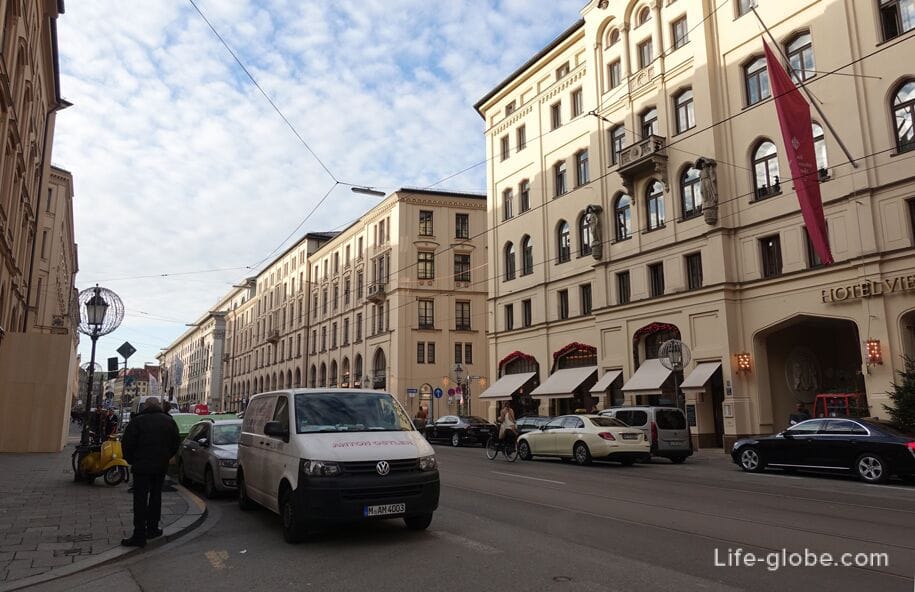

St. Luke's Church
The Church of St. Luke (St. Lukas), also called Lukaskirche (Lukaskirche) - the largest Protestant church in Munich, which is the only almost completely preserved Lutheran church in the historical part of the city.
The shrine was erected in 1893-1896.
Today, this majestic and, without a doubt, architecturally refined building stands on the banks of the River Isar and attracts attention mainly with its Romanesque features, two tall towers and a large dome.
The interior of the church is based on the early Gothic style.
Address: Mariannenplatz, 3. More about St. Luke's Church…
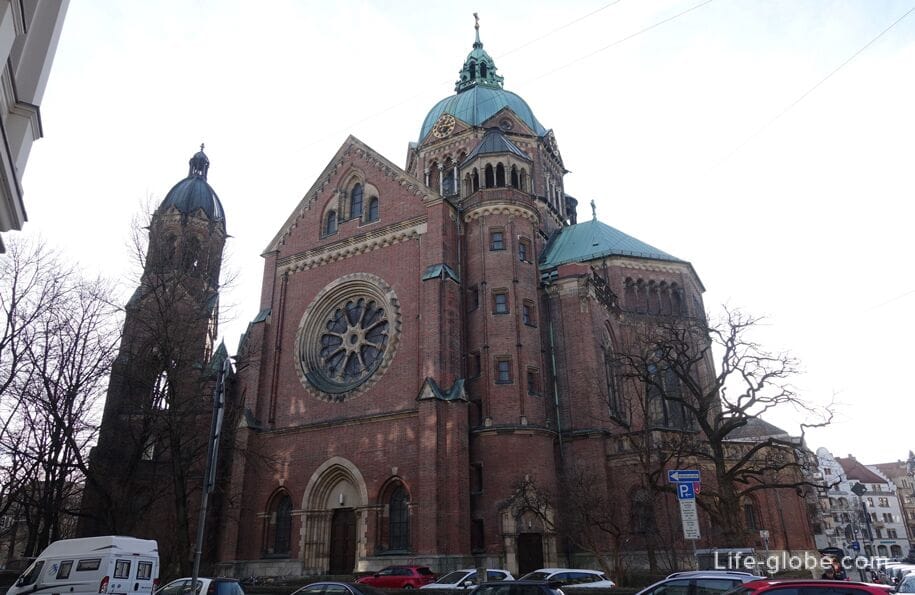
Wittelsbach Square
Wittelsbach Square (Wittelsbacherplatz) is the most beautiful classicist square in Munich.
The square received its current name in 1827, when it was named after one of the oldest noble families - the Wittelsbachs.
The center of the square is decorated with a bronze equestrian statue of Elector Maximilian I, and around the square are concentrated historical buildings, including former palaces. Learn more about Wittelsbach Square…

Royal Square
The Royal Square (Königsplatz) was created in the style of European neoclassicism in the 19th century by the German court architect Leo von Klenze by decree of Crown Prince Ludwig I of Bavaria as a "Place of Culture".
On the Royal Square there are:
- Propylaea (Propyläen) - a historical monument, which is a former gate (front passage), erected in 1862;
- museums: Glyptotheca and the State Antique Collection. Learn more about the Royal Square…
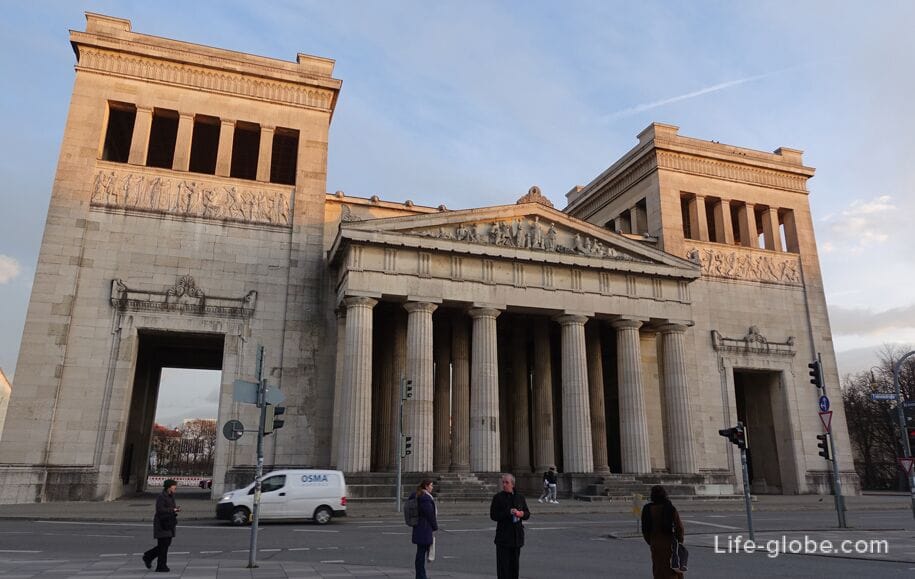
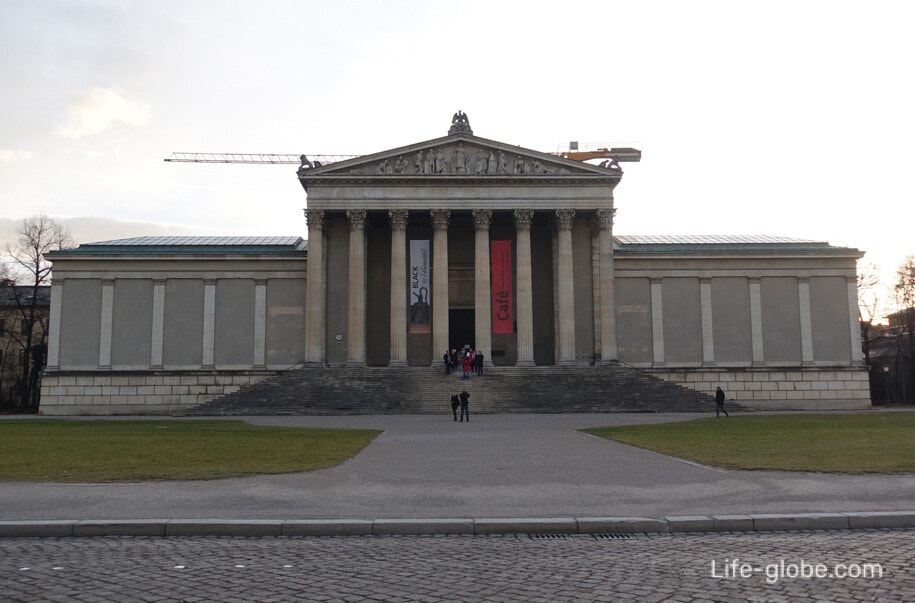
Vienna Square
Vienna Square (Wiener Platz) is a small and colorful historical square.
On the square, from 1889 to the present day, there is a small permanent food market. The market in the square is open every day except Sunday.
Also notable on the square are the historic buildings, the Hofbräukeller restaurant with a beer garden, the Maypole and the Fischerbuberl-Brunnen fountain, in the upper central part of which a naked boy in a panama hat is depicted standing on a ball and holding a fish in each hand. Learn more about Vienna Square…
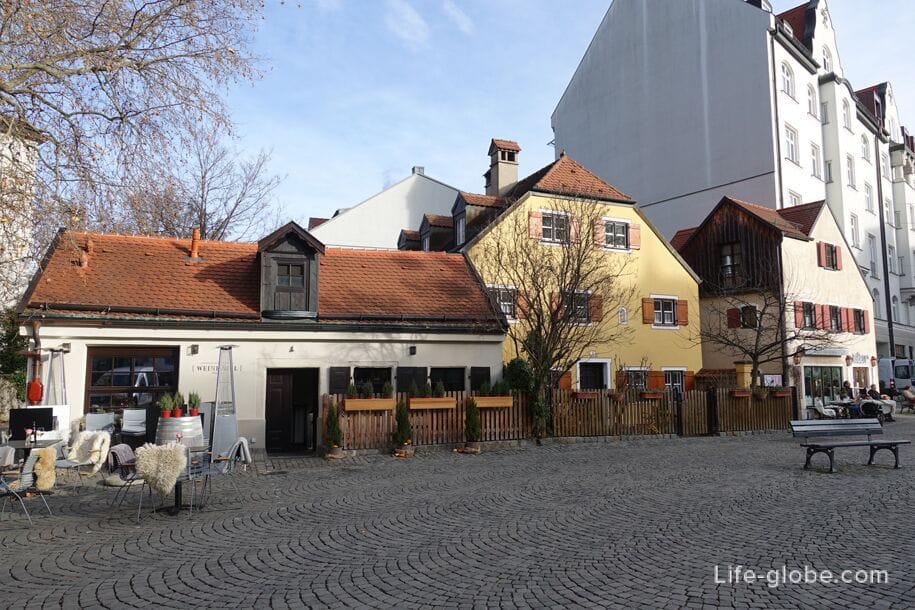
View of the Viennese Square and the Church of St. John the Baptist (in the center in the background)
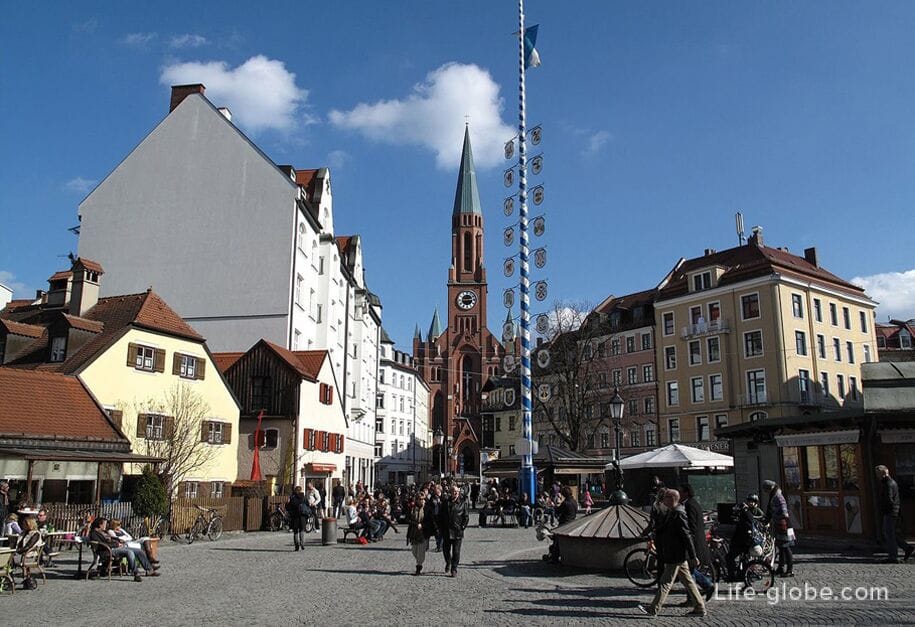
Gertner Square
Gertner Round Square (Gärtnerplatz) was built around 1860 and named after the German architect Friedrich von Gärtner.
In 1865, the Staatstheater am Gärtnerplatz theater was built in the southern part of the square in the late classical style, which still forms the appearance of the square.
In the center of Gertner Square are: the Schalenbrunnen fountain, a monument to the architect Leo von Klenze (1784-1864), flower beds and places to relax.
In the buildings around the square there are retail premises, cafes and restaurants.
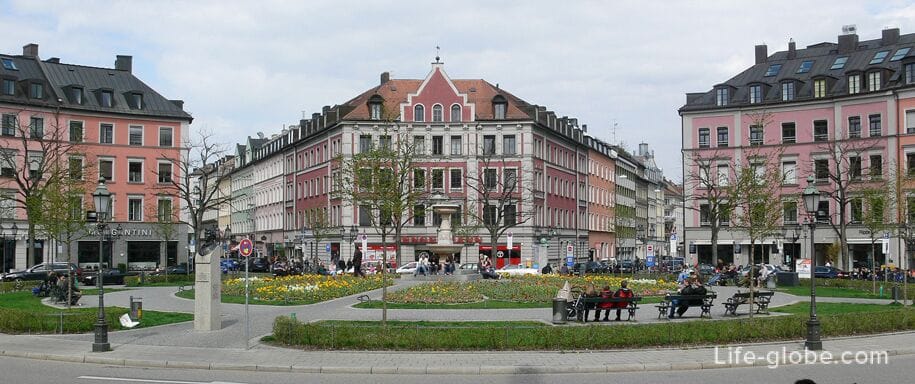
Richard-Wagner-Strasse
Richard-Wagner-Straße (Richard-Wagner - Straße) is a street with a length of about 300 meters and was built in 1897.
The street is named after the composer Richard Wagner, who lived in the area in 1864-1865, at37 Brienner Strasse.
The street houses were built between 1899 and 1906, mostly by architect Leochard Romeis. In the design of the street, the architect applied various architectural periods, taking into account the taste of late historicism, in order to create the impression of a" historical " street.
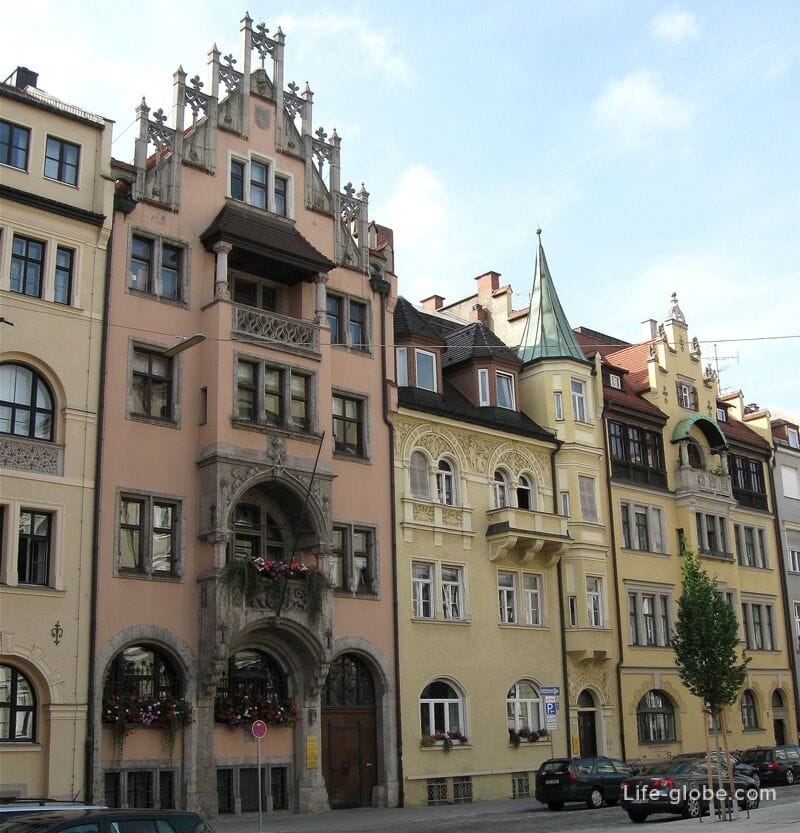
Leel
Lehel or Lehel (Lehel) - a historical quarter, which today is part of the district Altstadt-Lehel (Altstadt-Lehel) and is located to the northeast of the old town of Munich.
In the quarter, some of the houses built in the neo-Baroque or Neo-Renaissance style have been preserved. Many Munich residents even say that this is the most beautiful quarter in the Bavarian capital.
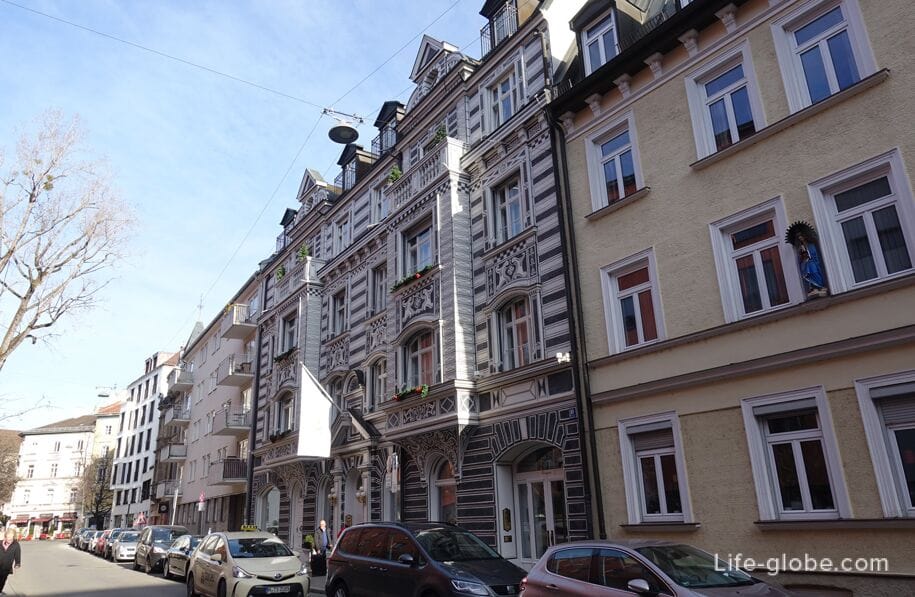
The center of the quarter is defined by St. Anna's Square (St.-Anna-Platz), created in the late 19th century as part of the construction of the new parish church of St. Anna (Pfarrkirche St. Anna), which is considered one of the best examples of historicism in Munich.
Inside the church, the apse fresco above the main altar, created by the German artist and craftsman Rudolf von Seitz, is noteworthy.

Across St. Anna Street (St.-Anna-Straße), from the church of St. Anna, is the eponymous monastery church of St. Anna (Klosterkirche St. Anna), which is the first church built in the Rococo style in Old Bavaria and which shaped the development of sacred architecture in Bavaria.
The construction of the church began in 1727 as a sign of gratitude for the birth of the heir to the Bavarian crown, Maximilian III.
The church is notablefor its frescoes, main altar, pulpit, and organ. Learn more about Altstadt-Leel…

Villas in Neuhausen-Nymphenburg
Near the Nymphenburg Palace, in the city district of Neuhausen-Nymphenburg, there are some historic villas and Art Nouveau buildings.
They deserve special attention:
- The former district of Gern, located northeast of the Nymphenburg Canal, between the streets of Waisenhausstrasse (Waisenhausstraße), Klugstarsse (Klugstraße) and Gerner starsse (Gerner Straße).
The first middle-class Art Nouveau mansion in the area was built in 1892;
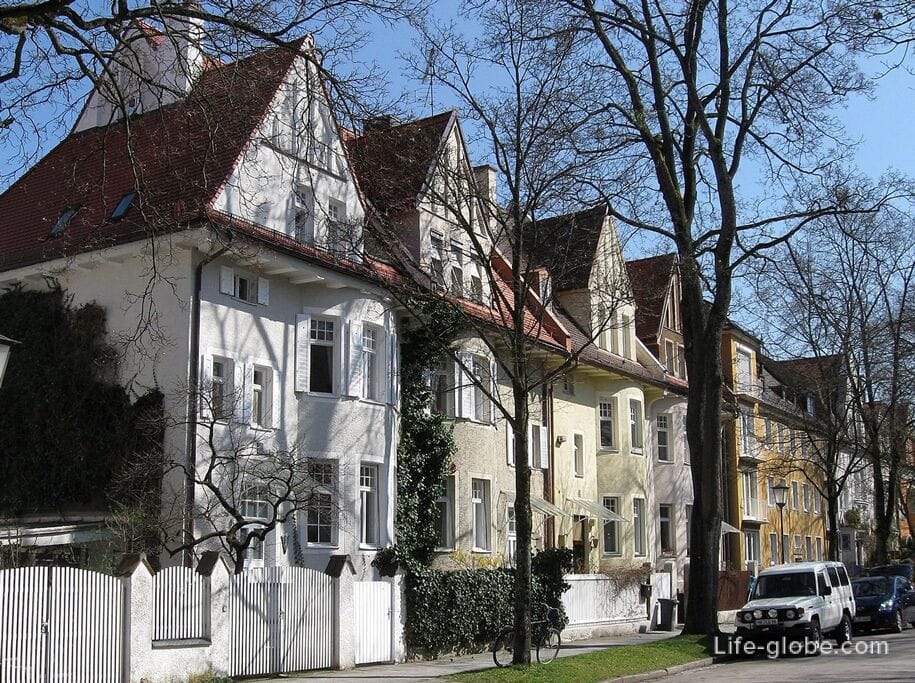
- the so-called "villa colony Neuwittelsbach" (Villenkolonie Neuwittelsbach), which is located south of the Nymphenburg Canal and is considered an outstanding, uniformly designed quarter of villas of the late 19th and early 20th centuries with a park character.
The quarter was built starting in 1880. The Romanstrasse street deserves special attention in the quarter.);
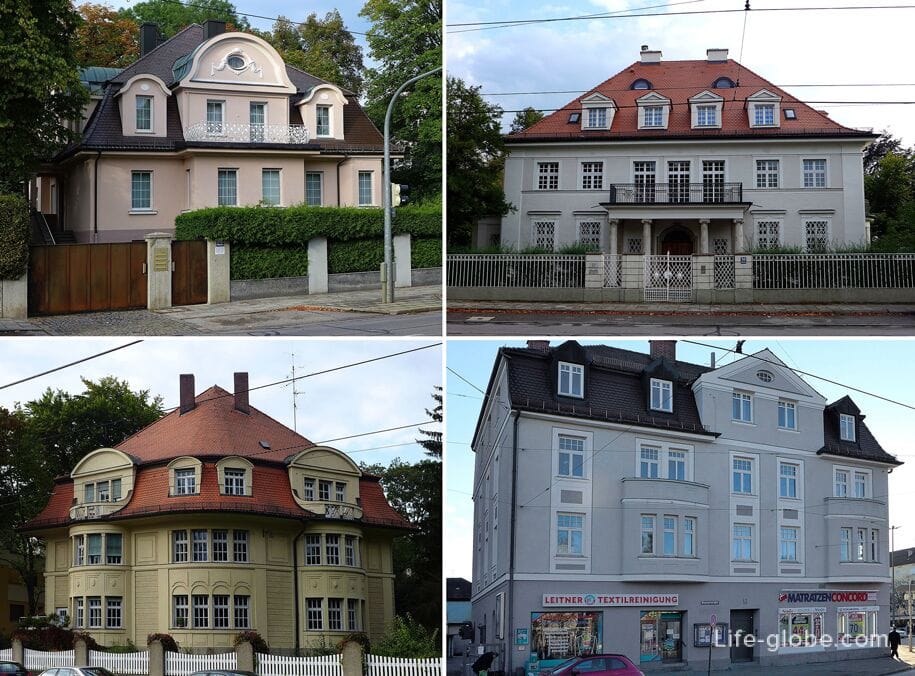
- Pedro Square (Dom-Pedro-Platz), created in 1899 as the new center of Neuhausen, and around which buildings in the neo-Baroque style are attractive. Learn more about Neuhausen-Nymphenburg...
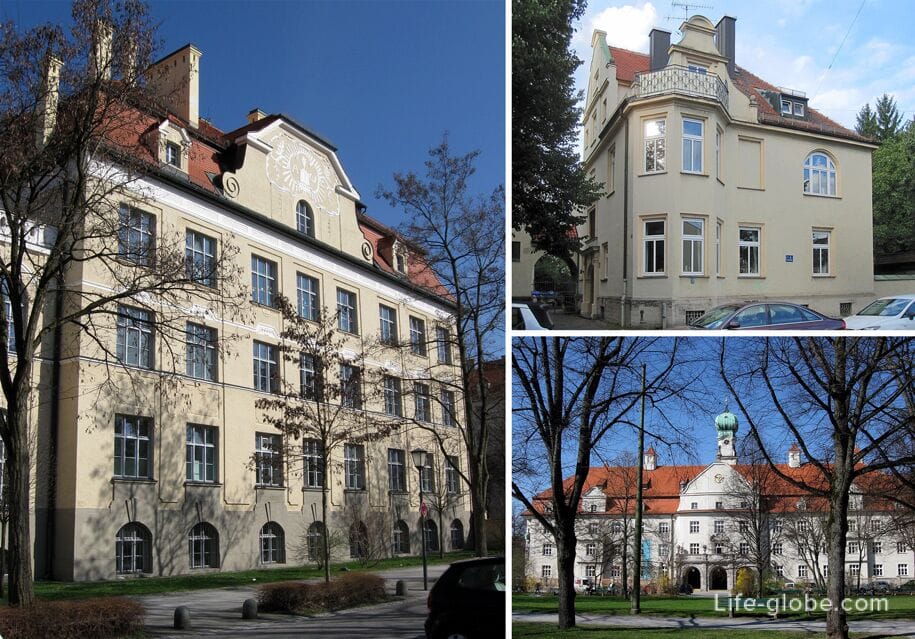
Bogenhausen district
The Bogenhausen district is located on the east side of the Isar River.
The area is attractive:
- "Old Bogenhausen" (Altbogenhausen), which is the oldest part of Bogenhausen and is located between the Isar River in the west, Prinzregentenstrasse in the south, and the "middle" B2R ring road in the east and north.
The quarter, with its Art Nouveau, Neo-Baroque and Renaissance buildings, was built from the end of the founding period in accordance with the uniform principles of urban planning as a large, representative residential area;
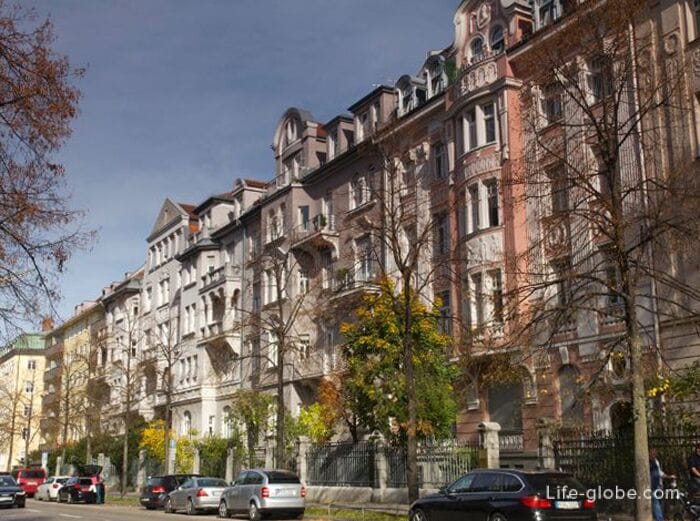
- Villa Stuck is a historic villa, originally a private mansion built in 1897-1898 in the Art Nouveau style for the German artist and sculptor Franz von Stuck.
Since 1992, the villa has housed the Villa Stuka Museum, which presents the preserved historical rooms of the villa with furniture, the artist's workshop, collections of works by Franz von Stuka himself and exhibits of applied art from the turn of the 19th and 20th centuries.
Address: Prinzregentenstraße, 60. Website: villastuck;
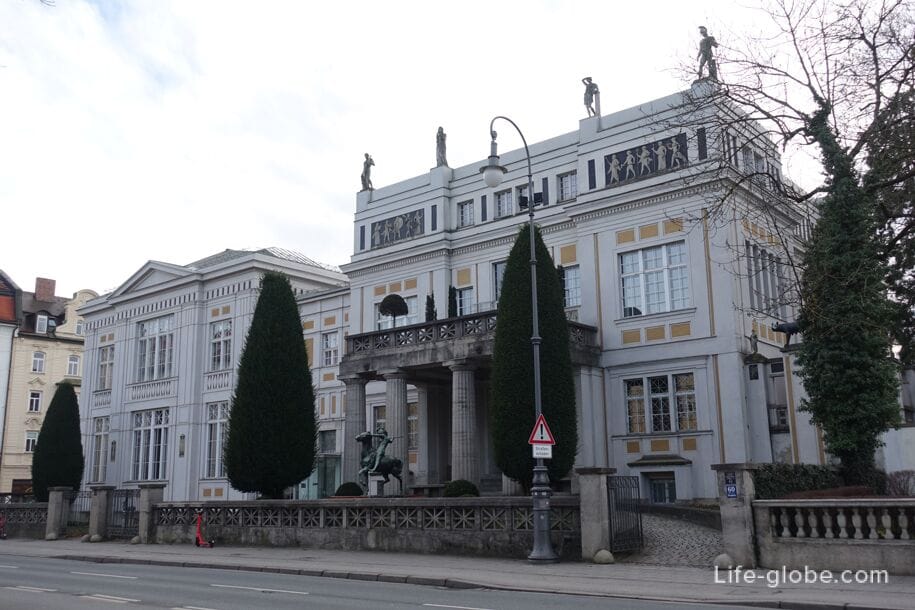
- the Prince Regent's Theater (Prinzregententheater), built of cast stone between 1900 and 1901.
The theater was opened on August 21, 1901 with the opera Die Meistersinger von Nürnberg by Richard Wagner, which is considered one of the peaks of Wagner's work.
The program of the theater today includes classical music concerts, opera and dance performances.
Address: 12 Prinzregenten Square (Prinzregentenplatz). Website: theaterakademie. More about the Bogenhausen area…
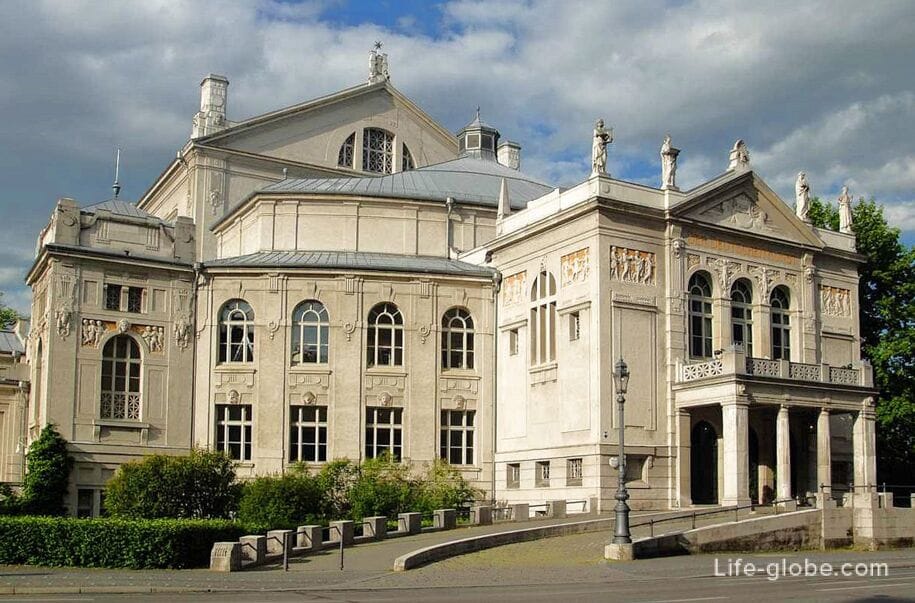
Au Haidhausen district
Au-Haidhausen is an urban district number 5 in Munich, located in the immediate vicinity of the center of Munich, on the east side of the River Isar.
The area was originally a place of residence and work for artisans, small businesses, labourers and day laborers outside the medieval city walls of Munich.
In Au-Haidhausen, some former town houses of workers and artisans are preserved, which today reflect the history, living and working conditions of the artisans and workers of the past. For example, the buildings on the east side of Vienna Square and on the east side of Preysingstrasse.
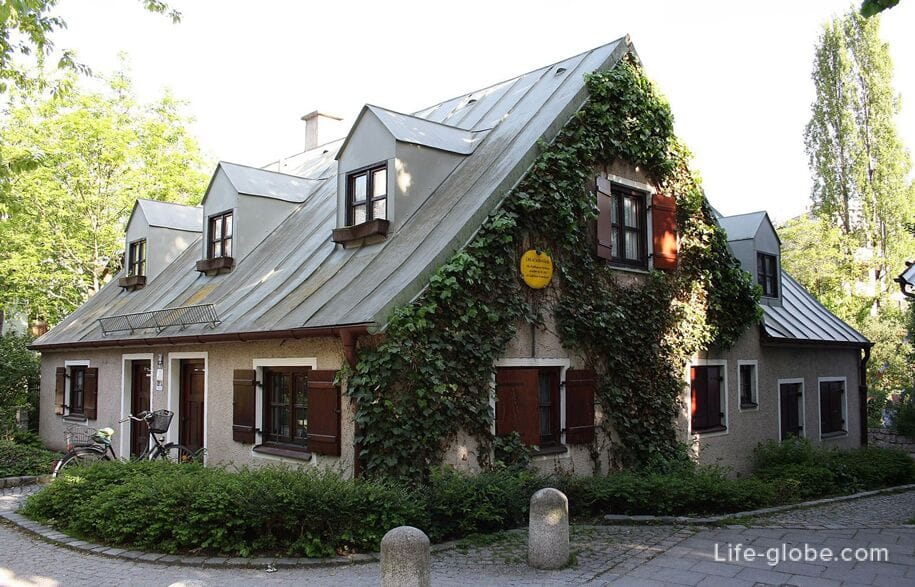
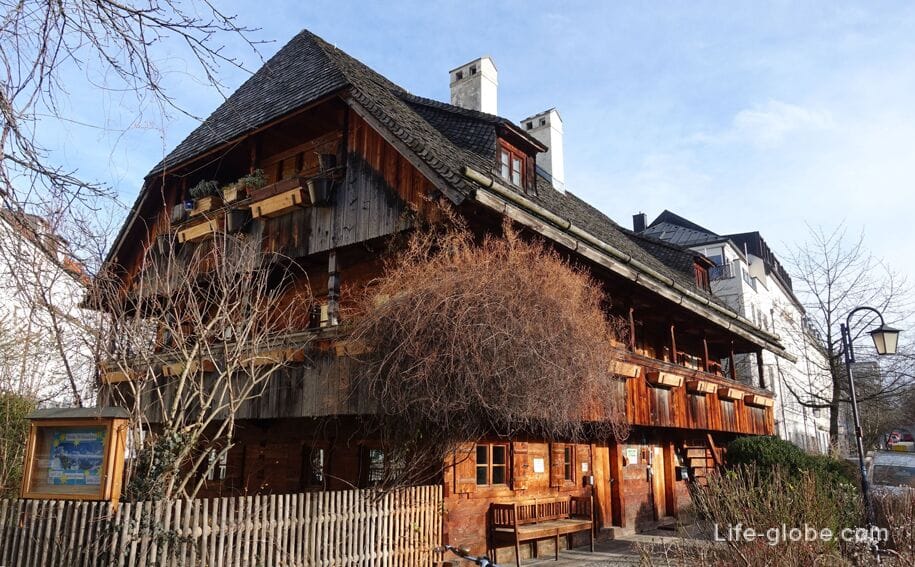
Weissenburger Square (Weissenburger Platz) forms the center of the so-called "French Quarter".
In the center of the square is the glass palace fountain (Glaspalastbrunnen), created by August Voight in 1853. The fountain was once located in the Glass Palace (now defunct) in the old Botanical Garden of Munich, but was later moved to its current location. Learn more about the Au-Haidhausen area…
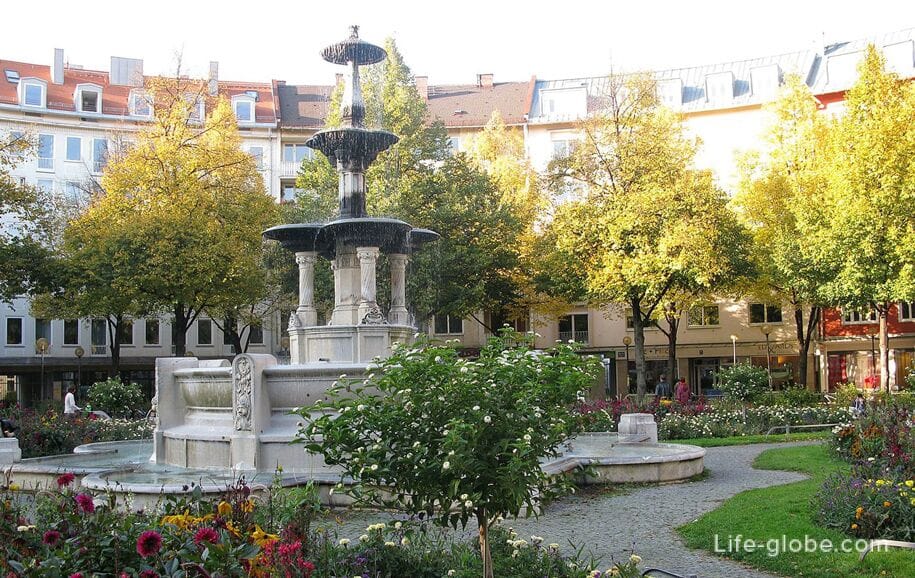
Palaces of Justice
In the center of Munich there are two "palaces of Justice":
- the Palace of Justice (Justizpalast), built in 1890-1897 and attracts attention with its impressive size and unadorned facade.
The architecture of the building is dominatedby four facades, a central glass dome (67 meters) and sculptures located on the facades and roof of the building.
Today, the building houses the Bavarian Ministry of Justice and the District Court I of Munich.
Address: Karlsplatz / Prilmayerstrasse 7 (Prielmayerstraße);
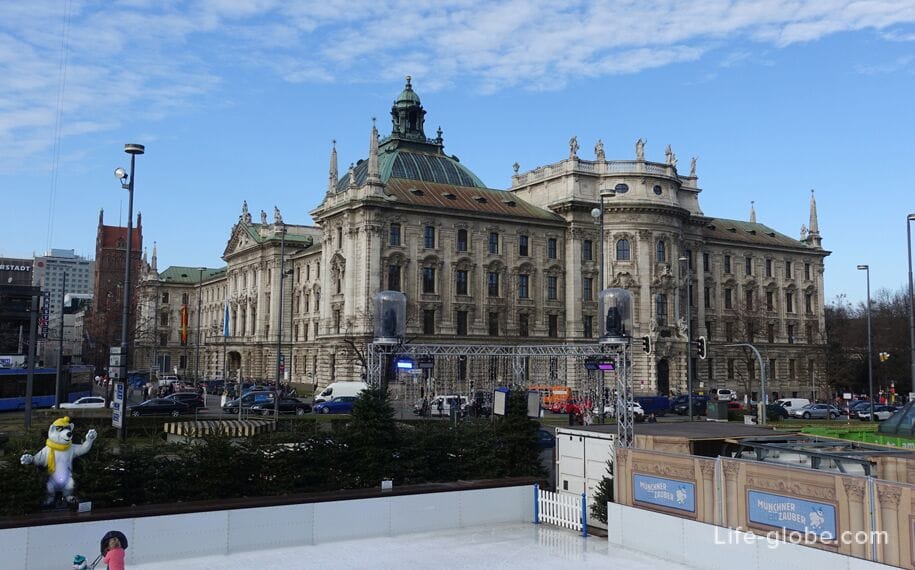
- the new Palace of Justice (New Justizpalast), built in addition to the already existing palace of justice, because there was not enough space in the latter.
The building was built in 1905, in strong contrast to the "old" Palace of Justice, made of red brick in the northern neo-Gothic style with two towers. The end facades are marked by high stepped gables, and the central docking towers on each side are bordered by similar gables.
Today, the building houses the Supreme Regional Court.
Address: Prielmayerstrasse 5 (Prielmayerstraße).
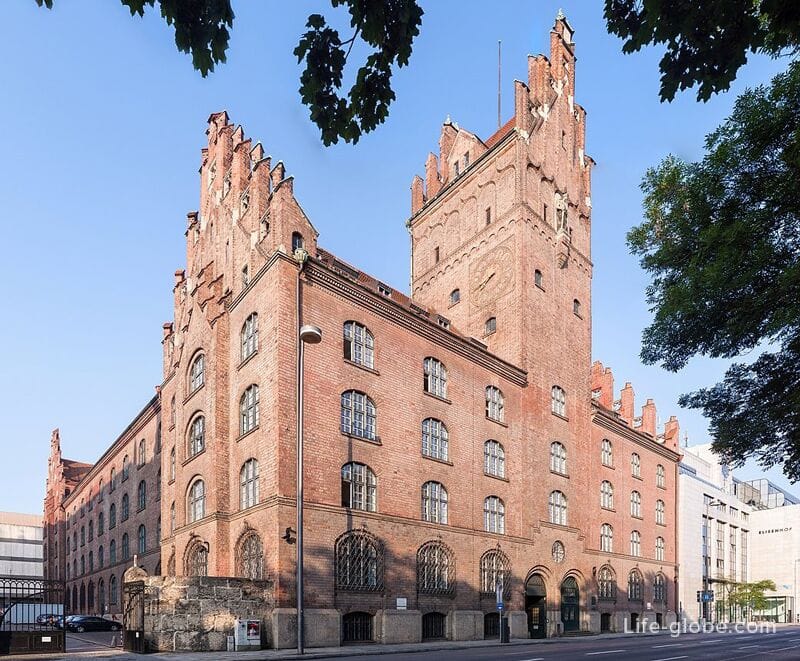
Statue of Bavaria and Hall of Fame
The Bavaria Statue is a monumental bronze statue that, in its female form, represents the Bavarian region - its power and glory. The statue was commissioned by King Ludwig I of Bavaria and made from 1844 to 1850.
An internal spiral staircase, located in Bavaria, leads to a platform at the head of the statue, from where small openings overlook the Therese Meadow and the surrounding area.
The Hall of Fame (Ruhmeshalle mit Bavaria) is a monumental structure that, like the statue "Bavaria", was commissioned by King Ludwig I of Bavaria and erected between 1843 and 1853.
The purpose of building the Hall of Fame was to honor the memory and glory of outstanding personalities of Bavaria.
The Hall of Fame is located behind the statue of Bavaria and is a gallery with busts of famous Bavarians of past centuries.
Address: Theresienhöhe, 16. Learn more about the Bayern Statue and Hall of Fame…
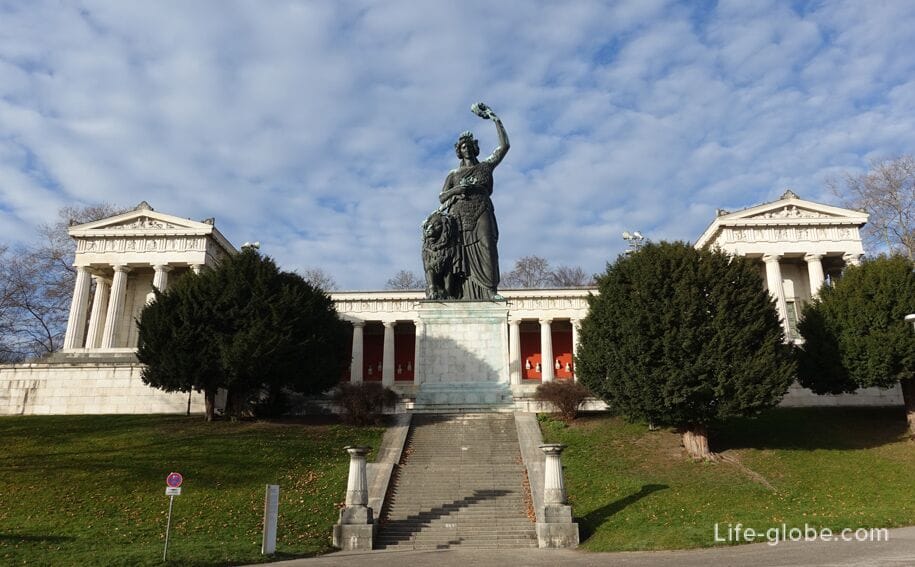
Victory Gate
The Victory Gate (Siegestor) is a classic triumphal arch, which is one of the symbols of Munich and rises at the end of Ludwigstrasse.
The gate was created and built by order of King Ludwig I of Bavaria in the period from 1843 to 1852.
The triumphal Arch is crowned by a large bronze sculpture consisting of a statue of Bavaria sitting on a chariot drawn by four lions. Learn more about Victory Gate…
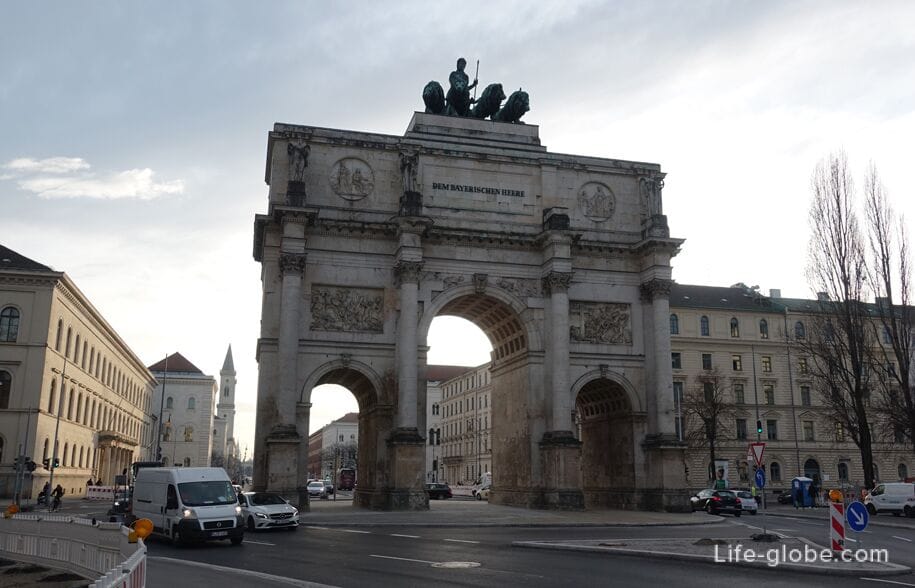
Maximilianeum
Maximilianeum (Maximilianeum) - a historic luxury building, the construction of which was started by decree of King Maximilian II in 1857 in order to support gifted students and accommodate scholarship holders.
Since 1949, the Maximilianeum has also housed the Bavarian Landtag (Bavarian State Parliament).
The building has Gothic and Renaissance features.
A wide monumental staircase leads to the main entrance of the building, which faces the Maximiliansbrücke Bridge. The stairs offer views of the bridge, Maximilianstrasse and some of the surrounding area.
Address: Max-Planck-Straße, 1. Learn more about Maximilianeum…
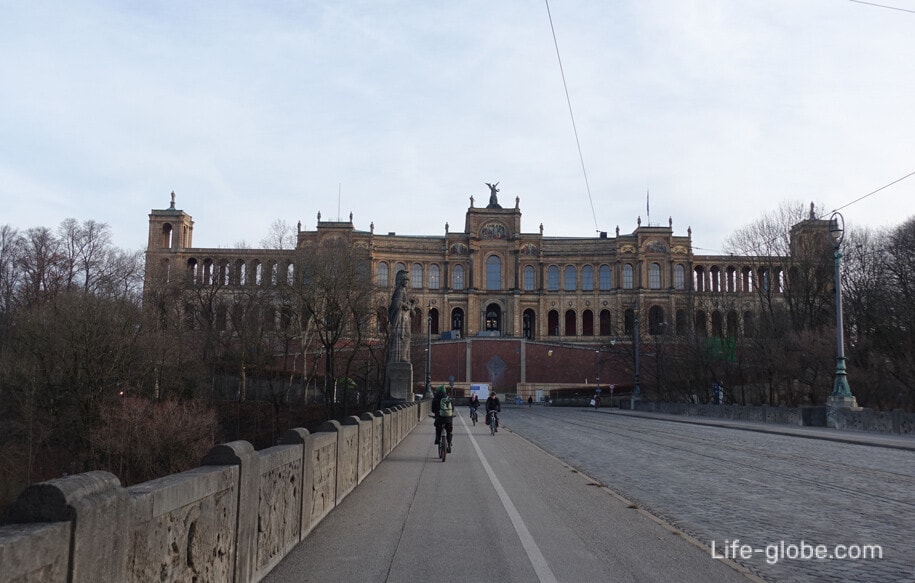
Angel of Peace Memorial (observation deck)
The Angel of Peace Memorial (Friedensengel) is dedicated to the 25th anniversary of the peace treaty after the end of the Franco-Prussian war of 1870-1871.
The Peace Monument consists of an open square temple built on the Greco-Ionian model and a high Corinthian-style column, which is decorated with a bronze figure of a golden angel.
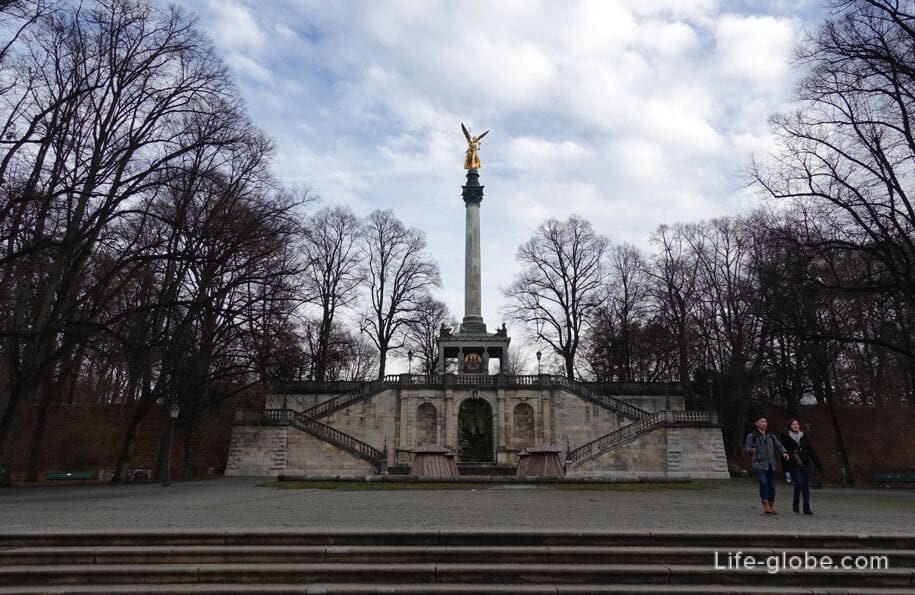
Near the column is an open area-the Prinzregent-Luitpold-Terrasse, which offers views of the Prinzregentenstrasse and part of the historic center of Munich. Read more about the Angel of Peace Memorial and the observation deck…
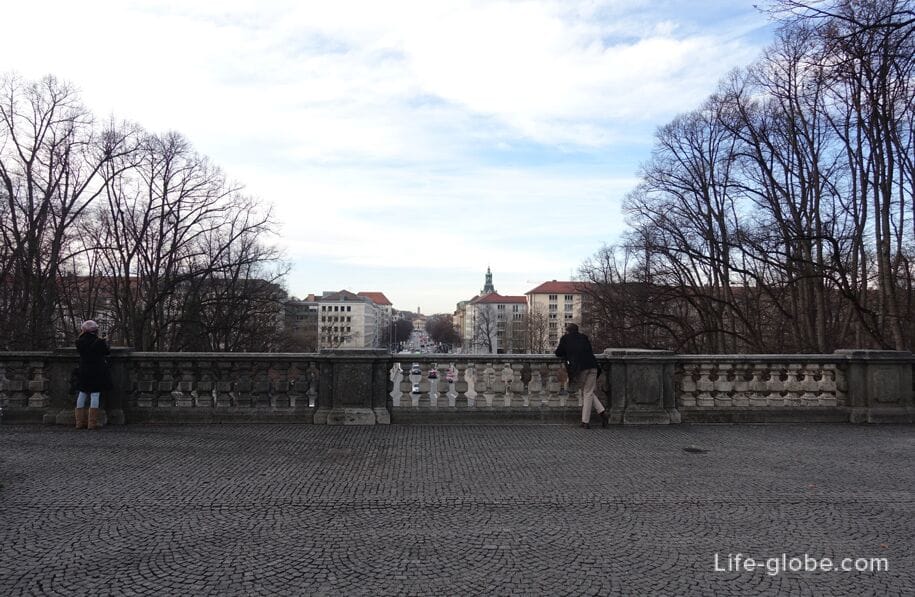
Detailed articles about the sights of Munich
Museums in Munich
Munich is home to a wide variety of museums, galleries, including art galleries, halls and centers that host various exhibitions and cultural events.
Some of Munich's art museums date back to the Wittelsbach dynasty and have been established over the centuries. A major role in their formation was played by Ludwig I of Bavaria, who founded the Glyptothek, as well as the Old and New Pinakothek.
In addition to the museums listed above in this article (Munich Residence, Nymphenburg Palace, Munich City Museum with film Museum, Munich Jewish Museum, Villa Stuck, Toy Museum), in Munich are also located:
Area of art
The main art museums and galleries of Munich are located close to each other, in the so-called "Art Area" (Kunstareal München), which is an art zone - the museum quarter and cultural center of Munich, known far beyond the Bavarian capital. One of the most visited:
- Old Pinakothek (Alte Pinakothek) - a museum with a collection of paintings by masters from the Middle Ages to the middle of the 18th century;
- New Pinakothek (Neue Pinakothek) - a museum that presents paintings and sculptures by masters of the second half of the 18th and early 20th centuries;
- Pinakothek der Moderne - one of the world's largest art museums of modern art, mainly 20-21 centuries.;
- Museum Brandhorst - an art museum dedicated to contemporary art from the late 1950s to the present day;
- Museum of Egyptian Art (Staatliches Museum Ägyptischer Kunst) - an archaeological museum containing the Bavarian state collection, which focuses on the art of ancient Egypt;
- Glyptothek - a museum with a collection of ancient sculptures and glyptics;
- State Antique Collection (Staatliche Antikensammlung) - a museum that houses one of the most extensive collections of Greek, Etruscan and Roman art in Germany;
- city gallery in the Lenbach house (Städtische Galerie im Lenbachhaus) - an art museum with a collection of works by Munich artists, especially from the 18th and 19th centuries;
-The Nazi Party Documentation Center (NS-Dokumentationszentrum), focusing on the history and consequences of the Nazi regime and the role of Munich as the "movement capital" of National Socialism. Learn more about the Area of art and museums…
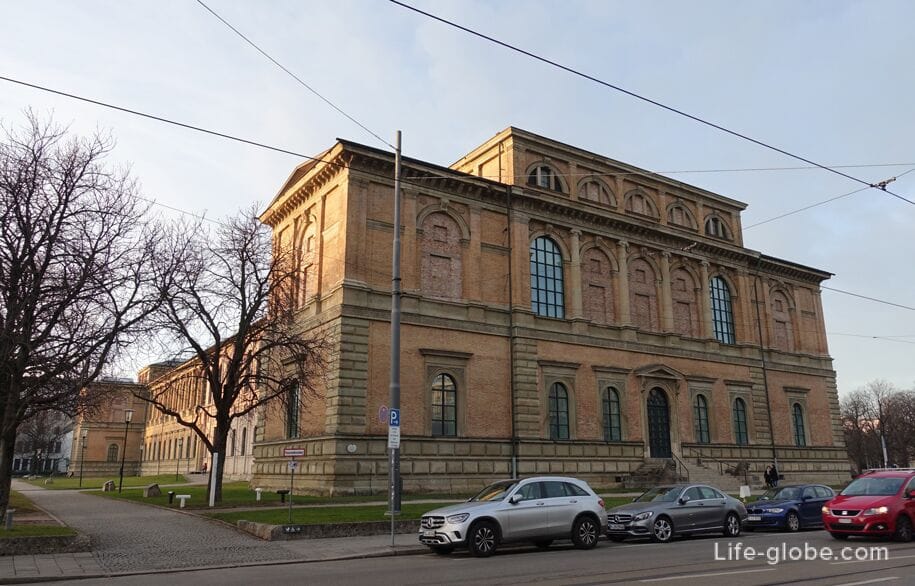
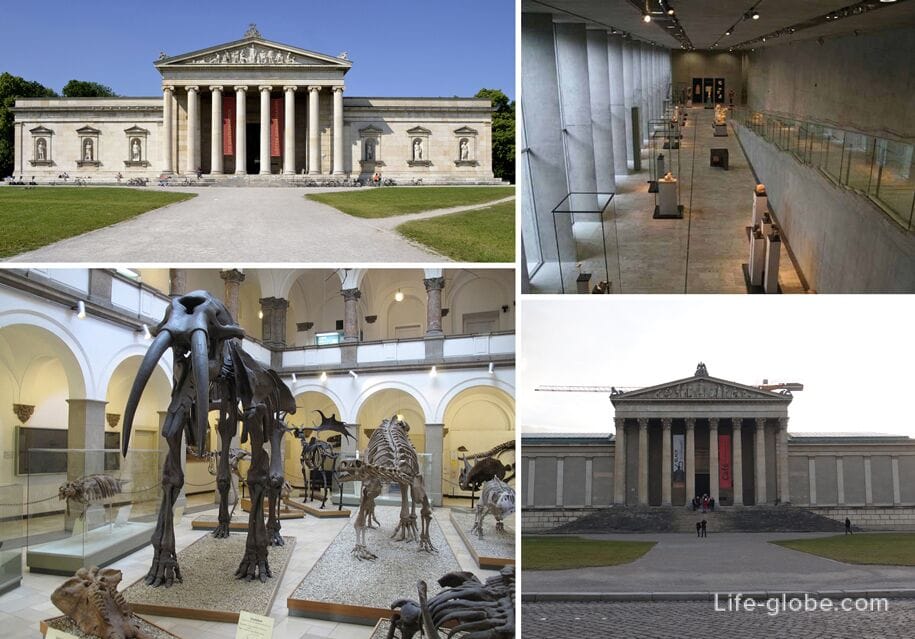
German Museum
The Deutsches Museum is the world's largest and most important science and technology museum, with more than 30,000 exhibits from 50 fields of science and technology, from astrophysics to cell biology.
The German Museum is not only an exhibition space, but also a huge playground where visitors can not only see, but also try out objects - turn buttons, switch levers and switches, and touch many exhibits.
The German Museum is located on the Museum Island (Museumsinsel), at the address: Museumsinsel, 1.
Museum website: deutsches-museum. Learn more about the German Museum…
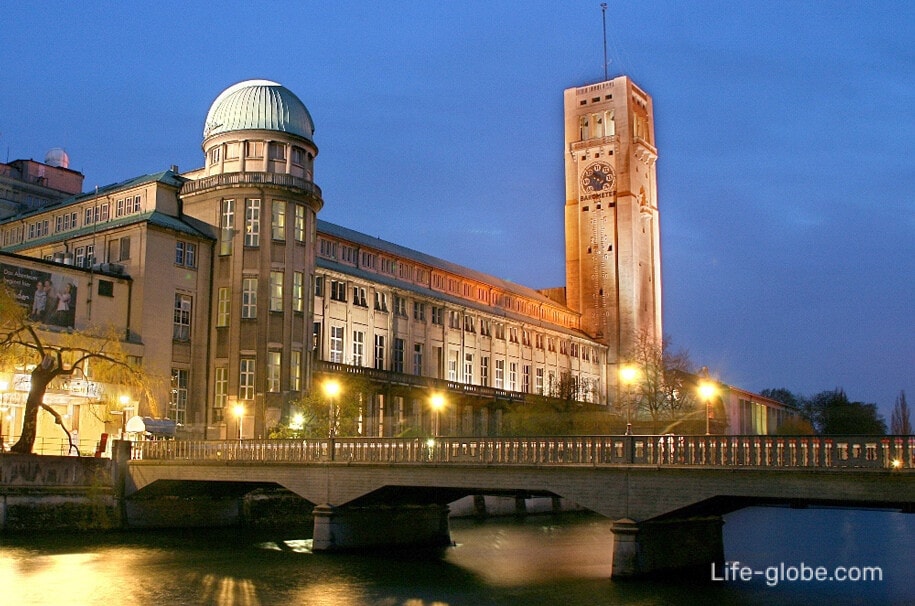
Bavarian National Museum
The Bayerisches Nationalmuseum (Bayerisches Nationalmuseum) is one of the most important museums in Munich, with museum branches located extensively outside the city.
Today, the museum is one of the most important arts and crafts museums in Europe and one of the largest art museums in Germany.
The main core of the collection of the Bavarian National Museum in Munich comes from the personal art collection of the Wittelsbach dynasty. Of particular importance to the collections are the exhibits that go far beyond the borders of Bavaria.
The main building of the museum, designed in the eclectic style (a mixture of Romanticism, Gothic, Baroque and Renaissance), is a historical monument.
The address of the main building of the museumis 3 Prinzregentenstrasse.
Museum website: bayerisches-nationalmuseum. Learn more about the Bavarian National Museum…
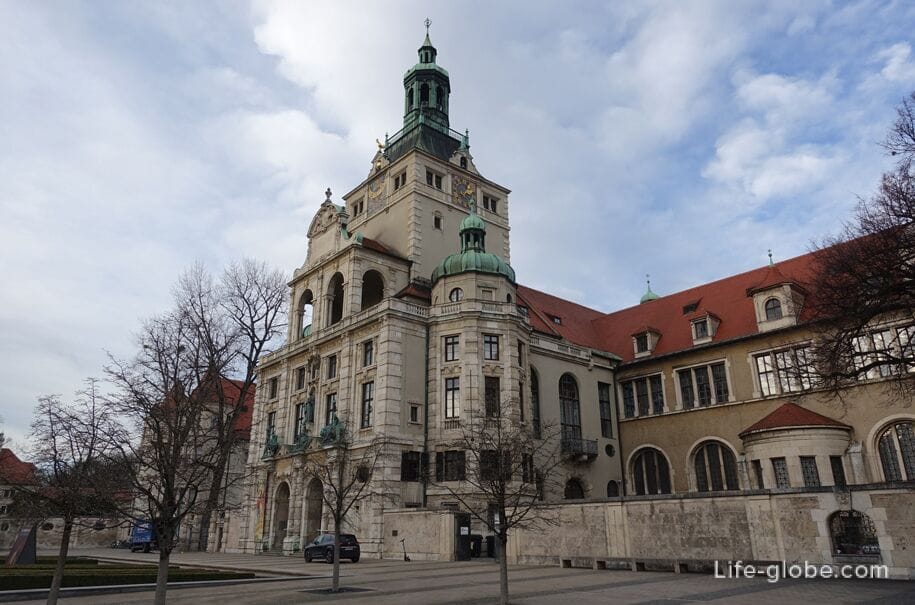
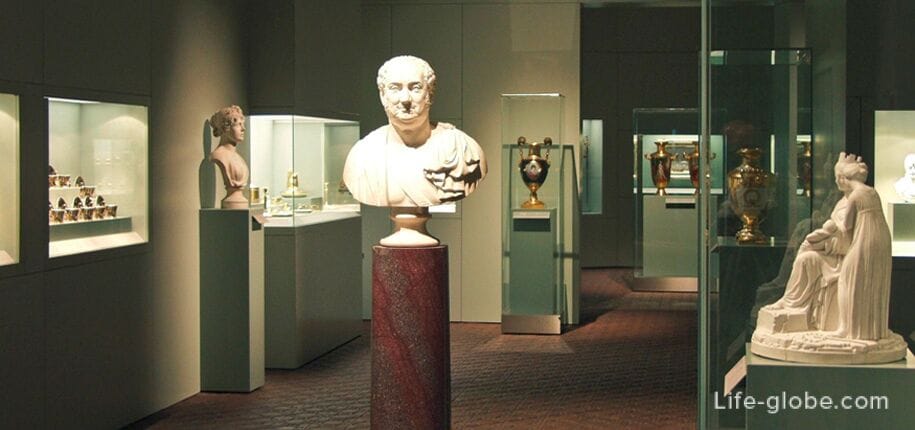
Five Continents Museum
The Museum of the Five Continents (Museum Fünf Kontinente) is a museum for non-European works of art and objects of cultural significance in Munich.
The museum's exhibitions provide an overview of various non-European cultures. There are permanent exhibitions dedicated to Africa, South America, North America, Oceania and the East.
Address: Maximilianstraße, 42. Website: museum-fuenf-kontinente. Learn more about the Five Continents Museum…
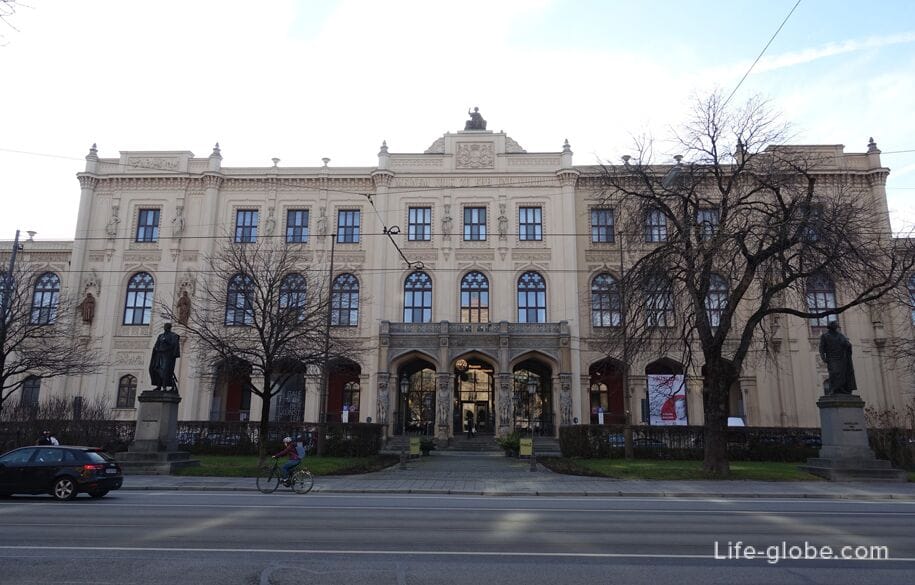

Schack Collection
The Schack Collection (Sammlung Schack), until 2009 known as the Schack Gallery (Schack-Galerie), is one of the most important collections of 19th-century German paintings in Bavaria.
The gallery originated from the collection of Count Adolf Friedrich von Schack, a versatile literary writer and collector who, since 1857, has created a collection of modern art in Munich.
The gallery features paintings by famous German artists and masterpieces from the 16th and 17th centuries, primarily from Venetian artists.
Address: Prinzregentenstraße, 9. Website: sammlung-schack. Learn more about the Schack collection...

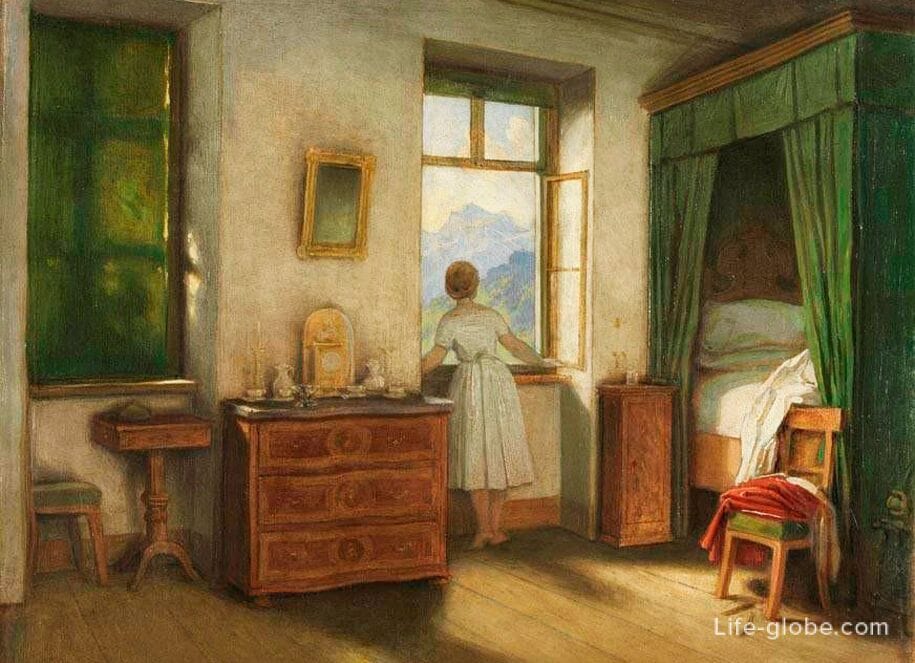
House of Art
The House of Art (Haus der Kunst) organizes and displays various exhibitions of contemporary art and thematic exhibitions. The art house does not have its own collection.
Within the walls of the building are also: an archive gallery, where the artist Martin Schmidl collected furnishings and exhibits reflecting the history of the house of art (free to visit), as well as a bar and a nightclub.
Address: Prinzregentenstraße, 1. Website: hausderkunst.
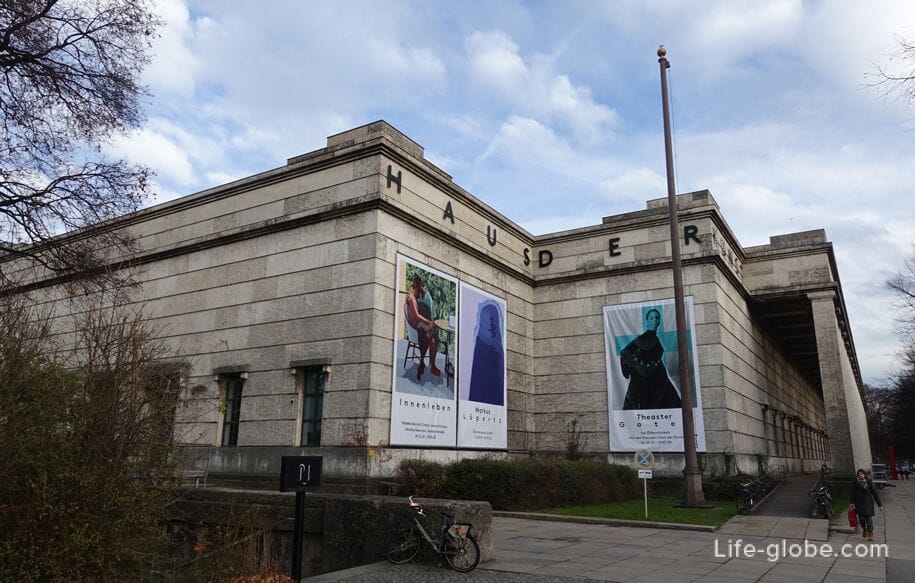
Beer and Oktoberfest Museum
The Beer and Oktoberfest Museum (Bier-und Oktoberfestmuseum), with a foamy tasting and a restaurant, is located in a historic house - one of the oldest Munich townhouses, whose history dates back to 1340.
The museum's exhibition tells the story of the historical building itself, as well as about beer, production, the law on the purity of the drink, the history of foam from coming to monasteries, the development and history of the Munich Oktoberfest festival.
Address: Sterneckergaße, 2. Website: bier-und-oktoberfestmuseum. Read more about the Beer and Oktoberfest Museum...
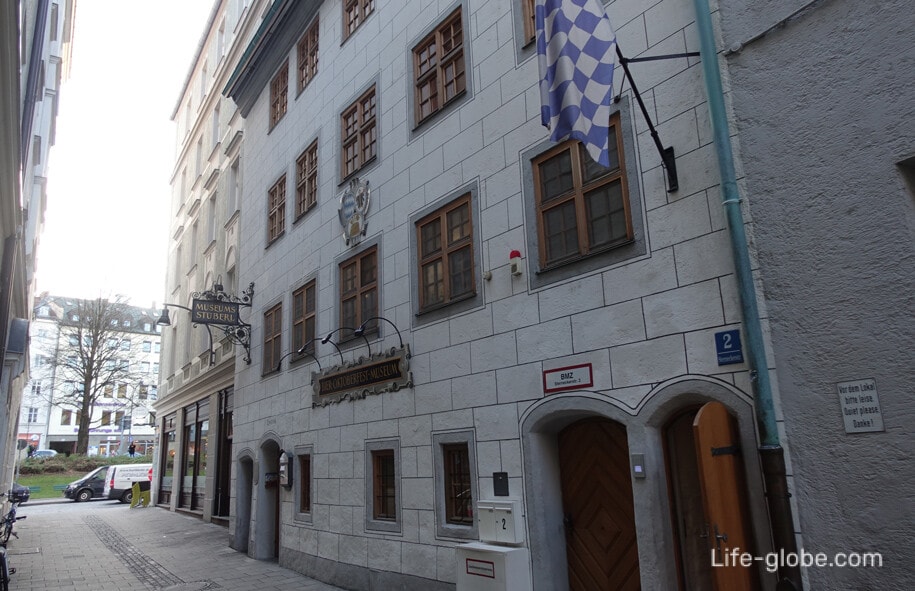
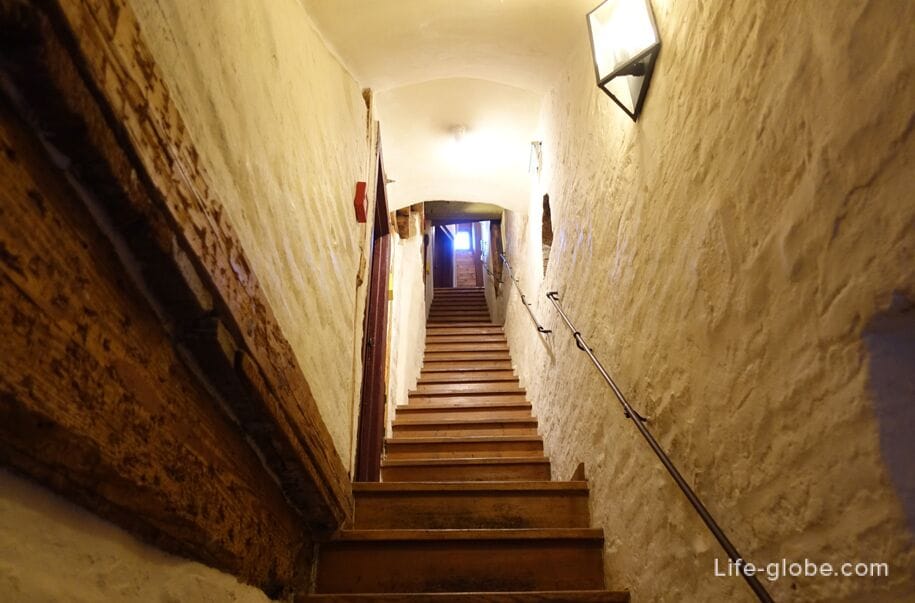
German Museum of Hunting and Fishing
The German Museum of Hunting and Fishing (Deutsches Jagd und Fischereimuseum) exhibits stuffed wild animals and objects related to the history of hunting and fishing in Germany over several centuries.
The museum is located within the walls of the former Augustinian Church (Augustinerkirche), which was built in the 13th century, and then expanded and rebuilt.
Address: Neuhauser Straße, 2. Website: jagd-fischerei-museum.
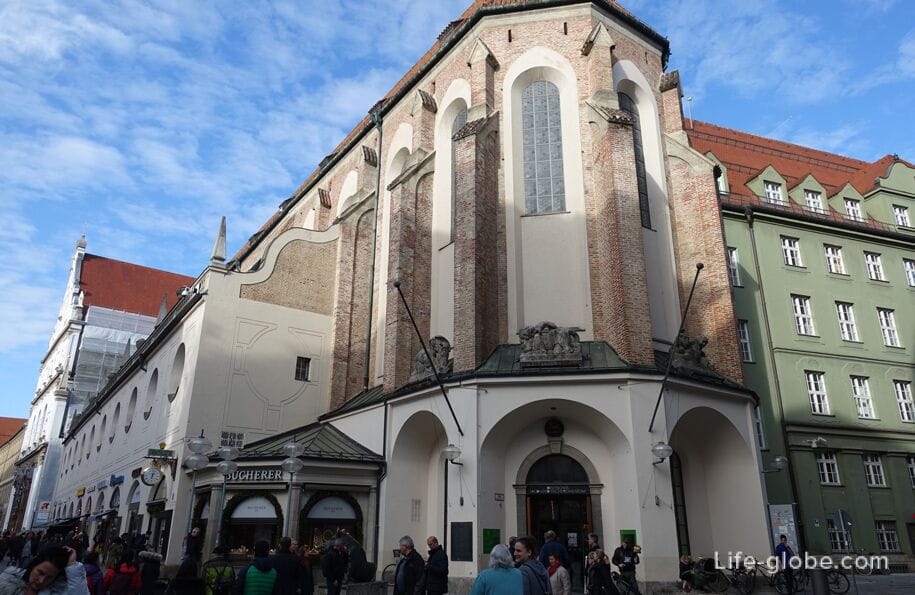
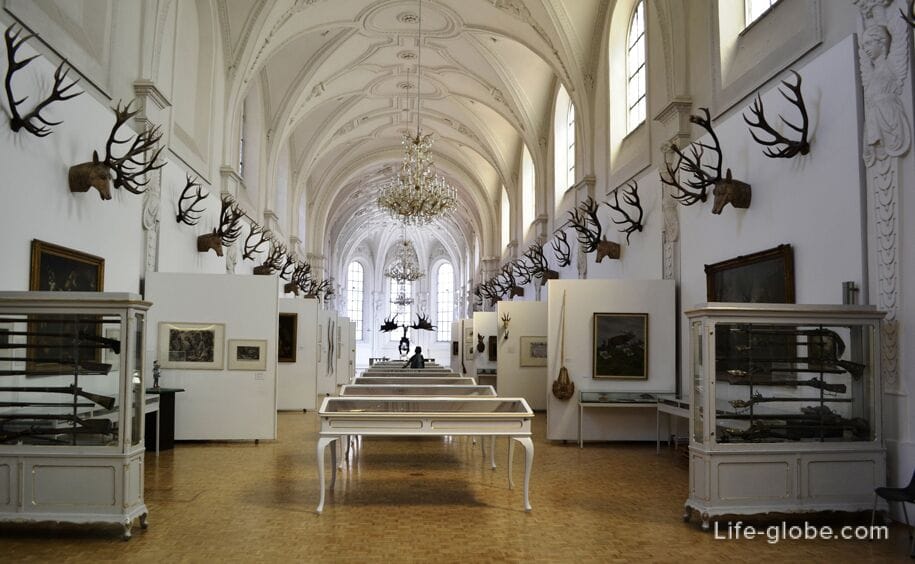
BMW Museum
The BMW Museum is an automobile museum dedicated to the history of the BMW brand and products.
On the exhibition areas of the museum are the original and most interesting exhibits of cars and motorcycles of different years, engines and turbines of aircraft. Some of the museum's spaces are dedicated to advertising, design, and the development of the BMW brand.
Address: Am Olympiapark, 2. Website: bmw-welt. Learn more about the BMW Museum…
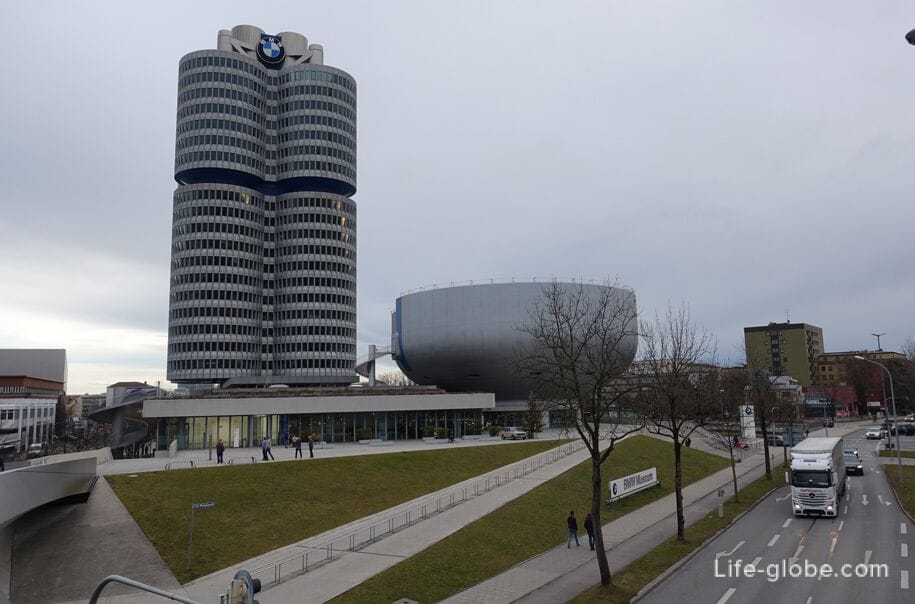
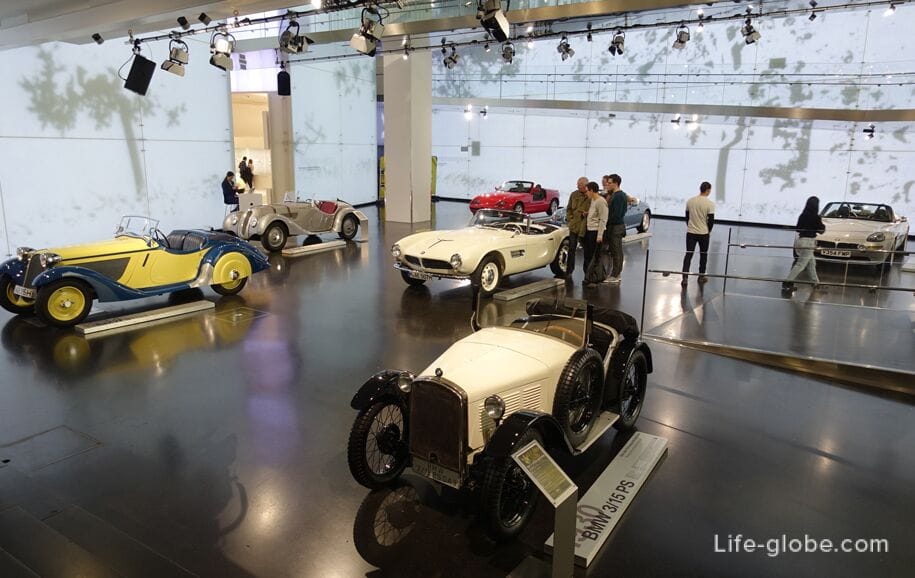
Learn more about all museums in Munich with addresses and websites…
Olympic Park and Tower
The Olympic Park (Olympiapark) is a park complex that was built for the 1972 Summer Olympics in Munich.
Today, the Olympic Park serves as a venue for sports, cultural, social and religious events and festivals, as well as a place for sports, walking and recreation.
In addition to the sports facilities themselves, the Olympic Park complex includes: a landscape park with Olympic Observation Mountain, Lake Olympia, Munich Olympic Avenue of Stars, beer garden, restaurants, Olympic Observation Tower (Munich's highest observation deck), aquarium, residential area and shopping center. Learn more about the Olympic Park…

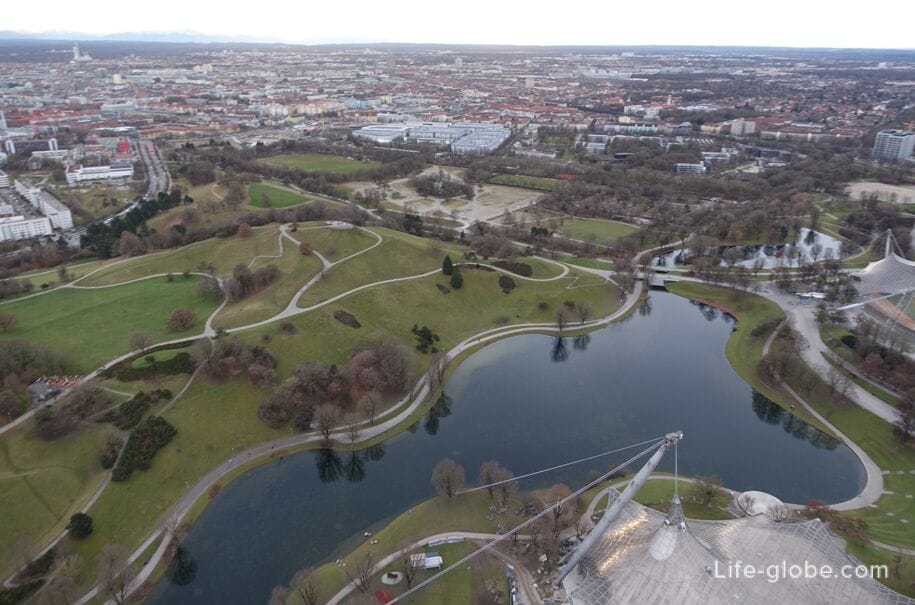
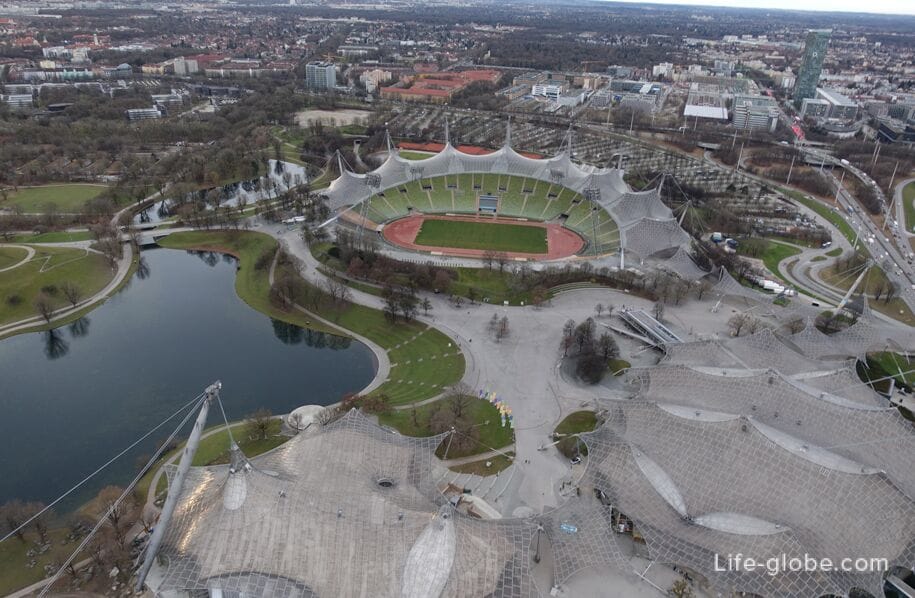
Isar River
The Isar River flows through the entire city of Munich, in a south-north direction.
On warm summer days, the Isar coast becomes a popular place for picnics and sunbathing. In the Izar itself, you can swim. Barbecue facilities are available on the coast. Learn more about holidays on the Isar River in Munich: swimming, barbecue, walking…
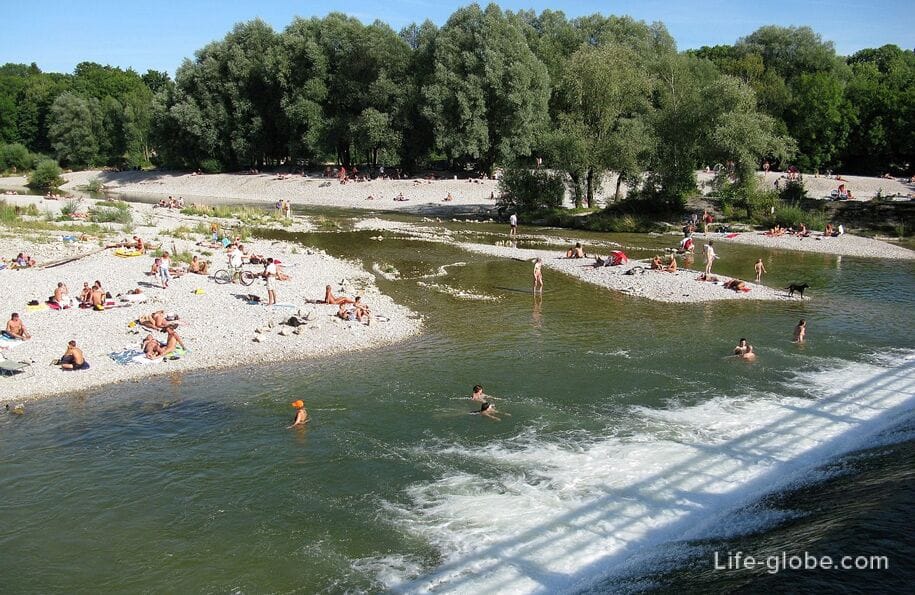
At any time of the year, the banks of the Izar offer visitors and residents of the city places and routes for walking, recreation and some sports (running, cycling, roller skates, etc.).
You can walk along the embankments and parks that run along the river and(or) the numerous bridges across the river that connect the two banks of the river and the islands located on the Izar.
One of the Isar's quays, Steinsdorfstrasse and Widenmayerstrasse, attract visitors with buildings, some of which are historical and architectural monuments. Learn more about bridges and embankments in the center of Munich...
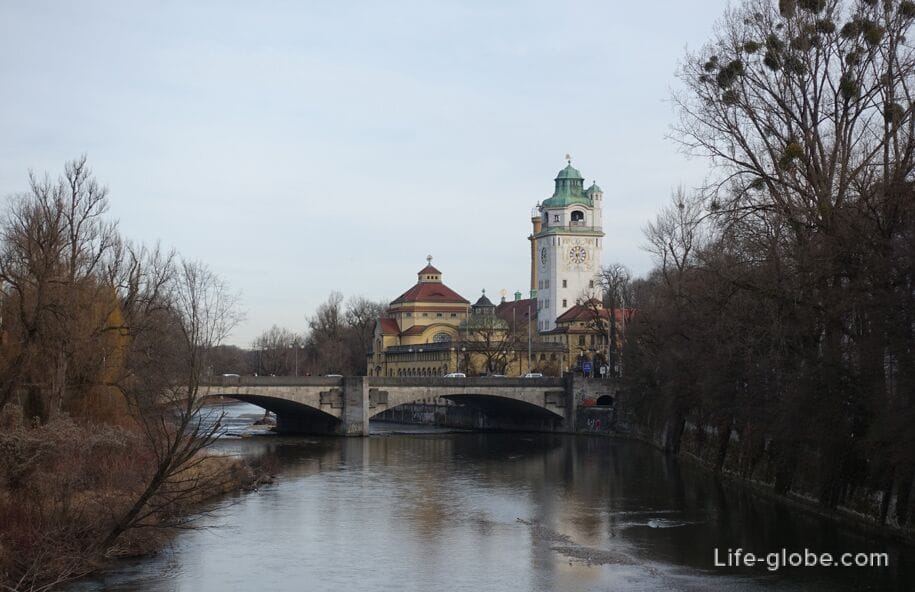

River surfing in Munich
Munich has a reputation for being a popular destination for river surfing:
- the most famous place in Germany for river surfing is the standing "Eisbach wave", which is located on the southern edge of the English Garden and is used by surfers all year round;
- 700 meters downstream of the stream from the Eisbach wave, there is a second, lighter wave - the "Small Eisbach Wave" (Kleine Eisbachwelle);
- two other surfing spots in the city are located along the Isar River: the wave at the southern edge of Munich-the "Land Raft" (in the Flossland canal) and the waves at the Wittelsbach Bridge (Wittelsbacherbrücke), formed during floods. Learn more about surfing in Munich with the Eisbach Wave video…
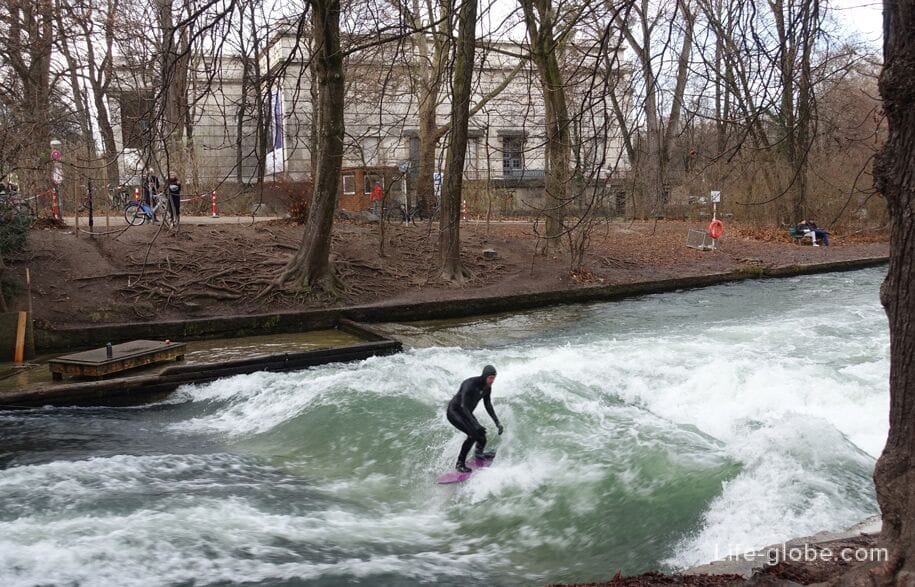
Parks in Munich
The Bavarian capital has a large number of parks, gardens and green areas, which are great places for walking, recreation and sports.
Some parks are located in the heart of the city and contain significant sights of Munich, while others are more remote from the center and are quiet places. Some parks have designated barbecue areas, while others serve as venues for cultural and sporting events.
The most famous park in the center of Munich is English Garden (Englischer Garten), which has existed for more than 230 years.
There are several significant attractions in the park, including: an observation deck with a rotunda, a Japanese tea house, part of the Berlin Wall, a Chinese tower, restaurants with beer gardens, and so on. Learn more about the English Garden…
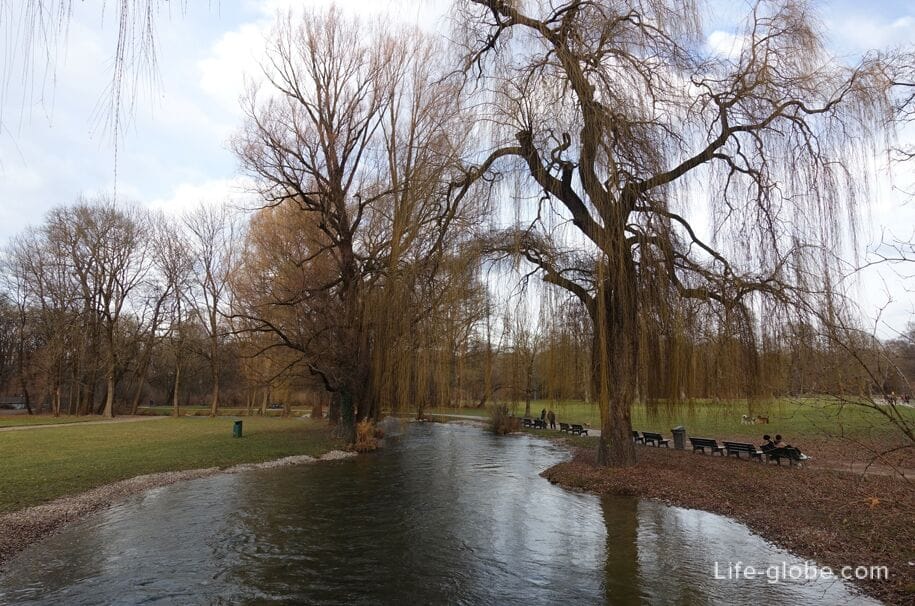
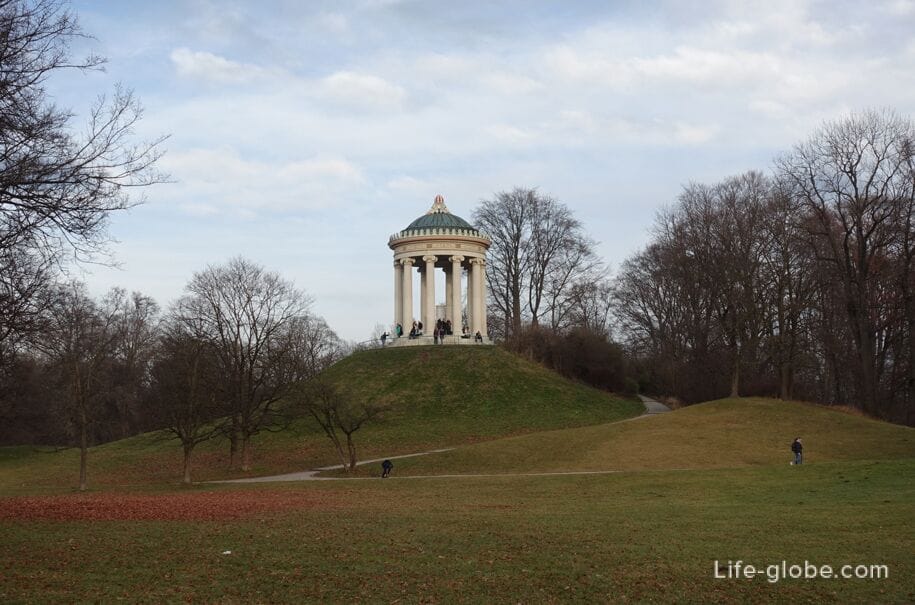
Also attractive in Munich:
- Park West (Westpark) - a large urban public park created for the International Horticulture Exhibition (IGA) in 1983.
In the Park: two lakes, cafes and beer gardens, playgrounds and sports grounds, fountains, sculptures, places to stay, walking and bike paths, garden roses, ensemble "East Asia" with gardens and buildings, and the stage (Seebühne), which summer movies under the open sky give live concerts and theatrical performances;
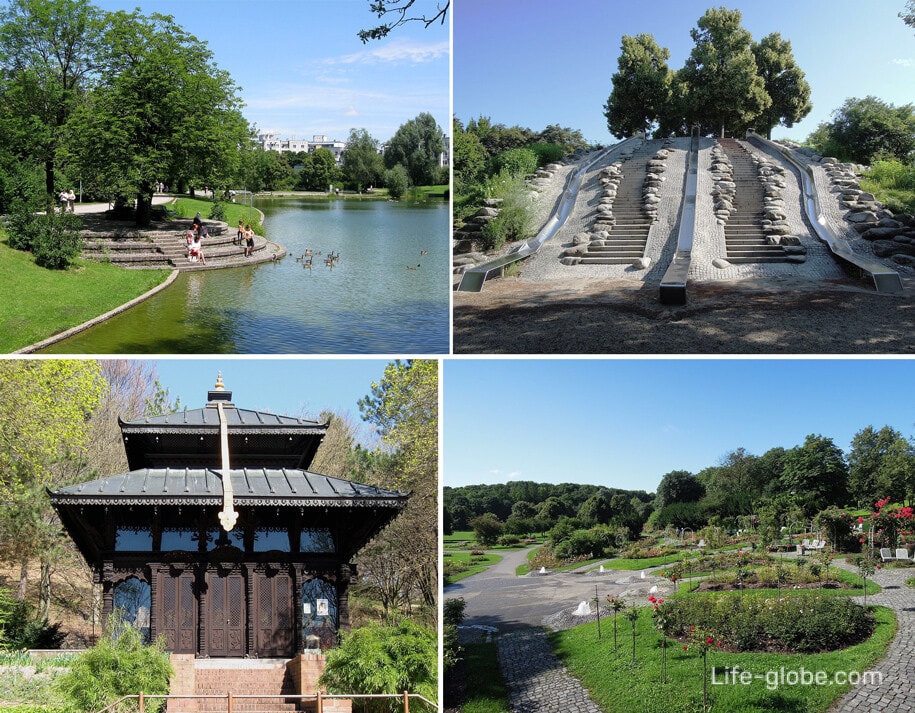
- The Old Botanical Garden (Alter Botanischer Garten), which is now a public city park.
The Botanical Garden was created between 1804 and 1812 according to the plans of the landscape architect Friedrich Ludwig von Schkell.
In the park: Neptunbrunnen Fountain (Neptunbrunnen), created in 1937; Kunstpavillon (Kunstpavillon), created as an exhibition space in 1936; memorial to the world's first long-distance power line Miesbach-Munich in 1882; cafes; places to relax and walk;
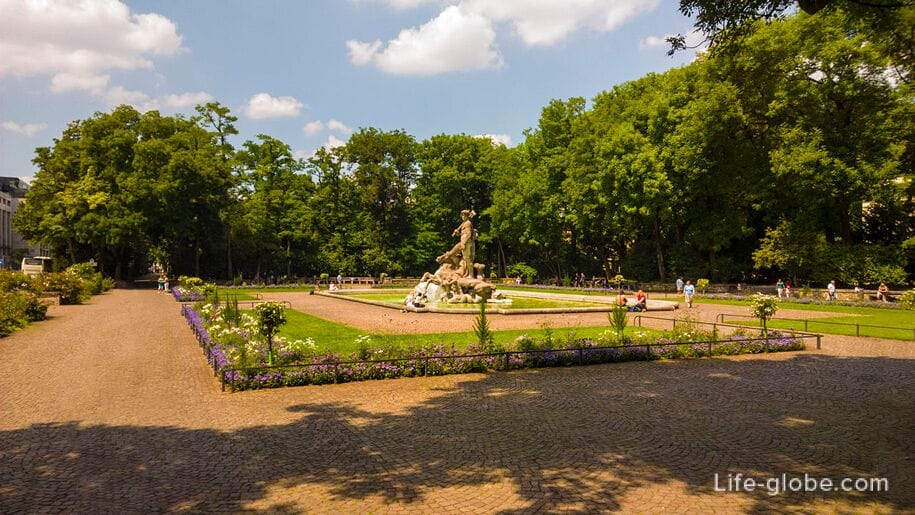
- Isar River park areas:
- Maximiliansanlagen park with an abundance of greenery, paths and paths for walking, places to relax and terraces,
- the park area "Spring plants" (Frühlingsanlagen), which has an area of about 16.3 hectares, including a large river bank;
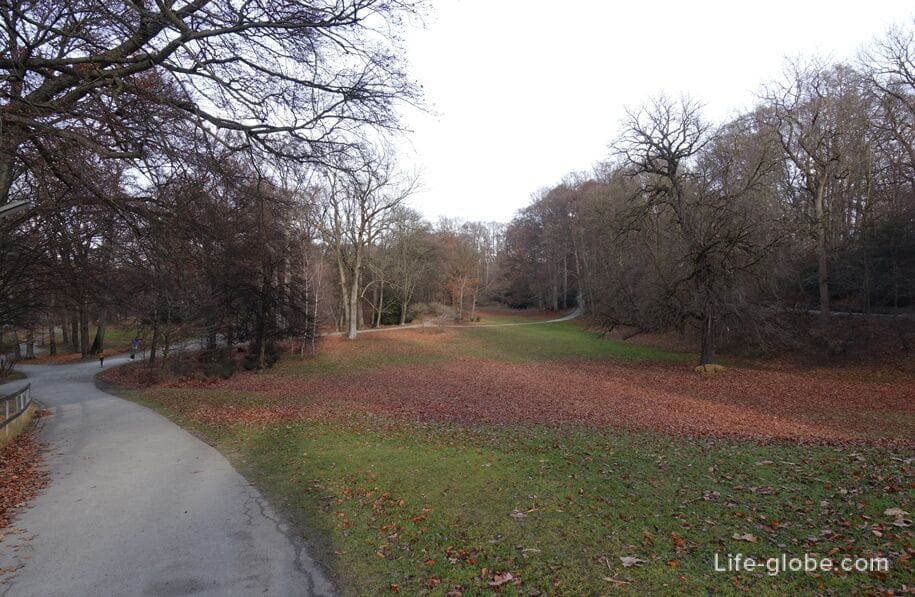
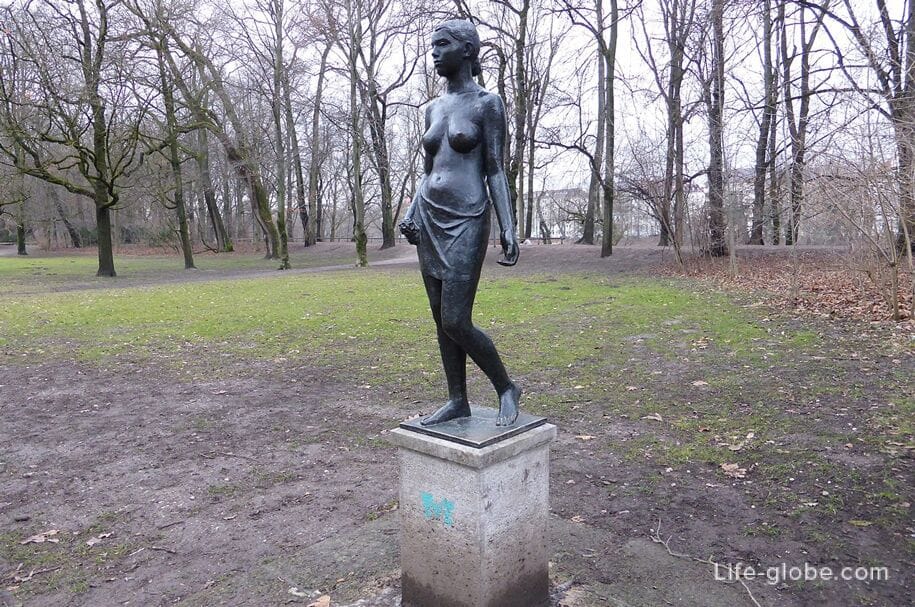
- Luitpoldpark with places for recreation and walking, a fountain, an obelisk, playgrounds, an artificial hill, which today is an observation deck and the historic neo-arched building "house of Bamberg" (Bamberger Haus) in the walls of which there is now a restaurant with a summer terrace;
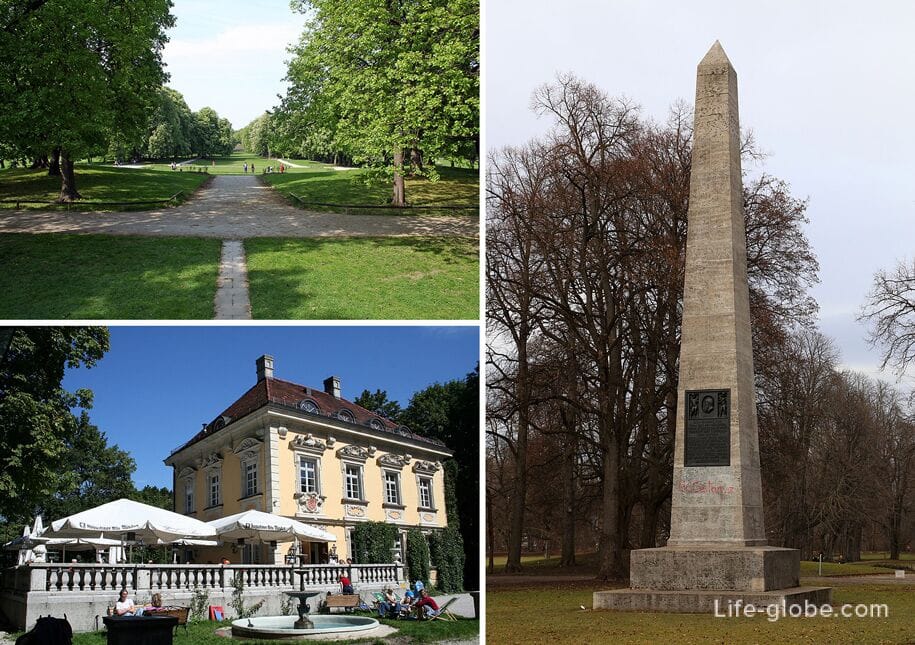
- The Hirschgarten Park, which has 40 hectares, where there are: trees, some of which are more than 150 years old, playgrounds, a skate park, meadows, barbecue areas and a 2-hectare aviary with fallow deer and moufflon.
Also in the park is one of the largest beer gardens in the world, designed for 8000 seats. Website of the restaurant with beer garden: hirschgarten;
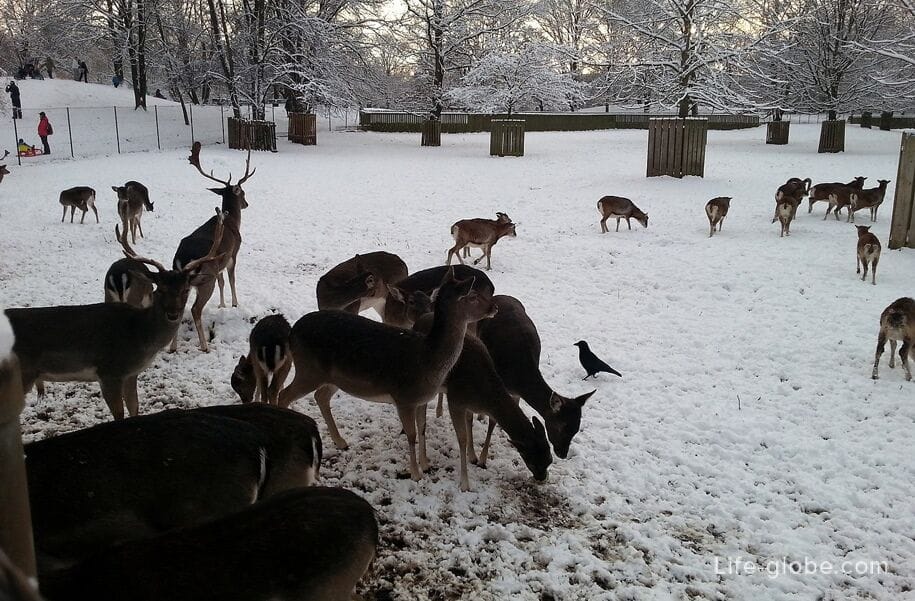
- Park Bavaria or Bavarian Park (Bavariapark), which is a quiet place.
In the park: walking paths, green areas, sculptures, children's playground;
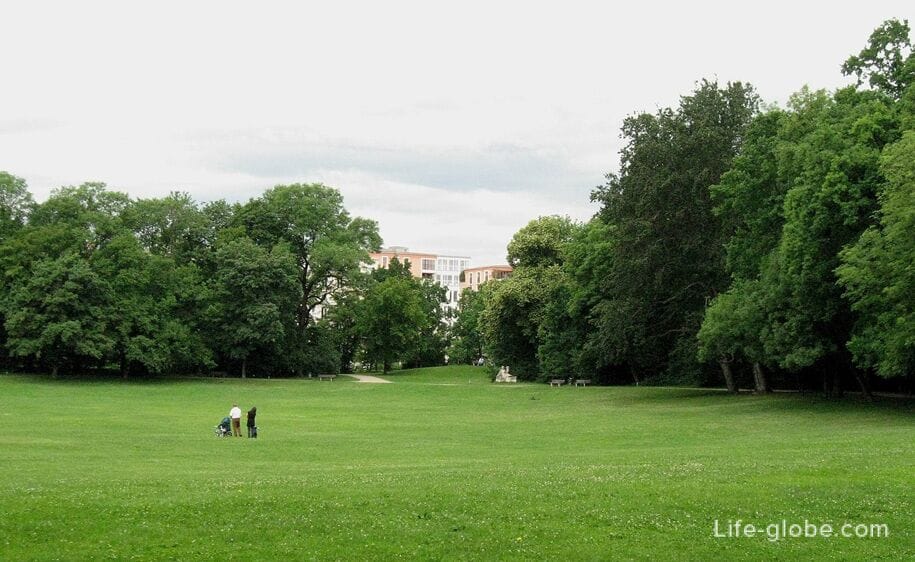
- Riemer Park is a 210-hectare landscape park located on the eastern edge of Munich, in the Trudering-Riem district.
The park was created between 1997-2005 on the territory of the former airport and was awarded the German Prize for Landscape Architecture.
In the park: an artificial lake with swimming areas, a beach volleyball court, walking paths, recreation areas, playgrounds, a skate park.
From the materials left after the demolition of the former airport, artificial hills up to 20 meters high (Rodelhügel) were created in the park, which are now used as places for walking and viewing points, and on snowy winter days-for sledding. Learn more about all the parks in Munich…
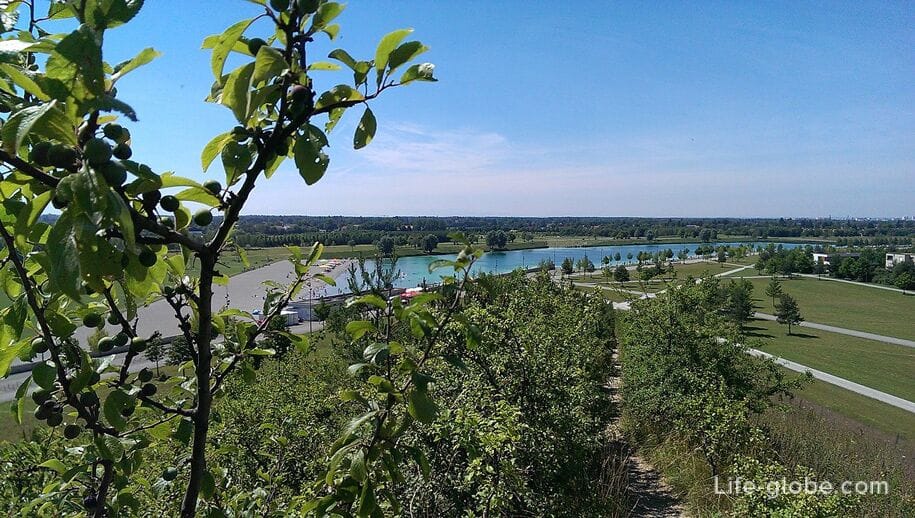
Botanical Garden Munich-Nymphenburg
The Botanical Garden Munich-Nymphenburg (Botanischer Garten München-Nymphenburg) is a botanical garden and arboretum that was established in 1914.
Today, more than 19,000 species and subspecies of plants are grown in the garden, and it also serves to preserve rare plants and European bee species.
The main areas of the botsad include: an alpine garden, an arboretum, a collection of marsh and steppe plants, rhododendrons, a rose garden, a systematic garden, aquatic plants in aquariums, and an extensive greenhouse complex.
Address: Menzinger Str. 65. Website: botmuc.
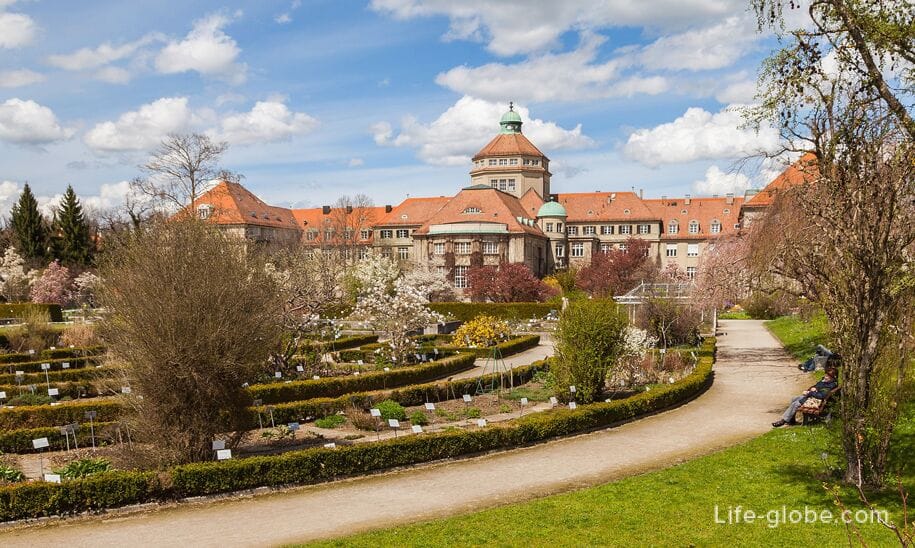
Hellabrunn Zoo
The Hellabrunn Zoo (Münchner Tierpark Hellabrunn) is a geozoo park where animals are housed in spacious enclosures according to their habitat zones: from the Arctic Circle to Africa, from Europe to Asia and from America to Australia.
In the zoo, more than 750 species of animals live in a natural place in the landscape protection zone of the Isara meadows.
Address: 30 Tierparkstrasse. Website: hellabrunn.
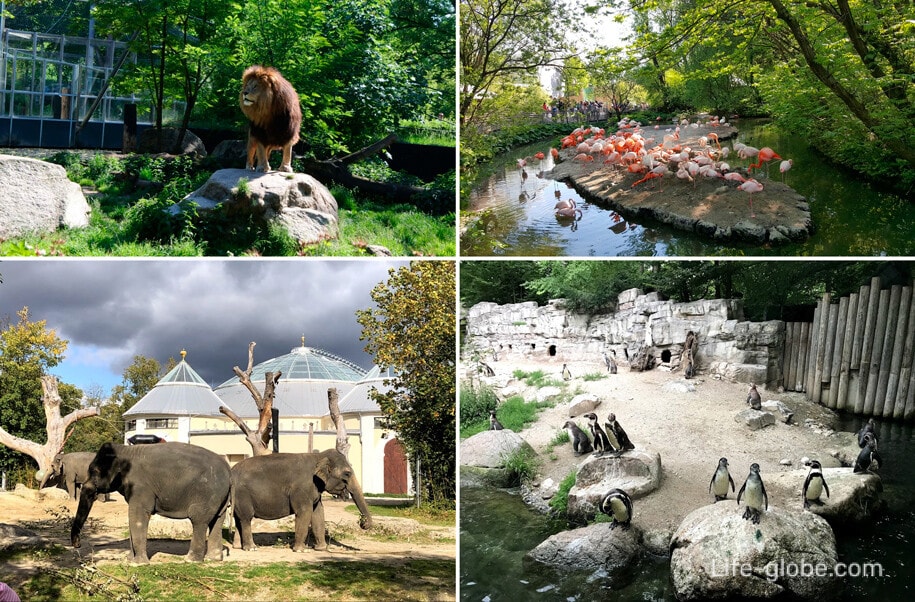
Teresa's Meadow
Near the historic city center, in the Ludwigsvorstadt-Isarvorstadt district (Ludwigsvorstadt-Isarvorstadt) is the Theresienwiese (Theresienwiese), which is the largest venue in Munich for celebrations and festivals, including:
- the world's most famous and largest folk festival (beer festival) - Oktoberfest, which is held annually from the second half of September to the beginning of October;
- in the winter (in December), on the eve of Christmas and New Year, the Tollwood festival takes place in Teresa's Meadow, which includes a Christmas market and cultural events that take place until the New Year's Eve. Learn more about Teresa's Meadow and festivals...
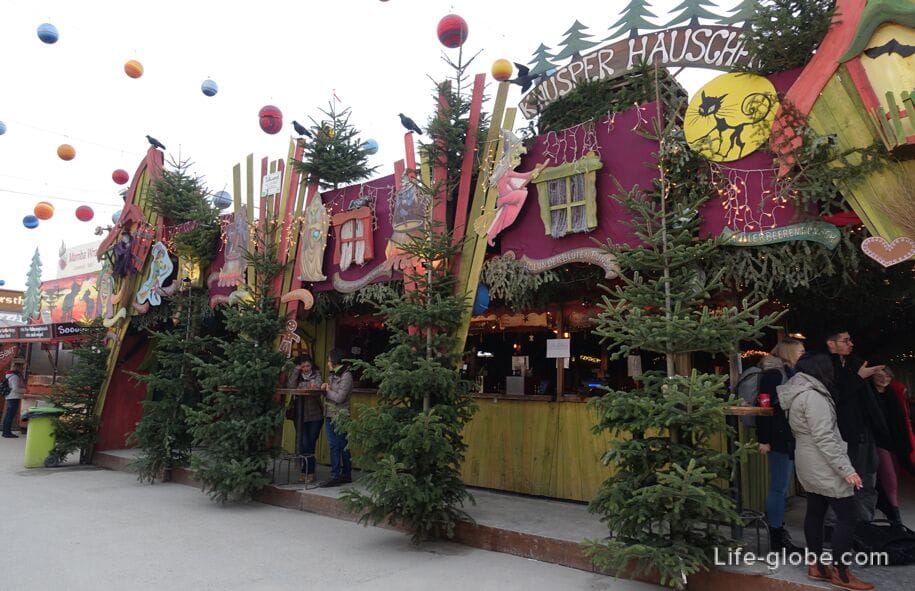
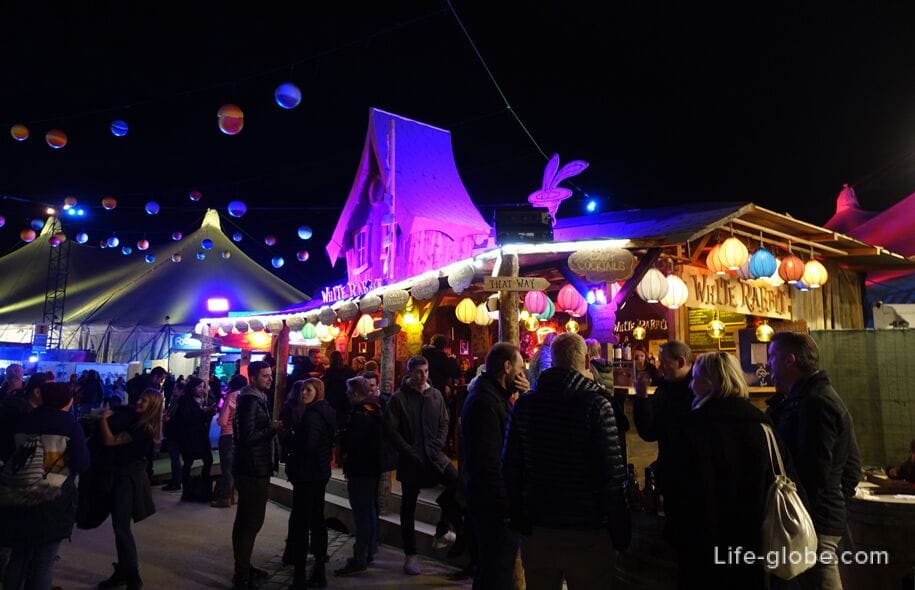
Circus "Krohne"
The circus "Kronebau" (Circus Krone), founded in 1905, is one of the largest and most popular in Europe.
In Munich, the Krohne Circus occupies the building for its winter circus program, which is held every year-traditionally from December to early April. In the remaining months of the year, the circus performs in some European cities, and the circus building in Munich is rented out as a multi-purpose venue for entertainment and corporate events.
Address: 43 Marsstrasse. Website: circus-krone.

Allianz Arena Stadium»
The Allianz Arena is a football stadium and the home ground of the FC Bayern Munich football team, which hosts both local and international matches.
The stadium is widely known for its appearance of "airy" plastic panels and the possibility of external lighting in different colors.
Address: Werner-Heisenberg-Allee, 25 (Werner-Heisenberg-Allee). Website: allianz-arena.
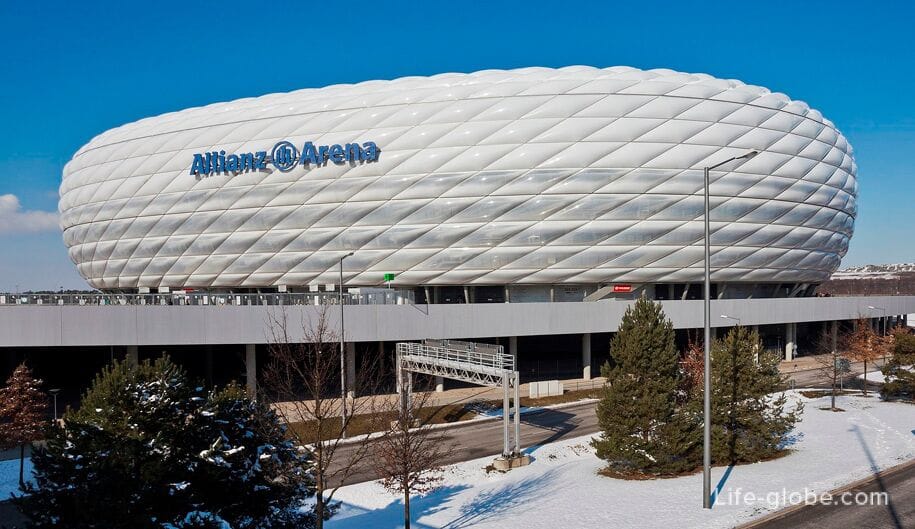
Within the walls of the stadium is the museum of FC Bayern , which tells the story of FC Bayern - from the moment of the foundation of the club in 1900 and up to the present day.
The museum's website: fcbayern.com/museum. Learn more about the stadium and the museum...

Observation decks in Munich
One of the most visited places in Munich is the observation decks and observation points, which offer views of the city and the surrounding area.
Within Munich, there are both paid viewing platforms and free viewing points, as well as view cafes and hotels that offer panoramas of the city:
- circular observation deck in the tower of the New Town Hall on Marienplatz, giving beautiful panoramic views of Munich and the surrounding area, including the Marienplatz square itself and the historic old town. Observation deck paid;
- 360-degree observation deck in the tower of St. Peter's Church (at an altitude of 56 meters). From the observation deck you can enjoy beautiful views of the Marienplatz with the New and Old Town Halls, the old Town and the surrounding area, and in good weather you can see the Alps. Observation deck paid;
- closed area at the top of the south tower of the Frauenkirche. The venue offers views of Munich, including the historic old town. Observation deck paid;
- Prinzregent-Luitpold Terrace, located near the Angel of Peace and overlooking Prinzregentenstrasse and part of the historic center of Munich. The viewing area is free of charge;
- a three-level observation deck located in the Olympic Tower, at an altitude of 185-200 meters.
The lower level of the observation deck is covered, the upper two are open areas.
The observation decks in the Olympic Tower offer the most extensive circular (360-degree) view of the city, including the Olympic Park facilities, the BMW Museum and far beyond Munich. Observation deck paid;
- observation deck at the top Olympic Mountain, located in the Olympic Park. The mountain offers views of the Olympic Park, and the silhouette of the city center is also visible. The viewing room is free of charge;
- observation deck on the Frettmaning Hill (Fröttmaninger Berg), located near the Allianz Arena. The observation deck offers views of the Allianz football arena, the Munich skyline and the surrounding area. Free viewing area;
- observation deck on the Luitpoldhügel hill, located in the north-western part of the Luitpoldpark. The site offers views of the park itself and partly of Munich and the surrounding area. The viewing room is free of charge;
- Monopteros - a rotunda in the Greek style, located on a hill (artificial 15-meter hill) in the southern part of the English Garden (Englischen Garten).
Today, the monopter is, among other things, a viewing platform that is free for everyone to access, with views of the English Garden and the Munich skyline. The viewing room is free of charge;
- a platform at the head of the statue of "Bavaria", from which, through small openings, you can see the Teresa Meadow and the surrounding area.
The observation deck is open to visitors from April to October 15. The ascent to the observation deck is paid;
- circular observation deck, made in the form of a balustrade, located at the top of the main tower of the Church of St. Paul (Kirche St. Paul), at an altitude of 97 meters.
The observation deck offers views of the Therese Meadow, the center of Munich and the surrounding area.
The site is open to visitors during the Oktoberfest. The ascent is paid. Address: St.-Pauls-Platz, 11;
- from the steps and the wall near the Maximilianeum building, you can enjoy views of the Maximiliansbrücke Bridge, Maximilianstrasse and some of the surrounding area. Learn more about observation decks, viewpoints, view restaurants and hotels in Munich…
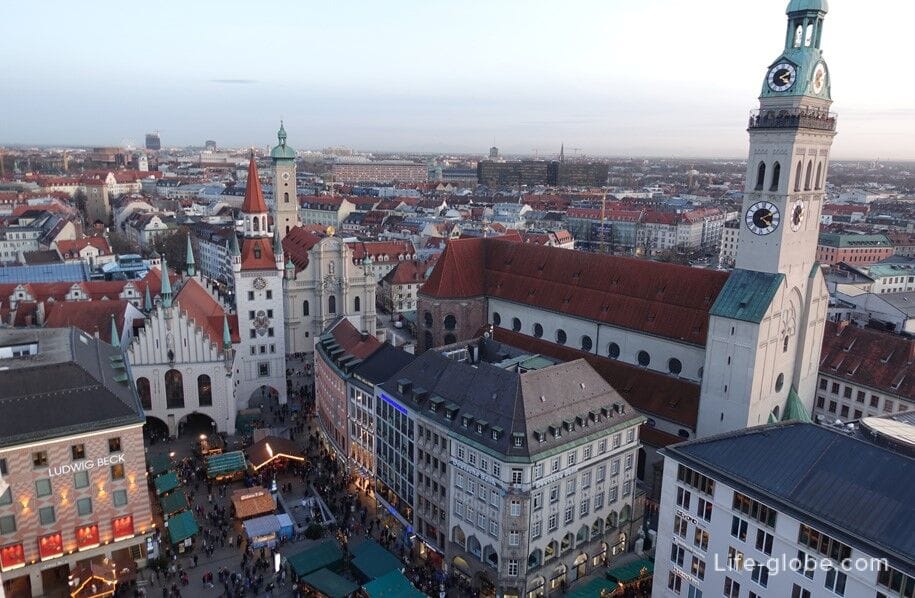
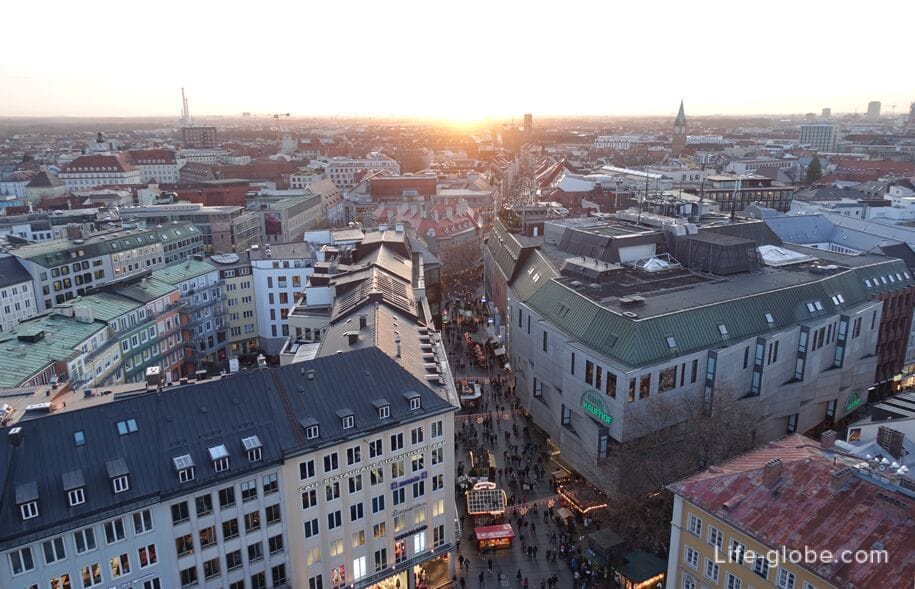
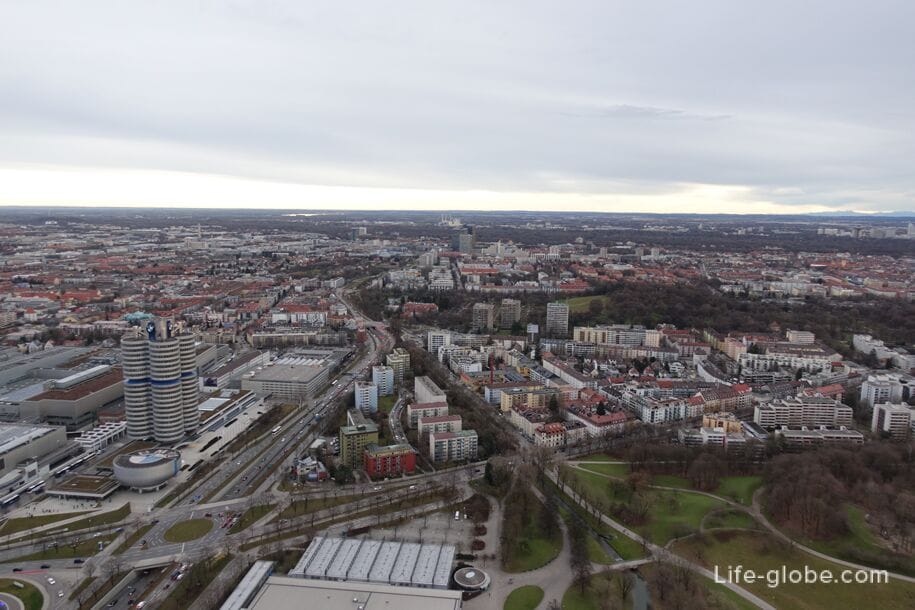
Beer gardens in Munich
Beer garden (Biergarten) - a type of beer restaurant (part of a beer restaurant) in which guests sit outdoors, under shady trees and have the right to bring their own food.
Traditional beer gardens are particularly characteristic in Bavaria.
In Munich, beer gardens operate in restaurants, in which there is also a hall, more often - several halls.
Beer gardens are especially popular during the warmer months of the year. Some beer gardens are only open during the summer months.
In Munich, there are many restaurants and pubs that have beer gardens, from small ones-for a few tables, to those in which the number of seats reaches several thousand. Learn more about beer gardens in Munich with addresses and websites…
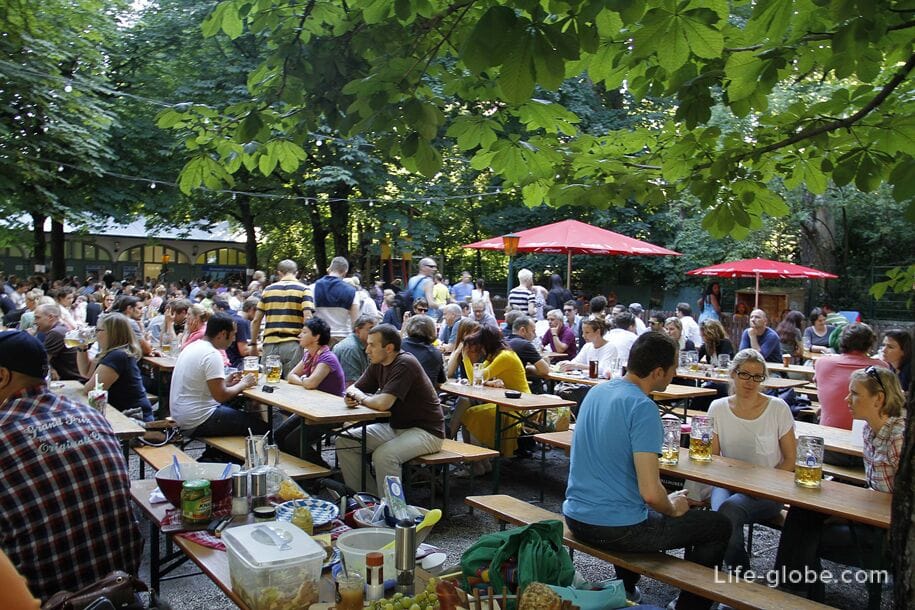
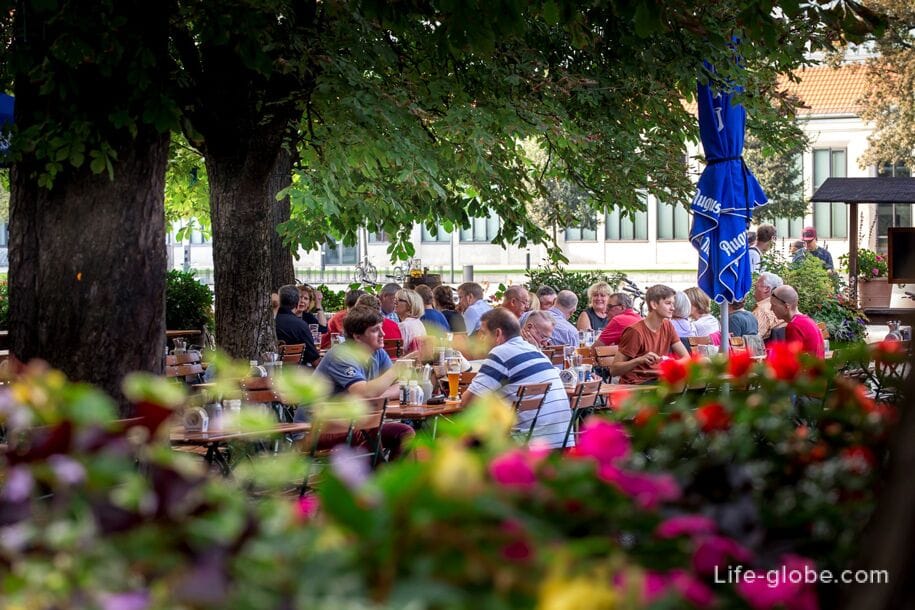
Christmas markets in Munich
On Christmas and New Year's Eve, Munich's Christmas markets (Münchner Weihnachtsmärkte) are one of the most visited places in the city.
At the fairs, there are counters and tents, from which they sell food, including local street food, drinks, the main place among which is occupied by warming mulled wine, Christmas products, as well as souvenirs, products of local craftsmen and festive paraphernalia.
Christmas markets in Munich function both in the old town and outside of it, as well as in the residential and low-tourist areas of Munich. Learn more about Christmas markets in Munich with addresses and websites…

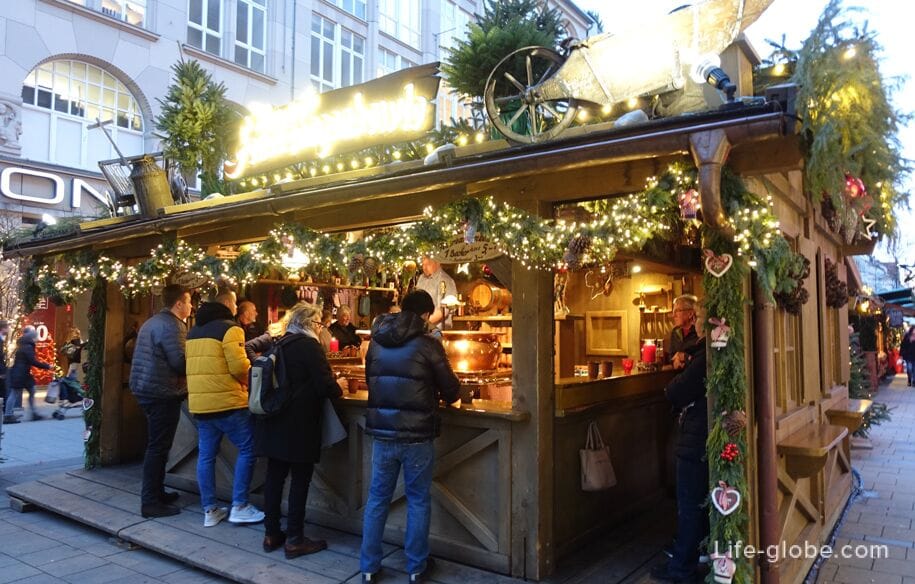
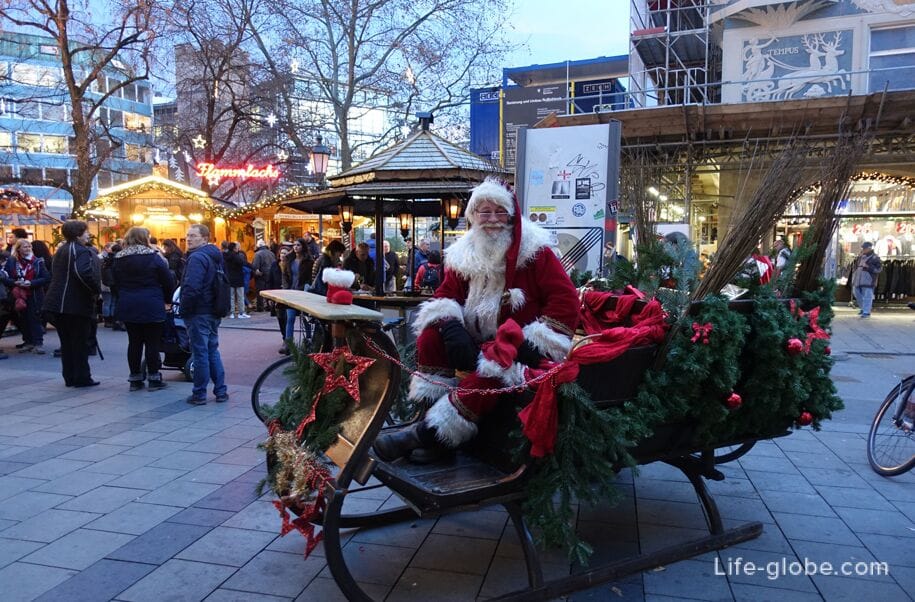
Swimming pools in Munich
Munich has a sufficient number of public swimming pools, including:
- Olympic Swimming pool (Olympia-Schwimmhalle), located in the Olympic Park, atCoubertinpl. 1.
In addition to the main pool and the diving pool, the indoor water complex also includes a children's pool and a regeneration pool (Jacuzzi).
Website: olympia-schwimmhalle;

- Cosima pool (Cosimawellenbad), which is the only Munich pool with waves - 35 by 16 meters.
The pool has: uncle swimmer's tracks, volleyball pool, surf area, springboard, sauna, children's area and water slides, massage services. The outdoor area has sunbathing areas, a heated swimming pool, a children's pool and a playground.
Address: Cosimastrasse 5 (Cosimastrasse). Website: cosima-wellenbad;
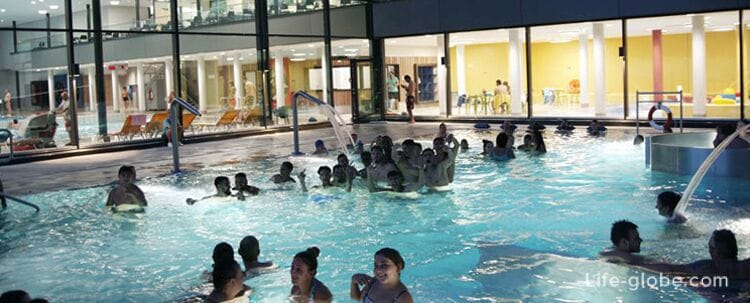
- a swimming pool located in the building of the Prince Regent Stadium (Prinzregentenstadion), which includes: sauna, steam room, swimming pool, yoga studio, wellness center, barber shop and restaurant.
In summer, there are outdoor pools, slides, a lawn and a children's playground. In winter-an ice rink.
Stadium address: Prinzregentenstraße, 80. Website: prinzregentenstadion;
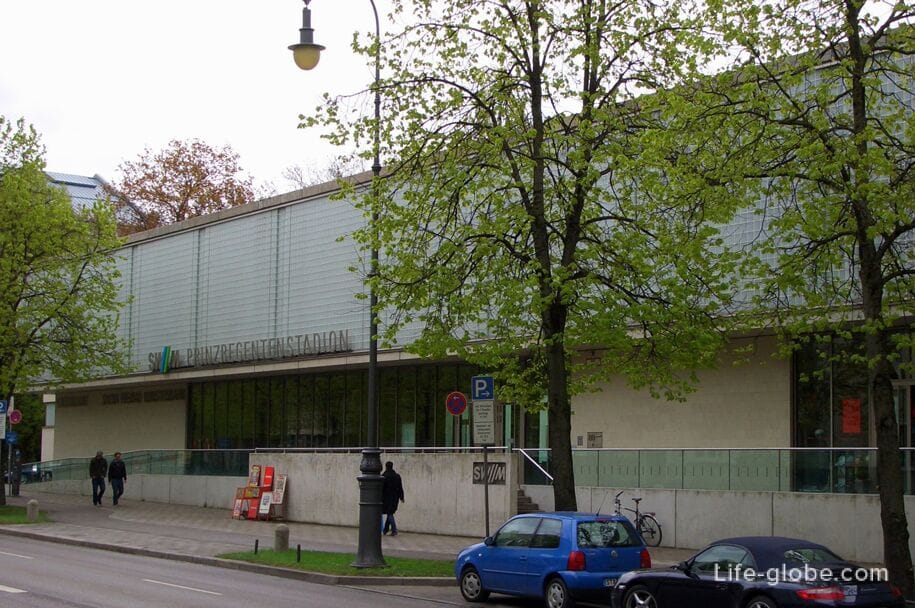
- Muller's City baths (Müller'sches Volksbad), which were built as a public bath complex with a swimming pool in 1901 in the Art Nouveau style with Baroque elements.
Within the walls of the building are now: two indoor swimming pools, a steam bath with an open courtyard, a bistro, a beer restaurant, massage services and a barber shop.
Address: Rosenheimer Starsse, 1 (Rosenheimer Straße). Website: hallenbaeder/volksbad. Learn more about Muller baths...
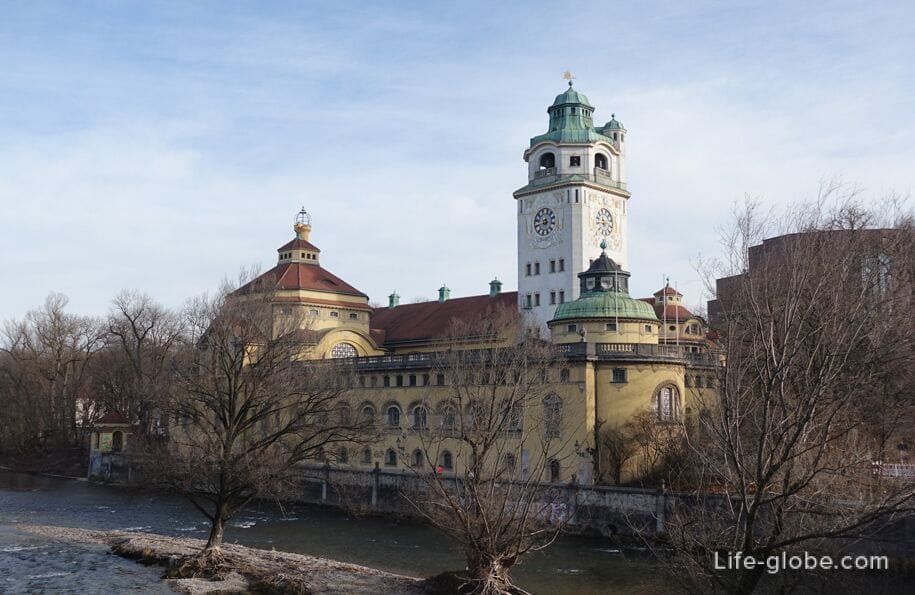
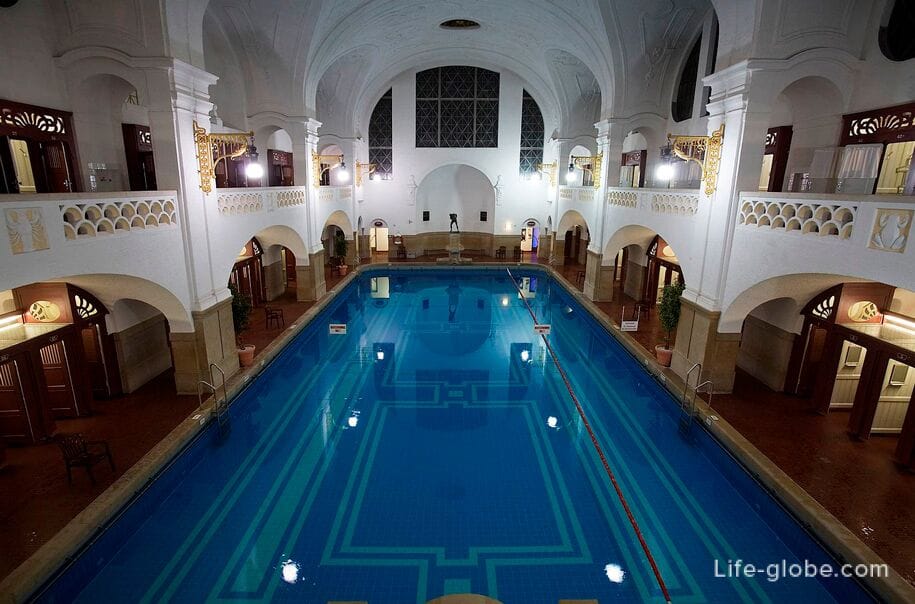
- swimming pool "Dantebad" (Dantebad), which is a public swimming pool complex open to the public, both in summer and winter.
In summer, the complex offers several swimming pools, including a 50-meter swimming pool suitable for competitions, a 30-meter swimming pool with a wide water slide, a pool with attractions and a nudist area with its own 25-meter pool.
In winter, the Dantebad is a warm outdoor 50-meter pool that heats up to about 30°C (in summer, the water temperature in the pool is somewhere around 27 °C).
The complex also includes: sauna, children's playground, green area with sun loungers, table tennis.
Address: Postillonstrasse 17 (Postillonstrasse). Website: dante-freibad.
For more information about all swimming pools in Munich (indoor and outdoor), click here.

Guided tours of Munich and beyond
To get acquainted with Munich, to walk around the city, its main attractions and hidden little-known places, as well as to go outside of Munich, you can take one of the excursions:
Sightseeing buses
Munich is served by Hop On - Hop Off tour buses with an audio guide, which have several routes and tours, and stop, among other things, near the most important sights of the city.
Sites: stadtrundfahrten-muenchen and citysightseeing-munich.
Bus tickets can also be purchased here:
In the vicinity of Munich and in Bavaria
Nearby points of interest include golf courses. In the warmer months of the year, you can enjoy relaxing by the rivers and lakes of Bavaria, go windsurfing or go hiking along the picturesque mountain trails.
In winter, there is a great opportunity to combine walking in Munich with visiting the ski resorts. For example, in Bavaria: Garmisch - Partenkirchen, Mittenwald, Bayrischzell, Lenggries, Oberammergau, etc.
You can also go to neighboring countries: Austria (Innsbruck, Salzburg, Vienna), Czech Republic (Prague, Karlovy Vary, Cesky Krumlov), Liechtenstein, Switzerland, etc.
Near Munich in either: the grünwald castle (Burg Grünwald); Studio Bavaria film (Bavaria Filmstadt), which can take a tour; a planetarium and a community center "ESO Supernova"; forest the Perlacher (Perlacher Forst), which is an artificially created hill - mountain "in the Perlacher Muggle" (Perlacher Mugl), with panoramic views, etc.
Castles and towns in Bavaria
South-west of Munich (almost on the border with Austria) there are castles that are considered the brightest gems of " old " Bavaria: the mountain castle of Neuschwanstein (Schloss Neuschwanstein), the neo-Gothic castle of Hohenschwangau (Schloss Hohenschwangau), the Hohes Schloss (Hohes Schloss) and the miniature palace of the Linderchs (Schloss Linderhof).
You can visit these castles on your own, preferably by car (rent a car in Munich→).
Also in Bavaria are: Oldenburgsky castle (Residenzschloss Altenburg); Palace of Herrenchiemsee (Herrenchiemsee Neues Schloss), are located on the Herren island (Herreninsel); Hohenaschau castle (Schloss Hohenaschau); Wildenwart castle (Schloß Wildenwart); a set of Burghausen castle (Burg zu Burghausen); Neuburg castle (Schloss Neuburg an der Donau); New castle (Neues Schloss); Trausnitz fortress (Burg Trausnitz); Kloster Ettal (Benediktinerabtei Ettal); memorial Dachau; Legoland (LEGOLAND Feriendorf) and so on.
In addition, you can enjoy the nature of the Alps and visit the charming towns and picturesque villages of Bavaria. For example: the Berchtesgaden Nature Reserve (Nationalpark Berchtesgaden) with the Royal Lake (Königssee), the popular panoramic site of Bavaria - "Eagle's Nest" and the Berchtesgaden salt mine (Salzbergwerk Berchtesgaden); the top of the Zugspitze (Zugspitze); the city of Bamberg; the city of Nuremberg (Nürnberg); Rosenheim; Memmingen; Mittenwald; the village of Oberammergau; as if descended from the pages of a fairy tale-the town of Rothenburg an der Tauber (Rothenburg ob der Tauber), etc.
Excursions from Munich:
Holidays and festivals in Munich
Oktoberfest is a folk festival, also known as the beer festival, which is held from the second half of September to the beginning of October at the Teresa Meadow.
Christmas markets, which are held throughout the city, traditionally - from the 20th of November to 22-24 December inclusive.
At the beginning of the year-dancing market women during the carnival season (on the Viktualienmarkt).
Ash Wednesday-traditional purse washing in the fish fountain on Marienplatz.
In February-March (around St. Joseph's Day) - the festival of "strong beer", which is celebrated by various events in the city.
The Festival of Culture and Family takes place on May 1 at Marienplatz.
They also celebrate such holidays as: city day (Munich's birthday), St. Patrick's Day, Tollwood festivals, film festivals, various music, theater, dance, sports and other festivals.
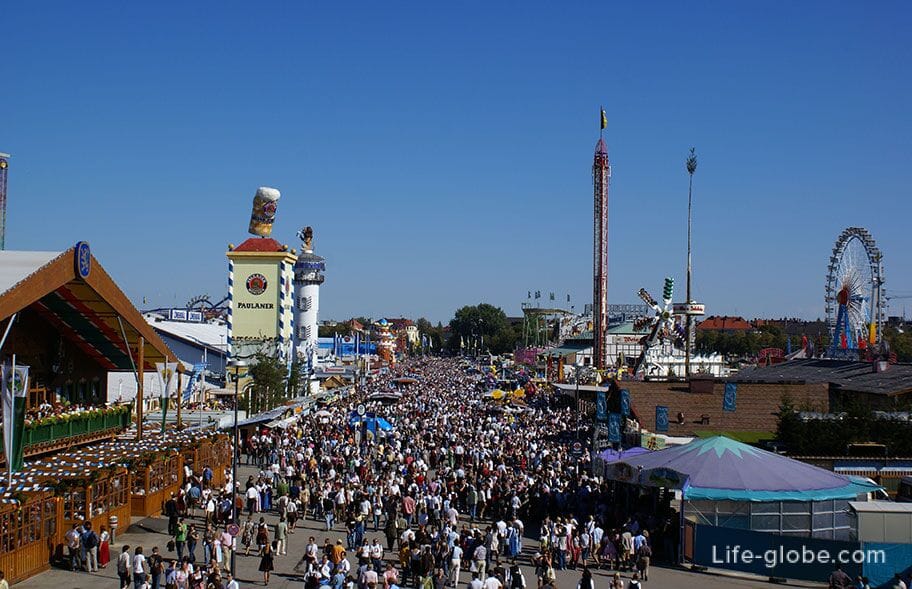
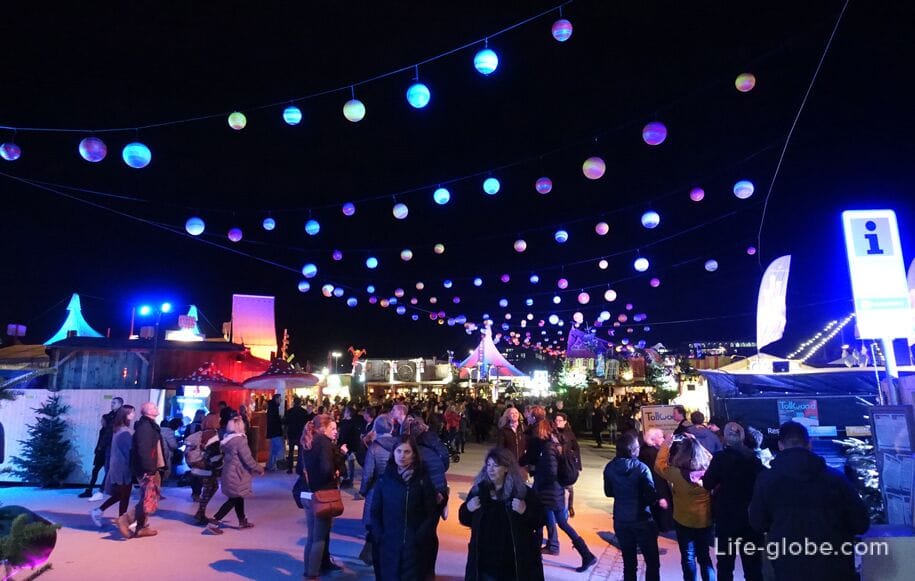
How to get to Munich
Near Munich is the international airport named after Franz Josef Strauss (Flughafen München "Franz Josef Strauß"), which connects Munich and Germany as a whole with many cities in Europe. Flights to Munich →
From Munich Airport to the city center can be reached:
- public transport:
- commuter trains (trains) of lines S1 and S8,
- Lufthansa Aeroexpress bus»;
- taxi. You can order a taxi/transfer in advance, even from home. At any time of the day, at the airport, a driver will be waiting for you with a sign where your first and last name will be written. To order a taxi, just provide your flight details!
- car. The most convenient way to travel independently in Bavaria and Germany is by car. You can rent a car in advance, even from home. The car will be waiting for you immediately upon arrival. Cars for rent can be viewed and booked here →
You can fly to Memmingen International Airport (Flughafen Memmingen), which is located 111 kilometers from the center of Munich. The airport regularly receives and sends flights of such budget airlines as Ryanair and Wizzair.
From Memmingen Airport, you can reach Munich by car, taxi or public buses. From the center of Memmingen - by train, taxi, car or bus.
FlixBus buses from Memmingen to Munich (from Munich to Memmingen) →
You can get to Munich (as well as from Munich) from many European cities by bus, including the FlixBus company. You can view all bus directions and buy a ticket here →.
There are three railway stations in Munich: the Main Railway Station (Munich Central Station / München Hauptbahnhof), the Eastern Railway Station (Bahnhof München Ost) and the Munich-Pasing railway station (West / Bahnhof München-Pasing), which receive daily trains from major cities in Europe and Germany itself. There are also several train stations in Munich. You can view train directions and buy a ticket here →
The choice of accommodation in Munich is very diverse - from budget guest houses and apartments, to 5-star hotels located both in the historical center of the city, near the River Isar and the Therese Meadow, and more remote from them.
All accommodation options in Munich can be viewed and booked here
Currency
Germany is a member of the euro area. The currency of the country is Euro (€). Both cash and bank cards are accepted in many shops, cafes and restaurants.
In some catering establishments (restaurants, pubs), to be able to pay with a bank card, you need an invoice amount of a certain amount - not infrequently from 20-40 euros.
Transport in Munich
The public transport network in Munich is well developed.
The basis of public transport is the network of fast trains (Schnellbahnnetz), consisting of the city electric train (S-Bahn) and the metro (U-Bahn).
In addition, the city has a well-developed network of bus and tram routes.
Munich on the map





